How To Travel Long Distances with Multiple Cats
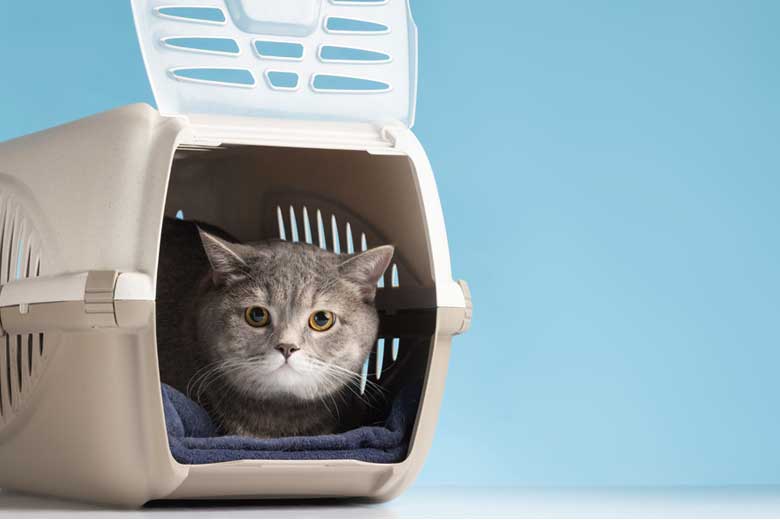
We know that all cat parents consider their kitties to be part of their families. If you are planning to travel long distances because of holidays, your new job, or because of family reasons, in this article you will find answers to all your questions.

Do you really need to travel long distances with a kitty?
Valuing their own comfort and security, surrounded by familiar scents and sounds, any travel – even a short vet visit – can be a big deal for fluffy balls and can cause unnecessary stress. Studies on cats’ transportation show that travelling can cause stress in pets, and thus needs to be well considered.
If you are planning vacations and thinking as to whether to travel long distances with your fluffy ball, you can consider alternatives to long distance travel such as engaging your friends or other family members to take care of the kitty, or rehoming them, finding a pet-sitter, or arranging the cat’s stay in a boarding facility. Pet parents need to consider all situations and solutions, particularly when their cat is in their golden age, has health-related issues that need to be under control, is pregnant, or their age is less than 8 months.
YOU MIGHT BE INTERESTED IN: Checklists for cat sitters in Meowpassion shop on Etsy
Travelling long distances – essential guide
When deciding on travelling long distances with cats, careful preparation, planning and management are always required to minimize stress in cats, any disease transition and ensure your pet’s comfort.
Tip#1 – always check the distance and how many hours you might need to reach your final destination. After 6 hours of drive, it is recommended to have a 1-hour stop to enable your kitty to go about their business, feeding and drinking. If you continue your drive for longer than 6 hours, then you need to have an 11-hour rest before your next journey.
If you will be travelling with kittens, then you can drive 7 hours maximum with a 2-hour stop. As research indicates, a midway stop provides rest by decreasing cortisol and thus lowering stress levels in pets.
Tip#2 – you need to know where cat-friendly (pet-friendly) hotels are while you will be travelling, if they impose any additional fees per cat, or if they charge per night or the whole stay, so you can understand how expensive a hotel will be if you stay there with multiple cats.
Tip#3 – before the trip visit your vet to take precautions if your cat suffers from chronic diseases or is in their golden age. You can also ask advice about sedatives to help your pet during the long journey.
Tip#4 – emergencies on the road or during travel might occur, and you might need to consult or visit a vet while you will be travelling with your cats. Check out vet emergency services available on your route, have a copy of, or take with you, your cat’s documentation such as health and vaccines records and/or certificates
Tip#5 – if you are moving to another state, country, or internationally you need to recognise the local laws and legal requirements as vaccination and tests might vary. If your kitty will need any vaccinations, plan your vet visit to be done a minimum 3-5 days before the planned journey.
Tip#6 – if your fluffy friend suffers from car sickness, avoid feeding your pet for 3-4 hours before your trip.
Tip#7– test drive your cat and take occasional rides to get them familiar with the carrier and adapt to travelling in cars.
Tip#8 – prepare a list of food and other supplies you need to have while travelling long distances with cats, and buy them in advance.

Tip#9 – while travelling long distances the person who your kitties are most attached to should stay as close to them as possible.
Tip#10 – control the temperature in the car, particularly if you are driving in large SUVs. Sun might come in the windows, so a pet will be hot even though the air conditioning is on. When you travel long distances during hot seasons, increase the number of midway stops so that you can take them for a walk in parks or other shady places.
Tip#12 – invest in a well-constructed, well-ventilated and leak-proof carrier. A great feature to have in the carrier is many pockets where cat owners can pack essential items they can access easily any time during the journey. When purchasing the carrier, it is important to remember that:
- your pet must be completely inside it, will feel comfortable to move, stand, sit, turn around, stretch, and rest. The recommended carrier size is 1.5 times your cat’s size;
- a divider is helpful when you want to transport two cats and divide their space;
- a pet owner needs to know the maximum acceptable dimensions of a carrier if they will be travelling by plane;
- all elements of the carrier must be durable;
- the carrier is an investment as a good one provides extra security for your kitty;
- pet owners can easily latch and unlatch the top, and the sound of snapping cannot be loud and scary to the pet;
- the carrier should be easy to clean, cozy, and comfortable for the pet;
- multiple doors are nice-to-have so everyone has a variety of ways to help a pet without removing it from the carrier;
- the carrier should be cat-friendly, particularly if they are veterans.
Tip#12 – pet owners can also choose a larger crate that will have a litter box and a bed in it.
Tip#13 – in most cases it is better to transport cats in separate carriers (singly).
Tip#14 – it’s a well-known fact that cats do love boxes, which are not a safe option throughout the journey as pets can chew them and it’s difficult to clean up the mess.
Tip#15 – according to the research undertaken by Bristol University, cats feel less stressed when their bedding, washable mat, or towel is present in the carrier. A carrier with a towel or bedding in the bottom (you can spray it with Feliway approximately 30 min before you place your kitty in the carrier – more details here) allows pets to feel cozy and be surrounded by familiar scents.
By having a pad inside the carrier, pet owners can also control and clean the carrier easily if a pet urinates, gets carsick and vomits, or defecates.
Tip#16 – to make trips less stressful, prior carrier training can be helpful.
Tip#17– while preparing for your journey, always check the carrier for holes and its zippers.
Tip#18 – secure the carriers with seat belts in the car. Even if your kitty is a great traveler, it is safe to keep them in the carrier for long distances. If an accident happens, your 4-legged friend can escape, be injured, get lost and won’t know what to do in the unknown surroundings.
Tip#19 – your pet will feel more relaxed having their favorite toys, blanket, or other belongings, with them during the travel.
Tip#20 – packing to be ready for all potential situations is better than under-packing. An absorbent pad, plastic bags, paper towels or baby wipes for cleaning up will be helpful in unexpected situations during the journey.
If you are travelling by plane, make sure all items meet TSA standards.
Other helpful items to take might be:
- collapsible silicone bowls for food and water
- a large bag of Premium cat food
- big plastic dog dishes to be used as litter pans
- bottles of water
Tip#21 – the kitty’s carrier should be labeled with their name, as well as the owner’s and vet’s names, and should include emergency contact information.
Tip#22 – if you are travelling inside your country or internationally by plane, you need to research the policies and specific rules set by your airline, as well as the requirements of your destination.
Final thoughts
Travelling with your fluffy friend by car or plane can be stressful for all sides involved, but sometimes you cannot avoid it. If you get all the information in advance, plan and prepare your journey to fit your cat’s personality and follow the above guidelines, then your kitty will become your travel companion who enjoys travelling long distances with their owners.
*FTC Disclosure: This page contains affiliate links. If you make a purchase after clicking on the links, Meowpassion will get a small commission at no extra cost to you. We are dedicated to finding the coolest products for cats, cat owners and lovers, and we never recommend anything that we don’t love or trust.
meowpassion
Team Cat-aholics! We're here to share our love for all things feline, from fluffy tails to whisker twirls. Our passion for cats is like no other, and we're on a mission to bring you the most comprehensive, heartwarming, and informative content about our beloved whiskered companions.
Tuxedo Cat Personality
How to take care of your cat while you’re on vacation.
Didn't find what you need? Use the search!
Pet Keen is reader-supported. When you buy via links on our site, we may earn an affiliate commission at no cost to you. Learn more .
How to Travel With Two Cats: 12 Expert Tips
Traveling can be stressful on a good day but attempting to travel with two cats can feel a lot like, well, herding cats. It’s important for the comfort and safety of your cats, as well as yourself, to be thoroughly prepared for the trip before attempting to travel with your cats. Otherwise, you may end up with a lost cat, a mess in your car, or a cat causing an accident.
To make things simpler and safer for yourself and your cats, check out these tips on traveling with two kitties.
The 12 Tips to Travel With Two Cats
- 1. Plan Ahead
Don’t attempt to go on a trip with two cats without doing plenty of planning. This will vary based on how you are traveling, though. If you are planning to drive with your cats, then you’ll need to have your route laid out ahead of time so you can plan for places to stop with your cats.
Not every hotel or motel will take two cats in a room, so if your trip is going to extend across multiple days, then you need to have places to stay selected before you go. It’s also best to identify what veterinary care may be available along your route, just in case.
Air travel with pets is a whole other animal. There are very specific rules and requirements that you need to be aware of if you’re attempting to fly with both of your cats. International travel rules are even more stringent than travel within the US, so check the requirements multiple times to make sure you don’t miss anything.
- 2. Make Sure Everything Is Updated
One of the most important things you can do for your cats before any type of travel with them is to ensure that all their records are updated. This entails making sure they are up to date on all necessary vaccinations, including those needed for the place you’re taking them to. Have printed records of everything on you at all times during travel.
You also need to make sure to have their microchip information fully updated with your contact information. Unfortunately, it’s not uncommon for pets to get loose during travel, which can be extremely dangerous for them. If one or both of your cats gets loose while traveling, you want to make sure whoever finds them will be able to contact you with no issues. The last thing anyone wants is for their pets to go to a shelter or be adopted by another family.
- 3. Get the Right Carriers
When it comes to traveling with cats, any old carrier just won’t do. You need to select carriers that are extremely secure while still allowing your cat some space to move around. If you’re flying with your cats, the airline will have very specific regulations regarding the size and type of carriers you have your cats in, and the regulations are typically different if your cat is flying in the cabin or in cargo.
One thing that many people get wrong about traveling with two pets is putting them in a carrier together. While some cats may be comforted by the presence of their companion, it is usually safest and most comfortable for your cats to have their own carriers.
When kept together in high-stress situations, cats may become aggressive or react fearfully, which can lead to fights or injuries to one or both cats. Keeping them in one carrier also increases the risk of them bumping against each other during travel.
- 4. Talk to Your Vet
Even if you’re moving away, your vet needs to know that you’ll be traveling with your cats. They will be able to give you guidance, records, and medications if necessary. Cats can benefit from anti-anxiety medications during travel, but these should only be given under the direction of a veterinarian.
While you may know how your cat will act on a quick trip to the vet, you likely don’t know how they’ll respond to things like long stretches of time in the car or flying on an airplane.
Your vet will also be able to ensure that your cats are healthy enough and set for the trip. Some cats just are not well enough to travel, in which case you may need to find other arrangements for your cat. Your vet will give your cats a thorough exam and review their records, making sure you have enough medications that your cats may require for their medical conditions.
If you are moving, your vet is likely to give you enough medication to cover a couple of months, so you have time to get established with a vet at your new home.
- 5. Withhold Food if Needed
Some kitties, like people, get car sick. Some cats will experience nausea any time they are in the car, while others may only experience it when in the car for an extended period. While anti-nausea medications from the vet can help with car sickness, you can also help settle your cats’ tummies by withholding food for 3–4 hours prior to the trip.
Don’t plan to withhold food for extended periods like you would for a surgical procedure, though. Having an empty tummy may also result in your cat experiencing nausea and discomfort. Feed your cat a meal a few hours before you plan to leave but avoid feeding food or treats just before the trip.
- 6. Practice with the Carrier
One of the ways you can help your cats be more comfortable during the trip is by getting them used to their carriers well in advance. You can start by having the carriers out in the open so your cats get used to seeing them and they take on some of the smells your cats are familiar with. As time goes on, you can start encouraging your cats to enter the carriers by offering treats or putting their toys or bedding in them.
Eventually, your cats will be ready to go for a few “test drives” in their carriers. This can be a quick drive around the block, but it will help your cats get used to the feeling of being in the carrier and the movement of a vehicle. Try to increase the length of the drives your cats experience in the carrier to help prepare them for a longer trip.
- 7. Always Crate While Driving
It may be tempting to take one or both of your cats out of the carriers during your trip. After all, it feels like everyone would be comforted by a little snuggle, or you may think that your curious cat will want to sniff around the car.
Unfortunately, it’s extremely unsafe to have a cat loose in a moving vehicle . You should also consider securing the carriers with seat belts or tie-downs.
Cats that aren’t used to traveling may panic once out of the carrier, which can result in them injuring themselves or causing a major driving distraction. If your cat hurts the driver or gets in the way of the pedals, they may also cause a car accident.
It’s also unsafe for your cats to be loose in the car in the case of an accident. A carrier will ensure your cats don’t become projectiles in the event of a car accident. A major accident with a loose cat in the car can result in serious injury.
- 8. Leashes May Be Necessary
If you’re one of the people who has tried to leash train your cats, then you likely realize how tough this can be. Most cats will get comfortable using a leash and harness with enough time and training, but some cats will not tolerate it, regardless of what you try. When traveling with your cats, though, leashes and harnesses may become necessary .
This isn’t because your cats should be loose or leashed while the car is moving, though. If at any point you expect to have your cats out of their carriers anywhere but inside of a hotel room, then they should be leashed. All it takes is one person opening a car door or window for your cat to jump out and get lost or hurt.
Even if your cats seem calm, they are at a huge risk of escaping during travel. If you have any plans to take your cats out of their carriers at any point during the trip except inside an enclosed room, then they should be at least somewhat comfortable wearing a harness and a leash.
Finding a great cat harness can be tricky. Our favorite is Hepper's Cat Harness & Leash Set , which includes a soft, adjustable velvet harness and a premium climbing rope leash.
With safety features like quick-release buckles, reflective stripes, and reinforced stitching, you'll love this machine-washable harness as much as your cat will!
At Pet Keen, we've admired Hepper for many years, and decided to take a controlling ownership interest so that we could benefit from the outstanding designs of this cool company!
- 9. Make the Carriers Comfy and Hygienic
It’s often recommended to include something in each cat’s carrier that will help them feel safe and secure. This can be bedding, a piece of your clothing, or toys they enjoy. Aim to make the carrier as comfortable as possible for each cat, though. Providing crate mats is a good way to add a layer of cushion without adding excess bedding.
Remember that, if flying, there are restrictions on what you can have in your cats’ carriers, and that excess bedding poses a suffocation risk during air travel.
It’s also a good idea to provide each cat with a litter box or a pee pad in the carrier. Accidents do happen when cats are stressed, and it’s also possible that your trip will be longer than your cat can hold it. You don’t want your cat stuck lying in their own urine or feces during the trip, though.
Absorbent pads or the option to use a litter box can reduce the risk of this happening. Of course, adding a litter box to the carriers, even if small, will require a decently sized carrier.
- 10. Check and Double Check Closures
Before you set out, don’t just check the closures on your cats’ carriers once. Check them multiple times. Sometimes, a crate lock of some kind will be necessary to ensure your cats’ carriers stay secure throughout the trip. Some zippers may be able to be forced open from the inside of the carrier, while other types of closures may come loose with too much movement.
If your cats will be in fabric or soft carriers, then you should check these thoroughly to ensure there are no holes, tears, or broken closures. These carriers are typically less secure than plastic or metal carriers, so extra care should be taken to ensure their security.
- 11. Pack Extras
When traveling with cats, you should plan to overpack rather than under-pack. If you are flying, you will be asked to include food and food and water bowls for your cats. If traveling by car , it’s still advisable to have these things available. Offer water at various points throughout your trip, and food is great to have on hand during travel by car as well.
Make sure to include any other extras that may be needed. Extra blankets, towels, and pee pads are often a necessity. Extra litter and cleaning supplies are great items to have within arm’s reach during travel.
You should also ensure you have extras of your cats’ records. Make multiple copies, keeping at least one copy with you all the time.
- 12. Promote Calmness
Traveling with both of your cats is likely going to be stressful for you, no matter how easily the planning and trip go. Cats are usually very in tune with your feelings, though, which means your stress can lead to stress for your cats. Try to keep everyone calm and level during the packing and the trip itself.
Speak in a calm voice in a normal tone, try not to slam things around while packing, and aim to make the car as comfortable as possible for car trips. You should also consider the soundtrack of your trip and how you can use it as a calming tool. Loud music and movies may cause extra stress for your kitties, while quiet, soothing sounds may help calm them.
Traveling with both of your cats isn’t going to be an easy task, but it can be done successfully and safely with proper planning. Don’t go into your trip blind, though. You need to be fully prepared before you even purchase carriers for your cats.
It will take work to make a trip safe and calm for your cats, but you can pull it off. Just remember to do everything you can to keep your cats safe and secure during the trip.
- See also: How to Fly With a Cat: 7 Vet-Approved Tips for a Smooth Flight
Featured Image Credit: RODNAE Productions, Pexels
Brooke Billingsley
Related articles
120 most popular cat names that start with t: terrific names for your feline friend, 6 diy cat cone collars you can make at home (with pictures).
Search our database of over 16753 posts with up-to-date information from our experts and veterinarians.
Want to talk to a vet online?
Whether you have concerns about your dog, cat, or other pet, trained vets have the answers!
Hepper is reader-supported. When you buy via links on our site, we may earn an affiliate commission at no cost to you. Learn more .
How to Travel With Two Cats: 7 Vet-Reviewed Tips
By Chelsie Fraser
Updated on Apr 26, 2024
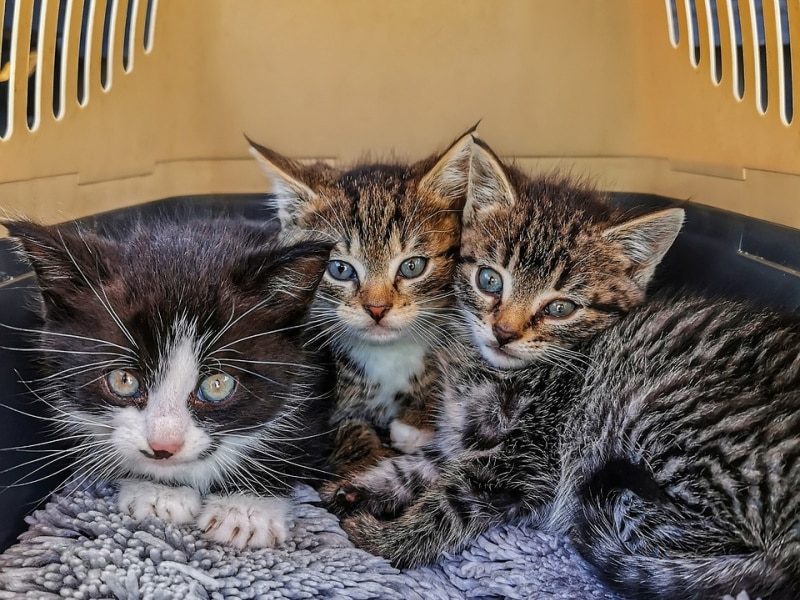
Vet approved
Reviewed & Fact-Checked By
Dr. Lauren Demos
DVM (Veterinarian)
The information is current and up-to-date in accordance with the latest veterinarian research.
There’s no better vacation than one where you can take your pets with you. After all, they’re part of the family. However, there are extra things to plan for and consider when taking your cat on a trip. If you have two cats, it’s even more important to have everything that you need for the trip to go smoothly. Here, we go over tips for traveling with two cats to help you make the best of your trip.
The 7 Tips on Traveling With Two Cats
1. bring along your cats’ favorite toys and treats.
You should pack plenty of treats and toys to keep your cat distracted, busy, and happy during your travels. The longer the trip, the more important this is.
Regardless of your mode of travel, your kitties are likely to be in their carriers for long periods, so make sure their toys are in there with them. Push treats through the door at regular intervals to reinforce good behavior.
It’s a good idea to pack a collar and leash for each cat. Even if they are used to the carrier, you’ll have to take them out at some point. Don’t rely on your cat to stay safe in your arms. They can spook and escape when you least expect it. If you have your cat on a leash, you’ll have a hold on them at all times.
2. Consider your mode of transportation carefully
When traveling with cats, it’s important to consider which mode of transportation you are going to use.
If you’re traveling by car, make sure your cats have enough food and water. If it’s a long trip, it’s often easier to keep food and water in front of them at all times. Consider bringing extra water bottles, so your cat doesn’t get thirsty on the road.
If you plan on flying with both of your kitties in tow, be sure their carriers comply with airline regulations before booking your flights. Use the biggest carrier size that you are allowed. The more space they have with adequate ventilation and light, the better your cats will feel during travel.
Leaving your cat in the carrier for long periods can be stressful and lead to behavior problems if they get nervous being confined.
It’s also important not to leave your cats in the car unattended, especially during warm weather. Temperatures inside a car can rise quickly when parked in direct sunlight.
3. Make sure your cats are comfortable in their carriers
Spend the time making sure your cats are accustomed to being in their carriers before going on a trip.
Unless the carrier is large, it’s best to use a separate carrier for each cat, regardless of your method of travel. The more space they have, the more comfortable they will be. If you are traveling by air, you will be required to keep your cats separate. Make sure you spend time getting them used to being alone in their respective careers to avoid it being too stressful.
If you are traveling by car and your cats are well-bonded, you can consider using a large carrier with both cats inside . You’ll need to ensure that both of them can lie down and stretch out comfortably simultaneously.
4. Take rest breaks
When driving for long periods of time, make frequent rest stops, and allow your cats to stretch their legs. You’ll also want to make sure you are stopping for bathroom breaks. Many cats won’t use their litter box during travel, even if one is available in their carrier.
5. Bring extra litter boxes
If you’re driving, bring a separate litter box for each cat for the duration of the trip. Make sure they are easily accessible for them to use. If you’re flying with cats, check with your airline about their animal-carrying policies and whether they allow passengers to transport food and litter onboard the plane.
6. Make sure hotels are cat friendly
Book cat-friendly hotels ahead of time, and become familiar with their pet policies. Call the hotel before leaving, and ensure that you have everything that you need to keep your cat happy while also following the hotel guidelines.
It’s a good idea to check Google or TripAdvisor for reviews from other hotel patrons. Ask as many questions as possible about how pets are treated at the hotel. Are there extra charges for pets? Are pets allowed in beds or on furniture? Are they required to be secured in carriers when you are out of the room?
Knowing what to expect will help ensure that things go smoothly when traveling with two cats.
7. Be attentive to your cats’ needs
To travel successfully with two cats, you need to be attentive to their needs. On long trips , for instance, stop for exercise breaks. Rotate toys and treats to prevent boredom . Cover their carriers with a blanket for extra security. Be aware of the car temperature to keep them comfortable.
Final Thoughts
Traveling with two cats can be challenging, but being prepared will help make your trip successful . Practicing ahead of time can go a long way toward making your cats comfortable with travel before a long trip. Always take extra supplies and plenty of breaks to stretch their legs . These tips can help make your trip as comfortable and enjoyable as possible.
Featured Image Credit: guvo59, Pixabay
Related Articles
Further Reading
How to Get Rid of Cat Pee Outside: 7 Effective Methods
Apr 22, 2024 - 7 min read
How Many Litter Boxes Per Cat Should You Have? Facts & FAQ
Feb 14, 2024 - 3 min read
Cuddly Kitten Day 2024: When Is & How to Celebrate
Jan 17, 2024 - 5 min read
Vet Articles
Latest Vet Answers
The latest veterinarians' answers to questions from our database
Dog Ear Hair Plucking: Our Vet Answers Concerns & Alternatives
Answered by Dr. Karyn Kanowski, BVSc MRCVS (Vet)
What to Feed Betta Fish Fry: Our Vet’s Feeding Guide & Growth Tips!
Answered by Dr. Luqman Javed, DVM (Vet)
How Should I Introduce My Puppy to a Dominant Dog?
Answered by Dr. Joanna Woodnutt, BVM BVS (Vet)
Dog Stung by a Scorpion? Our Vet Explains What to Do
Answered by Dr. Maria Zayas
Can a Dog Take Metronidazole Without Food?
Answered by Dr. Kim Podlecki, DVM (Vet)
7 Neurological Issues in Dogs & Common Signs to Keep in Mind (Vet Approved)
Answered by Dr. Chantal Villeneuve, MS BVetMed (Vet)
Cat food recalls
Have a cat? Stay on top of cat food recalls here >
Dog food recalls
Have a dog? Stay on top of dog food recalls here >
Have a question? talk to a vet online for advice >


- Too many ads? Join our community of cat lovers now to reduce ads by 90%! Click here to join for free!
Traveling With Cats [Your Ultimate Guide & 36 Game-Changing Tips]
Ever wondered about jet-setting with your beloved pet cat but didn't quite know how to go about it? Well, your worry ends here. We've tapped into the expertise of Sally Smith, the revered Founder and President of Companion Pet Enterprises. Together we have created a detailed guide for traveling with cats. We also bring you 36 invaluable tips shared by our community members over the years.
We'll cover topics like prepping your precious cat for car or plane travel and understanding the paperwork and health checks required for interstate or international travel. We will also provide practical tips on acclimating your cat to the carrier and making the journey comfortable.
But that's not it. We dive deeper into what professional pet transporters bring to the table, especially for more complex moves. Get insights into their licensing, security programs, and the whole gamut of services they provide.
Keep reading and uncover the wealth of information tucked away in this guide. Your cat's travel worries will soon be a thing of the past!
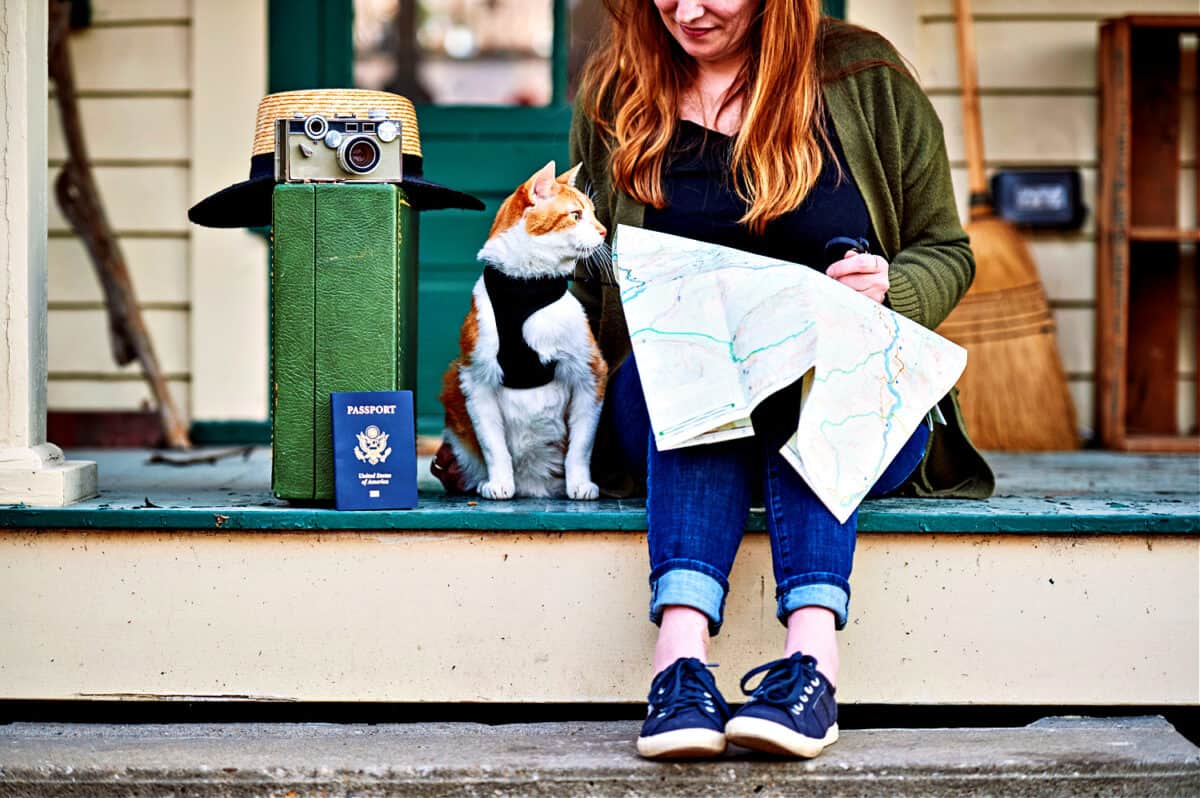
Traveling With Your Cat: Car Or Plane?
There are only two ways to move pets, by car or by plane. For interstate travel or travel to a neighboring country like Canada, your cat should first be examined by a veterinarian and have a health certificate issued prior to travel.
At border crossings, you may be asked if you have a certificate. If you are unable to produce one, they will hold you up a bit, while you answer all the questions as to why you were not prepared.
Traveling cross-country by vehicle requires quite a bit of time versus air travel. Some additional requirements for longer trips need to be considered:
Let Fluffy get acclimated and friendly with the cat carrier. Leave it open with bedding in it, in the room she is most comfortable in. Once the initial apprehension dissipates, kitty curiosity can take over.
If it looks inviting, is safe (meaning the door is propped open), and has treats inside, Fluffy should investigate it in her own time. If she does not, put her inside for a few minutes, then let her out.
Short interludes where nothing happens will help alleviate the fear of the carrier. Don't force her inside. If she shows any reluctance, stand the carrier on end with the door open and scruff Fluffy gently and lower her inside.
Close the door quickly behind her; gently lower the carrier to a normal position keeping her inside for just a few moments, then release her.
In order to prevent escape or accidents on the road, cats should always be transported in a carrier. To keep her calmer, if you are only going a short distance, you can alleviate some of the stress (if it is not a really hot day) and cover the carrier with a dark cloth.

How To Survive Long-Distance Travel With Cats
But for longer trips here are some easy tips to follow:
Planned Rest Stops
Stopping not only gives the driver a break, but also offers you the opportunity to check on your cat, and offer her the use of a litter box and a drink.
Before you open up the carrier, be sure all doors and windows in the car are closed. Let Fluffy out of the carrier, with the litter box on the seat or floor near the carrier, but don't be surprised if she won't use it.
Let her walk around a little bit before returning her to the carrier, but don't let her get underneath your seat where she will be hard to reach.
Time Your Trips
Plan to travel no longer than 7 or 8 hours (most cats can wait to relieve themselves for that period of time) and the box can be then offered in the safety of a hotel room. If your cat is prone to motion sickness, don't offer her any food while she is in motion.
Find Pet-Friendly Accommodations
Schedule your trip around hotels that accept pets. Call ahead of time to find out if the hotel or motel is pet-friendly. Several books and Internet sites serve as guides for pet-loving accommodations.
Have An Escape Plan: Keep identification tags on your pet. In the event of an escape, the person finding the cat will know whom to contact. Consider leaving a temporary tag with your cell phone number on it, just in case. Also, microchip your pet. Microchips provide universal protection.
Offer A Comfort Zone
If your cat dislikes auto travel of any length or tends to become car sick, speak with your veterinarian about using Dramamine or a similar product to control nausea. A product like Benadryl can make the cat sleepy without the dangers of tranquilization; however, do not use these products without your vet's recommendation.
Short & Sweet
Prior to the trip, take short trips with your kitty in the carrier around the block or to a local store. Plan to return home before the anxiety or motion sickness starts.
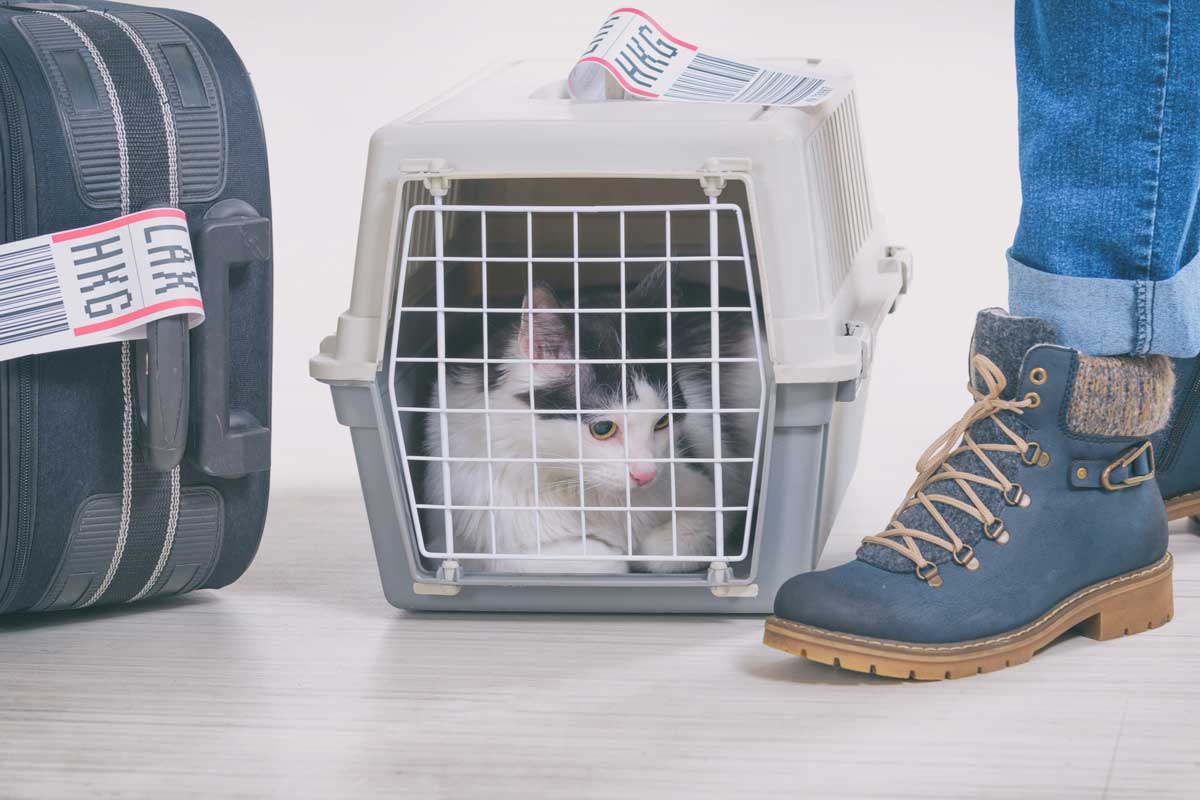
Travel By Air
Don't be surprised if you encounter difficulty booking your cat's travel. The Federal Aviation Administration has made security changes since the terrorist attacks that affect how pets are shipped.
Professional pet transporters have the necessary licenses to move pets with the airlines, but only a few airlines will currently still deal directly with the public. Depending on the airline, one or two cats may be allowed in the cabin as a carry-on or can be booked as excess baggage with you on the same flight in the cargo area of the plane.
Many people worry about the safety of their pets during air travel. According to airline estimates, nearly two million pets a year are shipped.
Each year there will be one or two well-publicized accidents to cause concern, but actual airline statistics report less than 30 animal injuries or deaths per year. Most accidents happen due to poor planning, improper crates, tranquilization, or human error. Sometimes things are truly an accident with no one to blame (unless the pet itself is to blame!).
Whether you have help from a professional or do it yourself, certain requirements for air travel need to be met.
Follow The Rules
An airline-approved shipping crate is required. For travel in the cabin, a soft-sided carrier may be used. But for travel as cargo or in the baggage area, the crate must be plastic with a metal door. It should be big enough for the cat to sit up, turn around and lie down.
The less expensive carriers are not the safest. The higher-priced crates are made of sturdier fiberglass, rather than plastic, and have stronger doors that will not fly open.
Each crate must be labeled with live animal stickers, consignee information, feeding instructions, and two dishes attached to the door. These are federal regulations that must be met.
Provide Timely Proof
Every cat needs a health certificate and proof of rabies vaccine. The Animal Welfare Act says the health certificate must be dated no more than 10 days prior to the trip. If it expires a new one will be required.
Say No To Drugs
The American Veterinary Medical Association and the Independent Pet and Animal Transportation Association do not recommend tranquilizing your cat for flying. It is now widely recognized that tranquilizers are the number one cause of illness and death in pets shipped by air.
Several airlines will now also refuse to accept a tranquilized pet. Better to have a pet soil the crate, but arrive safe and sound.
Travel by air is stressful no doubt, but healthy pets survive a few hours of travel quite nicely. Pad the bottom of the carrier with plastic diapers (padding turned up) to help absorb any accidents that might occur.
Weather Restrictions: Understanding Potential Delays
Excessive heat and cold can prohibit pet shipments. Each airline can put an embargo in place to prevent moving a pet when it is less than 45 degrees, or more than 85 degrees at either end or at any stop along the way if they will be exposed to these temperatures for more than 45 minutes.
Professional pet transporters and airlines must abide by these federal regulations. Therefore, even if you have your cat booked to go with you as excess baggage, temperatures may prohibit it from traveling on that day. This is for the health and safety of your pet.
Planning And Alleviating Travel Stress
Planning and common sense can alleviate most of the problems encountered when traveling with your cat. Fluffy may never love traveling, but you can help make it easier. For more complex moves the use of a professional pet transporter for air travel is not the least expensive alternative but maybe the best choice when moving the cat yourself becomes overwhelming.
The Benefits Of Professional Pet Shippers
Professional pet shippers are licensed by the USDA for interstate travel and have a TSA-approved security program. They will handle all the documents for arrangements with the airline and meet the FAA/TSA requirements.
Comprehensive Assistance: Before And After The Journey
If you must travel to the destination before you can send for your pet, oftentimes pet transporters can assist you with obtaining health certificates, veterinary requirements, or boarding.
They will be able to provide shipping crates as well as pick-up and delivery services from home to the airport.
A network of transport specialists may also even allow for a transporter to meet Fluffy upon arrival and deliver her to your new home. Most, but not all, transporters can assist with international relocations.
Navigating International Travel: Dealing With Unique Country Requirements
Each country has its own requirements for pets entering the country. In some instances, only a health certificate is required along with proof of a rabies vaccine. In other countries, it may be a long involved process requiring months of planning and or quarantine once Fluffy arrives.
These transporters are always knowledgeable about these rules and restrictions, after all, that is how they make their living.
SIGN UP FOR THECATSITE'S EMAIL UPDATES >
Keep Reading For Our 36 Actionable Tips Below!
Written by Sally Smith
Sally Smith is the Founder and the President of Companion Pet Enterprises, a pet transportation company and company dedicated to advising and helping others in how to move their pets both domestically and internationally. Smith is diversified in skills throughout the pet industry.
Working as a vet tech, animal groomer, and designing a pet care facility that offered all services in one fell swoop including pet transportation, she became the Director there for over 12 years. Her diversified background has allowed her to hold several positions among them serving on the boards for the New Jersey Veterinary Technicians and Assistants, the Independent Pet and Animal Transportation Assoc. and the American Boarding Kennels Association.
Her current clients consist of Microsoft, Johnson & Johnson, and Continental among others. She shares her experiences willingly and wrote this article in an effort to help all involved- the cat, the cat owner, and the transportation companies.
36 Actionable Tips By Our Members
Most cats are not good travelers. They like having their familiar established territory and couldn't care less about seeing the wonders of the Great Beyond. You're not very likely to ever come across a cat sticking its head out the window with its ears flapping in the wind...
But sometimes long-distance traveling with cats is inevitable. If a 20-minute car journey to the vet is a loud vocal nightmare, the prospect of spending long hours on the road with cats in the car can be absolutely terrifying.
Don't lose hope though. People do take their cats on long car trips and you can too.
Here's a collection of thirty-six tips, provided by TCS (TheCatSite.com) members over the years, that will help make road-tripping with cats safer and less stressful.
![travelling with 2 cats Ginger cat walking out of blue cage, Traveling With Cats [Inc. 36 actionable tips]](https://thecatsite.com/c/wp-content/uploads/2011/11/Ginger-cat-walking-out-of-blue-cage-1.jpg)
Expert Tips And Wisdom For Road Trips With Your Furry Friends
On calming composure: tip #1.
Embody tranquility. Remember, cats are astute in sensing human stress. Avoid displaying signs of distress, like raised voices, to ensure their comfort.
The Journey Adjustment: Tip #2
Patience pays. Your cat may need an hour or so to relax in the new environment. A little howling during shorter trips doesn't necessarily translate into a whole day's worth of commotion.
Familiarity and Routine: Tip #3
Habituation helps. Gradually introducing travel routines to kittens or young cats can ease them into long journeys. However, with older cats, avoid adding unnecessary stress with new training.
Securing The Path: Safety Measures For Road Trips With Cats
The carrier rule: tip #4.
Have your cats in a large carrier or dog crate during the entire duration of the drive. Having a cat loose in the car is dangerous to both cats and humans. Road safety first ! The driver should not have to deal with a cat squirming between the pedals or blocking the view of the windshield.
Harness And Leash: Tip #5
Cats should always wear a harness while in the car. Whenever they are removed from their crate or carrier, a leash needs to be securely clipped onto the harness. Train your cats to wear a harness in advance .
Window And Door Safety: Tip #6
Preventive measures are key. Keep cats securely harnessed and leashed before opening any doors or windows.
Rest Stop Routines: Tip #7
Cautious pit stops. Avoid letting cats out during stops unless they are well-trained to walk securely on a harness and leash.
Identity Protection: Tip #8
Have your cats properly ID'd. Their harness should have a name tag with your current mobile phone number on it. Microchipping your cat is also a good idea.
Medication Consultation: Tip #9
Prescription principles. Before medicating your cat for the trip, ensure you consult with your vet. Certain over-the-counter calming agents may not be cat-friendly.
Trial Runs For Medication: Tip #10
Homeward testing. In case of medicating as per vet advice, first, try it at home to check for any adverse reactions.
Ventilation And Temperature Control: Tip #11
Comfort in climate. Ensure your cats are placed in a well-ventilated area of the car, not exposed to strong winds or extreme temperatures.
Unattended Warning: Tip #12
Attention required. Never leave your cats unattended in the car, especially on days of extreme temperatures.
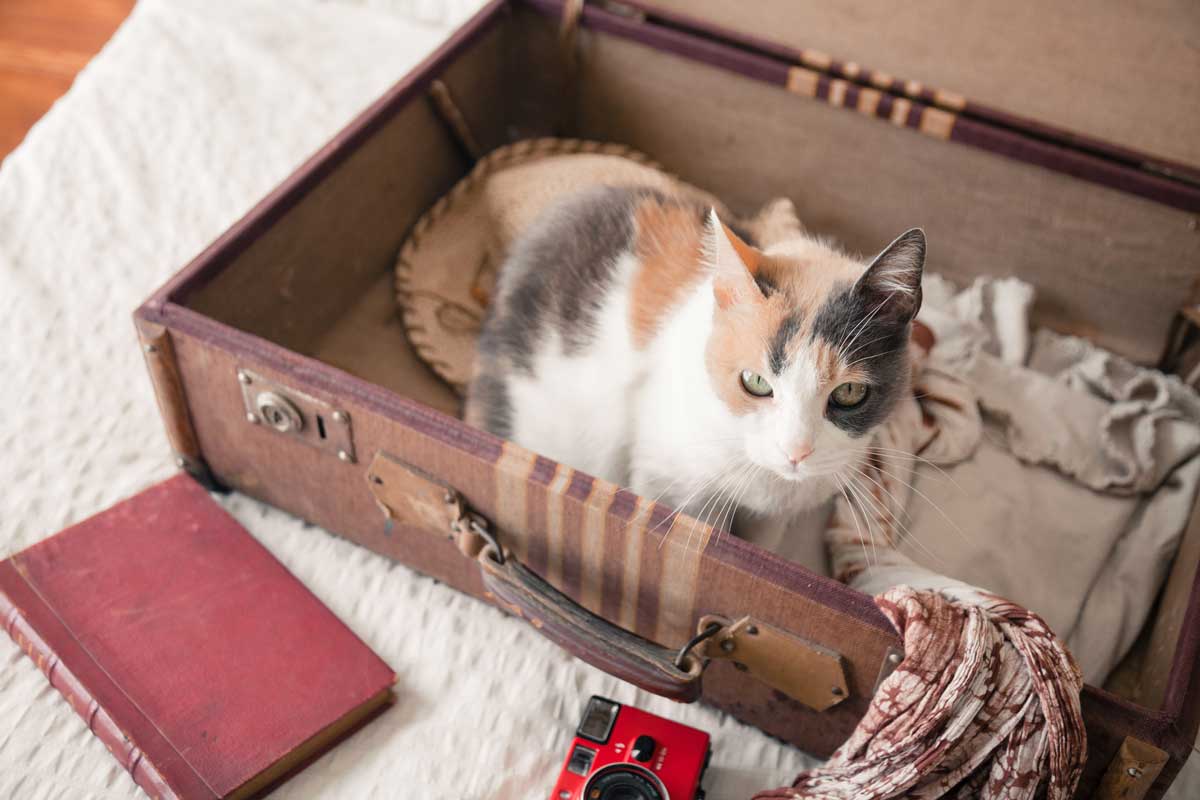
Crafting Comfort: Setting Up A Homely Environment For Cats
Crate comfort: tip #13.
Give your cats room to stretch and move around. Opt for very large carriers, and preferably dog crates.
Car Play: Tip #14
If possible, cage a section of your vehicle and make that into the kitty playpen. Just make absolutely sure no doors or windows in that area can be opened by mistake.
Multiple Cats: Tip #15
If you use large dog crates, you can place more than one cat in each crate, provided the cats get along well with each other.
Vertical Space: Tip #16
Make the most of the vertical dimension of the crate by hanging a cat shelf inside it.
Privacy: Tip #17
Drape a sheet over the cage or crate, leaving one side open. This will make the cats feel more secure, as well as protect them from direct sunlight coming through the car windows.
Accident Prevention: Tip #18
Line the crate with pee pads, in case you have any accidents. Carry extras with you.
Familiar Scents: Tip #19
Place familiar blankets and cushions in the crate.
Cozy Comforts: Tip #20
Place a worn tee shirt of yours in the crate for the cats to have your scent around them.
Calming Scents: Tip #21
Consider using Feliway - spray the crates or use a diffuser in the car.

Click Here To See This Product On Amazon
Cat Toys: Tip #22
Take a few cat toys and rotate along the way. This is especially effective with kittens. Don't be offended if your cat avoids playing.
Road Tripping With Cats: Food, Drink, and Litterboxes
Cat entertainment: tip #22.
Many cats do not eat, drink, or poop while on the road. Don't be alarmed by this, and just patiently wait for your final stop at the hotel.
Disposable Litter Box: Tip #24
Keep a small disposable litter pan in the crate. You can use aluminum baking pans and bring along a supply that will last for the duration of the trip.
Handling Accidents: Tip #25
Have wipes and strong plastic bags handy at all times, to handle litter box accidents.
Water Bowl: Tip #26
If you keep a water bowl in the crate, make sure it's deep and put very little water in it. You want to avoid spillage as the car turns and sways.
Alternatives For Water: Tip #27
Consider training your cats to use rabbit water bottles prior to the trip. You can do that by using chicken broth (no onions or garlic in it!) and some water in the bottle or rubbing their favorite moist cat food near the tip of the bottle. If they learn how to drink from that, it's a great way to make water available without risking wetting the bottom of the crate.
Food & Water Timing: Tip #28
If you prefer, you can limit water and food and provide them only during breaks, once every 4-5 hours.
Car Sick Cat: Tip #29
If your cat tends to get car sick, it's best to avoid feeding 2-3 hours prior to travel. You can feed them at night at the hotel. Many cats don't eat and drink during car trips anyway.
Foods: Tip #30
Only provide food your cats are familiar with and tolerate well. This almost goes without saying, but don't try new treats or pamper them with expensive foods that they'd never tried before.
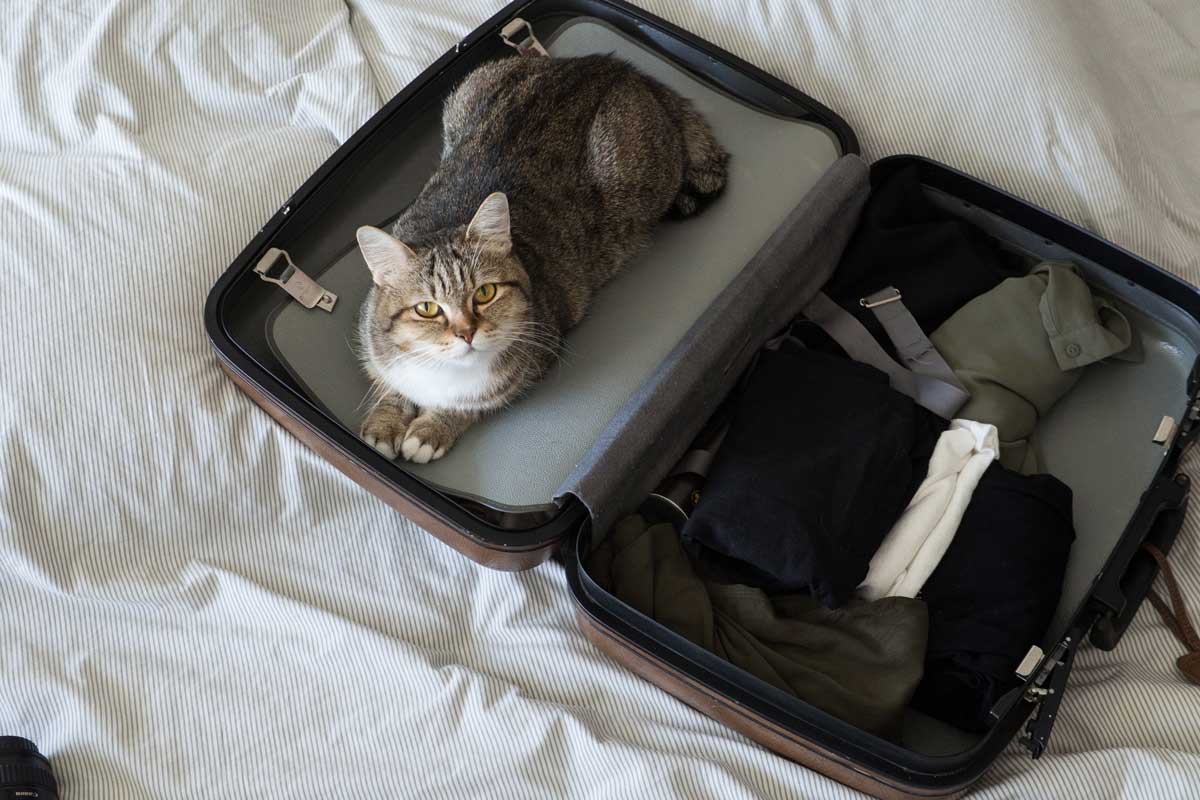
Beyond The Drive: Extra Tips For Road Trips With Cats
Planning accommodation: tip #31.
If your trip is more than a day long, plan ahead for accommodation. Many motels and hotels are pet-friendly, though some ask for extra fees. Most Super 8's and all Motel 6's are pet-friendly. Call in advance to make sure they have room for you and your kitties.
Travel Documentation: Tip #32
Have vet paperwork handy for crossing state lines or borders between countries. Papers are rarely needed for crossing state borders, but at the very least, have proof of your cat being current on her rabies shots.
Handling Cat Communication: Tip #33
Don't let the meowing get to you. Most cats meow like crazy when they get on the road. Most also settle down after an hour at the most and go to sleep. You need to focus on safe driving and ignore the cries.
Driving Sensitivity: Tip #34
Keep your driving relaxed. Don't overtake unless absolutely necessary and take it easy when pulling out. Remember that cats are sensitive to acceleration, deceleration, and sideways motions. Changes in altitude may also affect your cats.
Traveling With Company: Tip #35
If possible, travel with a passenger that can help you take care of the cats.
Safety Awareness: Tip #36
Make sure any travelers are fully aware of safety issues and know not to open any doors or windows unless all cats are properly secured.
Wrapping Up: Journeying With Your Beloved Feline Companions
Navigating the open road with your treasured feline friends doesn't need to be a daunting task. This comprehensive guide has empowered you with the essential tools and knowledge for a smooth and stress-free journey.
Armed with these actionable insights, you're ready for your road trip, ensuring an enjoyable and memorable journey for you and your feline companion. May every mile be a stride toward making precious memories, and may the road always lead you both safely home. Happy travels!
Comments? Leave them using the comment section below. Questions? Please use the cat forums for those!
![travelling with 2 cats Ginger cat walking out of blue cage, Traveling With Cats [Inc. 36 actionable tips]](https://thecatsite.com/c/wp-content/uploads/2011/11/Traveling-With-Cats-Inc.-36-actionable-tips.jpg)
Note: We may get commissions for purchases made through links on this page.
Related Posts

How To Brush Your Cat’s Teeth [Step By Step Guide]
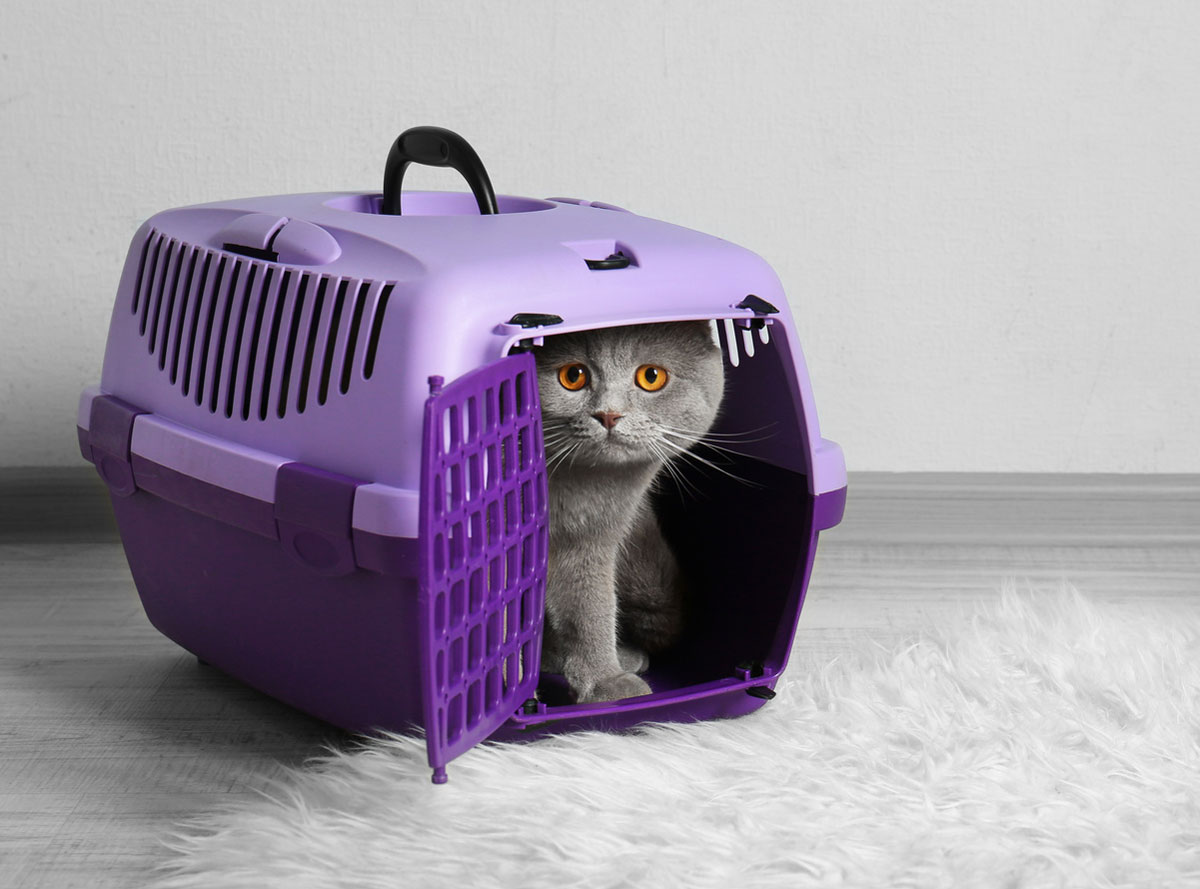
9 Tips That Will Help Your Kitten Adapt To A New Apartment or House

Cat Collars Safety Guide
2 comments on “ traveling with cats [your ultimate guide & 36 game-changing tips] ”.
Leave a Reply Cancel reply
Your email address will not be published. Required fields are marked *
Save my name, email, and website in this browser for the next time I comment.
Members online
Share this page.

How to Take Two Cats on a Plane? A Step-by-Step Guide
Charles Lane
31 August 2023
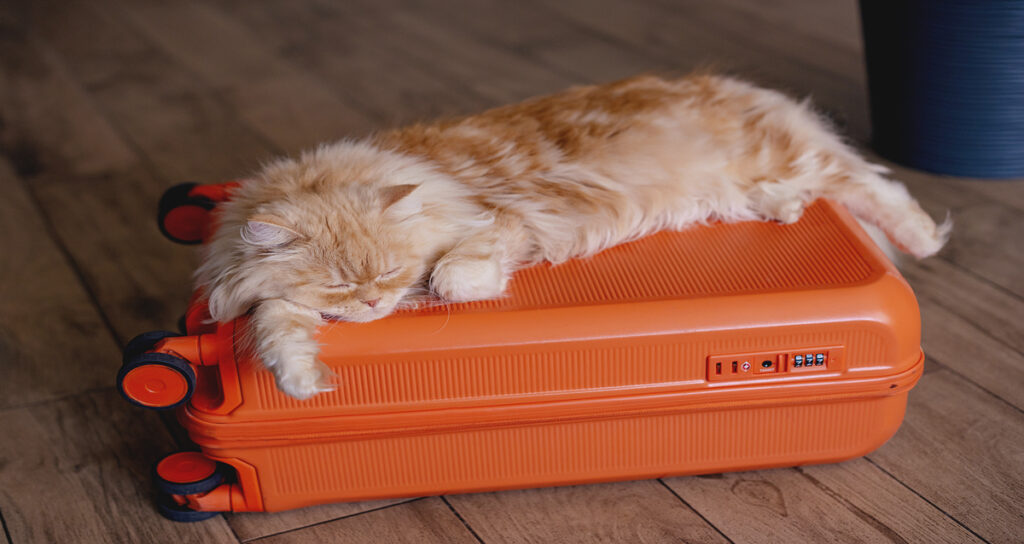
in this guide we will discuss in detail how to Take Two Cats on a Plane? Preparing to fly with two cats in a cabin can feel daunting for first-time pet owners. But with proper planning and preparation, you can ensure a smooth, comfortable air travel experience for you and your feline companions. This comprehensive guide will walk you through everything needed for hassle-free travelling with cats by plane.
How to Take Two Cats on a Plane?
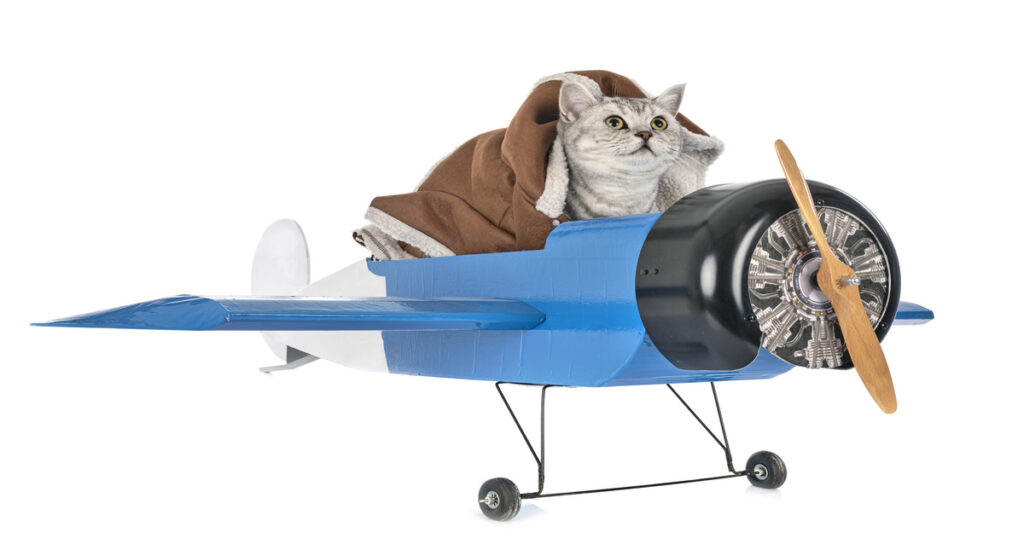
Cats on a Plane may sound like the title of a quirky comedy film, but for some pet owners, it’s a real-life challenge. Whether relocating with your feline friends or simply planning a vacation, taking two cats on a plane can be daunting.
From navigating airline restrictions to keeping your furry companions calm and comfortable during the journey, many factors must be considered. This article will explore the essential steps and tips to ensure a smooth and stress-free experience for you and your beloved cats at 30,000 feet above ground.
Table of Contents
Thoroughly researching airline pet policies.
The first step to taking cats on a plane is carefully reviewing each airline’s specific rules and restrictions regarding pets on airplanes . Airline pet policies vary widely, so never assume one airline’s regulations apply universally. Important pet travel factors to research include:
- Number of carry-on pets allowed per passenger – Most airlines limit passengers to 1 or 2 pets in the cabin. Verify that the specific airline permits you to fly with two cats in the cabin.
- In-cabin pet fees – Expect fees of $100–$200 each way per pet to have them travel in the plane’s main cabin.
- Pet carrier requirements – Airlines have strict dimensions and specifications for approved cat carriers for airplane travel . Carriers must safely fit under the seat.
- Necessary paperwork – Current veterinary health certificates or immunization records are typically required documentation for each cat.
- Airport pet relief areas – Many airports now have designated animal relief areas after security where pets can relieve themselves before boarding.
- Banned breeds – Some airlines prohibit snub-nosed (brachycephalic) cat breeds in-cabin due to potential respiratory issues at altitude.
Carefully reviewing each airline’s rules for flying with cats well in advance helps ensure a smooth trip. Always confirm policies shortly before departure.
Purchasing Compliant Cat Carriers
The carriers you use are critical when flying with two cats . Each cat needs its airline-approved carrier that properly fits underneath the seat. When selecting carriers:
- Verify carriers meet the airline’s specified dimensions and requirements. Physically measure your cats and test carriers for a good fit.
- Opt for sturdy, well-ventilated, soft-sided carriers with reliable zippers and shoulder straps to easily transport multiple carriers.
- Attach handles and luggage tags to carriers for easy identification. Label the exterior with “Live Animal” stickers per airline guidelines.
- Line the interior with plush, familiar-smelling bedding to help cats feel more comfortable and secure. Consider disposable potty pads.
- Bring a collapsible backup carrier for contingencies if an issue arises with the primary carriers.
- Practice carrier training beforehand so cats become comfortable and accustomed to the enclosed space. Use treats and praise as favorable reinforcement.
Investing in the right cat carriers for airplane travel tailored to your specific airline’s policies will ensure smooth sailing on flight day.
Obtaining Proper Veterinary Paperwork
Most airlines require current veterinary documentation for each cat passenger before travel, including:
- Certificate of Veterinary Inspection (CVI) – This certificate verifying your cats’ health for air travel must be issued by a licensed vet no more than ten days before the flight.
- Updated rabies vaccination proof – Current rabies shot records are typically required. Follow any destination country-specific regulations.
- International health certificate – This particular certificate is required for cats traveling on international flights, confirming they meet all destination country import requirements.
- Veterinarian approval letter – For cats with ongoing medical issues, airlines may require a letter from the vet deeming your cats fit to fly.
Schedule vet appointments well in advance to complete health exams and obtain all necessary paperwork. Vets can also prescribe anti-anxiety medication for nervous cats if needed. Bring documentation copies as backup.
Securing proper paperwork for flying with pets is mandatory and demonstrates airline compliance.
Packing a Dedicated Take Two Cats on a Plane
In addition to cat carriers, pack a dedicated carry-on bag for your cats’ in-flight needs, including:
- Collapsible food and water bowls, bottled water
- Litter box with disposable litter trays/bags
- Cat litter, waste baggies
- Dry food, treats (less messy than wet food) avoid toxic food in plane
- Medications, calming aids
- Cat first aid kit with grooming tools
- Paper towels, cleaning wipes, garbage bags
- Toys, blankets containing familiar home scents
- Plastic mats in case of accidents
- Portable litter box enclosure, if permitted
Keep items neatly organized and accessible. Refill food and water before boarding. This kit alleviates guesswork when ensuring cat’s comfort during air travel .
Preparing Cats Physically and Mentally for Travel Day
To minimize anxiety and stress on travel day:
- Schedule vet visit 1-2 weeks pre-travel to confirm health. Discuss anti-anxiety medication if recommended by your vet.
- Take practice car rides in carriers to positively reinforce travel. Bring cats’ favorite treats.
- Verify collars/ID tags are secure. Remove any loose collars that could catch on carriers.
- Maintain regular feeding schedules to prevent digestive upset.
- Introduce calming aids like pheromone wipes/sprays in advance to gauge effectiveness.
- Inspect packed carriers and cat carry-on bags ahead of time to avoid any issues.
- Provide unlimited food and water the night before travel for proper hydration.
- Thoroughly brush cats to reduce shedding. Trim nails to prevent catching on carriers.
Proper preparation helps get your feline friends** both physically and mentally for their big plane journey .
Arriving Early at the Airport
When travelling with two cats , build in ample extra time at the airport for:
- Longer check-in and boarding pass verification
- Paying fees for two pets
- Presenting required veterinary paperwork
- Screening two cats and carriers through security
- Letting cats briefly use post-security pet relief areas
- Handling unpredictable situations like anxious, agitated cats
Aim to arrive at the airport at least 2-3 hours before departure when traveling with multiple pets. Use online check-in and verify pet-friendly airlines policies.
Navigating Security Checkpoints with two Cats
Approaching TSA security checkpoints with two cats:
- Have valid boarding passes and pet paperwork ready. Politely request expedited screening.
- Attach leashes to each cat’s harness underneath carriers, keeping leashes handy in case a cat tries to dart off.
- Carefully remove cats from carriers while carrying them through metal detectors yourself. Keep holding cats securely.
- Directly carry cats through security. Only send them through conveyor belt x-ray machines at the right place.
- If a cat seems anxious, politely request manual “pat down” screening instead of passing through the scanner tunnel.
- Allow extra time for agents to inspect and wipe down carriers visually. Don’t rush nervous cats.
- Once cleared, methodically re-pack carriers. Double-check both cats are accounted for before heading to your gate.
Stay calm and move deliberately through security procedures. TSA agents will help guide you through the process.
Stress-Free Boarding Procedures
For smooth boarding with two cats:
- If allowed, request pre-boarding to secure prime real estate under seats and settle in cats. Otherwise, board in your assigned group.
- Attach leashes to cats underneath carriers as a precaution before opening doors to board the plane.
- Politely explain to the gate agent you are traveling with two cats and request aisle seats near the front.
- Place one cat under your seat and the second under your travel companion’s seat. Stow carriers.
- Once passengers are seated, discreetly set up a litter box on the floor between legs.
- Keep a cat carry-on bag handy to access food, medication, toys, etc.
- Request the shortest layover and pre-boarding on each flight segment for connections.
- Calmly soothe any anxious or upset cats while boarding. Use medications if prescribed.
Securing pre-boarding provides ample time to get two cats settled in comfortably under their seats for the flight.
In-Flight Tips for Cat Care
To keep your two cats content and stress-free inflight:
- Line carriers with absorbent pads in case of accidents or sickness.
- Check on cats frequently. Open carriers partway, but keep leashes attached.
- Offer tiny portions of food and water periodically. Limit intake to prevent issues.
- Allow cats to see each other for comfort, but prevent playing or vocalizing.
- Set up litter boxes discreetly in the bathroom when needed. Discard waste properly.
- Stay vigilant of cat activity around feet in aisles. Handle with care.
- Gently soothe anxious cats. Use medications as prescribed. Avoid scolding.
- Discreetly notify flight attendants if help is needed containing a cat or cleaning up a mess.
Diligent monitoring and proactive care keep cats relaxed and content throughout the flight. Address needs promptly.
Deplaning Cautiously with Cat Carriers
When deplaning with cats:
- Wait for the aisles to fully clear before moving. Thank any helpful neighbors.
- Carefully return cats to carriers and reattach leashes before standing up. Move slowly.
- For connections, reconfirm the location of pet relief areas. Use disposable litter trays.
- Approaching exit row, notify attendants you are deplaning with two cats—request time to secure them.
- Double-check that you have the necessary paperwork for the next flight—present forms to gate agents.
- Retrieve carry-on bags and merge into the exit line with extreme caution. Strongly warn those behind you.
- Never feel rushed. Take your time deplaning to keep cats safe from harm.
Patiently working through deplaning protects cats from stress and potential injuries. Don’t allow impatience.
Arriving at Final Destination with Cats
Once finally off the plane with two cats:
- At baggage claim, keep carriers secure until retrieving all checked bags. Use a cart if available.
- Before exiting the airport, physically verify both cats are accounted for. Don’t just assume.
- Use pet-friendly rental cars, taxis, and overcrowded trains/buses to reach final accommodations.
- Upon hotel/lodging arrival, immediately release cats from carriers to acclimate.
- Set up food, water, and litter boxes before letting cats roam the room. Provide treats.
- Closely monitor cats for any signs of health or behavior changes post-travel. Contact a local vet if issues arise.
Please don’t consider your travel over until the cats safely reach their final destination. Continue diligent monitoring.
“With proper preparation, patience and care, air travel with multiple cats can be smooth sailing. The extra effort ensures your furry friends stay comfortable and secure.”
Key Tips for Smooth Air Travel with Two Cats
To recap, follow these top tips for hassle-free air travel with two cats :
- Thoroughly research airline and airport pet policies in advance
- Purchase airline-approved carriers for each cat
- Obtain proper veterinary certificates for both cats
- Pack a dedicated cat carry-on bag
- Prepare cats physically and mentally before travel day
- Arrive extra early at the airport
- Request pre-boarding to allow extra cat settling time
- Carefully monitor cats and proactively meet all needs in-flight
- Take deplaning slowly and cautiously
- Don’t consider travel complete until cats reach the final destination
- Watch cats closely for health or behavior changes after landing
FAQs: Take Two Cats on a Plane
How can i help my cats feel less stressed while flying.
Bring along familiar items like favorite toys or soft blankets containing home scents. Consider anti-anxiety medication if prescribed by your vet. Provide ample love, treats, and verbal reassurance.
What if one cat gets loose from the carrier during the flight?
Stay calm. Quickly but gently alert airline staff to help contain the cat immediately. Secure your leash to the cat’s harness for a safe capture. Reward with treats when safely contained.
Is it okay to feed cats and give water during the flight?
Yes, small portions of food and water can be offered periodically. Limit intake to prevent accidents. Spill-proof bowls with lids are best. Wet food is trickier – stick to dry kibble.
What documents do I need when traveling with two cats?
You’ll need a valid health certificate and current rabies shot record issued by a vet for each cat. For international flights, an additional veterinary certificate may be required as well. Bring extra copies.
What if my cat gets sick or has an accident in the carrier?
Come prepared with absorbent pads, paper towels, cleaning wipes, garbage bags, and extra carrier liners. Discreetly clean up any messes and replace soiled items. Most flight attendants will gladly assist if help is needed.
Should I allow my cats to interact during the flight?
It’s best to keep cats in separate carriers, though you can open both carriers partially to allow them to see each other for comfort. Strictly supervise any interactions to prevent conflicts.
By mastering the intricacies of air travel pet logistics, your cats can relax, play, and enjoy the journey as much as the destination! Let me know if you have any other questions about smoothly taking two cats on a plane . Happy travels!
About Charles Lane
Meet Charles a devoted animal lover with a heart for dogs, cats, and horses. As the founder of realpetadviser.com, I am on a mission to share my expertise and passion, helping fellow pet owners provide the best care possible. Join me in creating joyful lives for our furry friends through valuable insights and reliable advice.
Leave a Comment Cancel reply
Save my name, email, and website in this browser for the next time I comment.
most recent

Horses , Blog
How long and how far can a horse run without stopping.

Cats , Blog
Can cats eat funyuns get vet advice on onion powder.

Dogs , Blog
Why is my puppy not eating and sleeping a lot 10 reasons.

Why does my cat bite me gently out of nowhere? Common Reasons Cat Love Bites.

15 Common household items can kill a dog, which is toxic to dogs

Can a cat taste spicy food? Cats eating spicy food explained!
Real Pet Adviser
PH +1-202-555-0163
1243 E Main St, Barstow, California, United States
© 2024 Real Pet Adviser
© 2024 IT,S aLL ABOUT PET s

How To Travel With Two Cats On A Plane
Sharing is caring!
Flying with two cats can feel like a daunting task, but it doesn’t have to be. As someone who craves freedom and adventure, I understand the desire to bring our furry companions along for the ride. With some careful preparation and planning, traveling with your cats on a plane can be a stress-free experience for both you and your feline friends.
Picture this: You’re soaring above the clouds, feeling weightless and free as you journey to a new destination with your beloved pets by your side. It’s an exciting prospect that’s sure to spark joy in any pet owner’s heart.
But before you take off into the wild blue yonder, there are important steps you need to take to ensure both you and your cats have a safe and comfortable flight. In this article, I’ll share my tips on how to prepare yourself and your furry friends for air travel so that you can enjoy every moment of your adventure together.
Table of Contents
Check Airline Policies
Make sure you know the airline’s rules before you board so there are no surprises later on. Each airline has their own set of policies when it comes to traveling with pets, and it’s important to read them thoroughly. Some airlines allow cats in the cabin, while others require them to be checked as cargo. Additionally, some airlines have specific carrier size requirements or breed restrictions that you need to be aware of.
If you’re unsure about any of the airline policies, don’t hesitate to reach out to their customer service department for clarification. It’s better to double-check and avoid any issues than risk being turned away at the gate. You’ll also want to ensure that your cats have all necessary vaccinations and documentation required by the airline.
Before we can prepare our furry friends for travel, it’s important that we understand the rules set forth by our chosen airline. By taking the time to research and ask questions regarding pet travel policies, we can ensure a smooth journey for both ourselves and our feline companions.
Now that we’re familiar with what is expected from us during air travel with pets, let’s move on to preparing our cats accordingly!
Prepare Your Cats for Travel
I believe that preparing your cats for travel is crucial to ensure a smooth journey.
Firstly, consider your cat’s personality and how they may react to being in a new environment.
Secondly, introduce them to the carrier well in advance so that they can get used to it and feel comfortable inside.
Lastly, pack familiar items such as their favorite toys or blankets to provide comfort during the trip.
Taking these steps will help make your cats feel safe and secure while traveling.
Consider Your Cat’s Personality
Consider your cat’s personality when traveling with them. It’s crucial to identify your cat’s personality type and plan accordingly. Some cats may feel anxious and stressed during the flight, while others may take the experience calmly.
If your cat is typically anxious or easily frightened, you may want to consider talking to your veterinarian about medications that can calm them down during the flight. Alternatively, if your cat is generally relaxed and easy-going, they might not need any medication at all.
It’s also important to keep in mind that cats are creatures of habit; any changes in their routine can cause stress and anxiety. So ensure you follow their usual feeding schedule before boarding the plane.
When introducing them to their carrier, make sure they have a comfortable space inside where they can relax and feel safe. Your carrier should be well-ventilated with enough room for your feline friend to stand up, turn around comfortably, and lie down in a natural position.
The more familiarized they are with their travel carrier beforehand, the less stressful it will be on travel day.
Introduce Them to the Carrier
Getting your feline friend used to their carrier is crucial for a stress-free flight experience. Cats are creatures of habit and sudden changes can cause them to feel anxious or scared.
Start by introducing the carrier to them slowly, let it sit in the room where they spend most of their time so they can get used to its presence. Then, try placing some treats and toys inside the carrier so they associate it with positive experiences. Once they’ve become comfortable with going in and out of the carrier on their own, you can start closing the door for short periods of time while you’re still at home.
Here are 5 tips that could help make this experience more enjoyable for both you and your furry friends:
- Be patient and allow enough time for them to get used to their carrier.
- Use pheromone sprays or wipes designed specifically for cats that have calming effects.
- Avoid using tranquilizers unless prescribed by a vet as these can cause additional stress during travel.
- Try covering the carrier with a blanket or towel if your cat seems nervous about being exposed.
- Reward good behavior with treats or praise.
Now that your cat has become familiarized with his/her new home away from home, it’s important to pack familiar items that will provide comfort during travel.
Pack Familiar Items
Pack personal possessions to provide a peaceful and pleasant flight experience for your purring pal. Bringing familiar items like blankets, toys, and even their favorite treats will help calm them down during the flight. Make sure to pack these items in a separate bag or container that’s easily accessible during the journey.
Another important item to bring is a litter box. This may seem like an inconvenience, but it’ll prevent any accidents on the plane and make your cats more comfortable. Additionally, bringing along some disposable litter liners or bags will make clean-up easier for you.
Remember, packing familiar items can go a long way in making your cats feel at ease during travel.
As you prepare for your trip with your feline friends, don’t forget to talk to your vet about any concerns or questions you may have before flying with them. It’s important to ensure that they’re up-to-date on all vaccinations and medications needed for air travel.
With proper preparation and care, traveling with your two furry companions can be an enjoyable experience for everyone involved!
Talk to Your Vet
Before embarking on any travel plans with my two cats, it’s important to talk to my vet. I’ll ask about medication options for calming them during the journey. I’ll also discuss feeding and watering guidelines for the trip and any health concerns that may arise. By taking these proactive steps and seeking professional advice, I can ensure a safe and stress-free experience for both myself and my furry companions.
Discuss Medications for Calming
You’ll want to make sure your furry friends feel relaxed during the flight, so consider talking to your vet about bringing along medications for calming. Here are some things to keep in mind:
Not all cats react well to medication, so it’s important to test any calming drugs before the flight.
Some common medications that may be prescribed include gabapentin, trazodone, and alprazolam.
Dosages will vary depending on your cat’s weight and reaction to the medication.
You’ll need a prescription from your vet in order to bring these medications on board with you.
It’s important to follow all airline regulations regarding medication and travel.
Additionally, it’s important to note that medication isn’t always necessary. Your vet may recommend other methods of keeping your cats calm during the flight. Either way, it’s best to discuss all options with them before making any decisions.
As you prepare for your flight with your feline friends, don’t forget to ask about feeding and watering during the trip.
Ask About Feeding and Watering
Make sure to check with your vet about how your furry companions can stay nourished and hydrated during the flight. It’s important to note that TSA regulations only allow small amounts of liquid in carry-on bags, which makes it difficult to bring their food and water bowls on board. However, there are a few ways to ensure that they remain hydrated and fed throughout the journey.
Firstly, you could opt for a soft-sided carrier that has built-in compartments for food and water. These carriers typically come equipped with collapsible bowls that can be filled up after passing through security. Alternatively, you could also freeze some wet food into ice cubes ahead of time and place them in a plastic baggie for easy thawing during the flight.
Remember to keep an eye on their intake and avoid overfeeding them before or during the flight as this may cause discomfort or nausea. With these tips in mind, your feline friends will be well-nourished and ready for takeoff!
As you prepare for your travels with your cats, don’t forget to discuss any health concerns with your veterinarian beforehand. They may recommend additional medications or supplements to ease any stress or anxiety that your pets may experience while flying. By doing so, you’ll have peace of mind knowing that both you and your furry companions are fully prepared for the trip ahead!
Discuss Any Health Concerns
Oh, so you’re not concerned about the well-being of your furry travel companions during the flight? That’s cool, I guess. But just in case you change your mind, discussing any health concerns with your vet beforehand might be a good idea.
Cats are susceptible to motion sickness and anxiety during flights, which could lead to vomiting, dehydration or worse. Your vet can provide insight on how to keep your cats calm and comfortable before and during the flight.
Additionally, it’s important to make sure that your cats are up-to-date with their vaccinations and have all necessary paperwork for air travel. Some airlines require a health certificate issued by a veterinarian within 10 days of departure. It’s also recommended to pack any medications or supplements that your cats may need in case they get sick or stressed during the journey.
By taking these preventive measures, you’ll have peace of mind knowing that you’ve done everything possible to ensure a safe trip for your feline friends.
Now that we’ve covered some health concerns for traveling with cats on a plane, let’s move on to another important aspect: getting to the airport early.
Get to the Airport Early
Arrive at the airport with plenty of time to spare so you can smoothly navigate through security, find your gate, and settle in before takeoff. When traveling with cats, it’s important to give yourself extra time in case any unexpected issues arise. Here are some tips to help make the process easier:
- Make sure your cats have used the litter box and had a chance to stretch their legs before heading to the airport.
- Use a sturdy carrier that’s large enough for both cats to comfortably fit inside and is airline approved with proper ventilation.
- Bring along all necessary documents, such as vaccination records and health certificates.
Be prepared for TSA security checks by removing your cats from their carriers and walking them through the metal detector separately from their carriers.
Once you’ve made it through security, find a quiet spot near your gate where you can let your cats out of their carriers for a bit of exercise.
Remember that traveling with two cats requires extra planning and patience. By arriving early and following these tips, you can ensure a smoother experience for both you and your furry companions.
As we move on to boarding the plane, keep in mind that there are still important steps ahead to ensure a safe flight for everyone involved.
Boarding the Plane
After getting to the airport early, it’s time to board the plane with your furry friends. Make sure you have all necessary paperwork and identification for your cats before boarding. This includes their health certificates, vaccination records, and any other required documents.
When boarding, inform the flight attendants that you’re traveling with cats and ask if there’s a designated area on the plane where you can keep them during the flight. Some airlines may allow small pets in carriers under your seat, while others may require them to be stored in cargo. It’s important to know this information beforehand so that you can properly prepare for your travel experience.
Once on the plane, make sure your cats are comfortable in their carriers and have enough food and water for the duration of the flight. Additionally, try to keep them calm by talking to them in a soothing voice or giving them toys or treats to distract them.
By following these steps, you can ensure a smooth travel experience with your feline companions. As we settle into our seats for takeoff, it’s important to remember that traveling with pets requires extra preparation and patience.
During the flight, there are additional considerations such as managing litter boxes or providing medication if needed. In the next section, we’ll discuss tips for managing these tasks while keeping both yourself and your cats happy during air travel.
During the Flight
Once you’re in the air with your furry companions, there are a few things you can do to make sure they stay comfortable and content throughout the flight.
First, make sure that their carriers are securely stowed under the seat in front of you or on the floor between your legs. It’s important that they have enough room to move around a bit and access to water if they need it.
Secondly, try to keep them as calm as possible by talking to them in a soothing voice or offering them treats if they’re allowed. You could also bring along some toys or familiar items from home to help them feel more at ease. Remember that cats can sense when their owner is anxious, so try to stay relaxed yourself.
Lastly, be prepared for any accidents or messes that might happen during the flight. Bring along extra litter boxes, paper towels, and cleaning supplies just in case. And don’t forget to check on your pets periodically throughout the flight to ensure their well-being.
As we approach our destination, it’s important to start preparing for our arrival with our feline friends. This means making sure we have all necessary documentation and supplies ready for customs and immigration. We’ll also need to plan for transportation from the airport and find pet-friendly accommodations if we haven’t already booked them.
With these preparations taken care of, we’ll be able to enjoy a stress-free journey with our beloved kitties!
Arrival at Your Destination
Once I arrive at my destination, the first thing I need to do is collect my luggage.
After that, it’s important to find a quiet spot for my cats where they can feel safe and secure.
Finally, I need to allow them time to adjust to their new surroundings before introducing them to any unfamiliar people or animals.
Collect Your Luggage
Don’t forget to grab your bags before exiting the airport! After a long flight with your furry friends, it can be easy to overlook this crucial step. Once you have safely landed and arrived at your destination, head to baggage claim and collect all of your luggage. Remember that you will have more than just your own bags – you will also need to retrieve any pet carriers or accessories that may have been checked in.
To ensure a smooth transition out of the airport, here are five important items to keep in mind:
- Double check that all of your bags are accounted for before leaving.
- Make sure the cat carriers aren’t damaged or broken during transit.
- Check if there are any signs of stress on your cats from the travel experience.
- Keep all essential documents (i.e. passports, boarding passes) organized and in a safe place.
- Prioritize safety over speed when moving around with two cats and several pieces of luggage.
Now that you’ve collected everything you need from baggage claim, it’s time to find a quiet spot for your cats.
Find a Quiet Spot for Your Cats
It’s crucial to locate a peaceful area for your furry friends after leaving the chaos of the airport, because they deserve a moment of respite just as much as you do. When traveling with cats, it’s important to remember that they may become overwhelmed and anxious in new environments.
Finding a quiet spot where they can relax and feel safe will help them adjust to their new surroundings. Look for an area away from the hustle and bustle of the airport crowds. A secluded corner or empty gate can be a perfect spot for your cats to unwind.
Make sure there is enough space for them to move around comfortably, and provide some familiar items such as blankets or toys to make them feel more at home. Remember, giving your cats time to decompress will make the rest of your journey smoother. Allow them time to adjust before proceeding with any further steps.
Allow Them Time to Adjust
Give your furry friends some time to adjust before moving on to the next step, as they may become overwhelmed and anxious in new surroundings. When traveling with cats on a plane, it’s important to remember that they are creatures of habit and routine.
Being taken out of their comfort zone can cause them stress and anxiety, which can lead to behavior problems or even illness. To help your cats adjust to their new environment, give them plenty of time to explore and get comfortable in their carrier before takeoff.
Allow them access to food and water, but be sure not to feed them too much or too close to the flight time. You can also try adding familiar items such as blankets or toys into the carrier with them for added comfort. By giving your cats time to acclimate themselves, you’ll ensure a smoother flight for both you and your feline companions.
Now that your cats have had some time to adjust, it’s important for you as well as for them that you enjoy your trip!
Enjoy Your Trip!
Now that you’re ready to embark on your adventure, take a deep breath and savor the excitement of exploring new places with your furry companions by your side.
It’s important to remember that traveling with cats can be stressful for both you and them, so it’s crucial to maintain a calm and positive attitude throughout the journey.
Make sure to pack all necessary supplies such as food, water, litter boxes, and toys so your cats feel comfortable during the flight.
During the flight, keep an eye on your cats’ behavior and provide them with plenty of attention and comfort. If they seem anxious or restless, try distracting them with their favorite toys or treats.
Additionally, make sure they have enough space in their carrier to stretch out comfortably. Remember to follow airline regulations regarding pet travel and inform cabin crew members about any special needs or requirements for your cats.
As you arrive at your destination, take some time to relax and unwind with your furry friends before embarking on any adventures. Settling into a new environment can be overwhelming for pets, so allow them enough time to adjust before venturing out too far.
With proper planning and preparation, traveling with cats can be a fun and rewarding experience for both you and your feline companions.
Frequently Asked Questions
Can i bring my cats in a carrier that doesn’t fit under the seat in front of me.
I recently had to travel with my two cats on a plane, and one of the biggest concerns I had was whether or not I could bring them in a carrier that wouldn’t fit under the seat in front of me.
After doing some research and speaking with airline representatives, I found out that it is possible to bring larger carriers on board as long as they meet certain requirements.
First, make sure the carrier is made of sturdy materials and has proper ventilation. Second, it must be able to fit in the overhead bin or under an empty seat in another row.
Finally, there may be additional fees for bringing larger carriers on board. With these considerations in mind, you can still travel comfortably with your furry friends even if their carrier doesn’t fit under the seat in front of you.
What if my cats become agitated or stressed during the flight?
During my recent flight, I noticed that my two cats became agitated and stressed at certain points. It’s important to be prepared for these situations and have a plan in place to keep your furry friends calm.
One option is to use pheromone sprays or diffusers to help reduce anxiety. You can also speak with your veterinarian about calming medications that may be appropriate for your cats.
It’s helpful to provide familiar items such as blankets or toys from home, and make sure they have access to water throughout the flight. By taking these steps, you can help ensure a smoother travel experience for both you and your feline companions.
Can I give my cats sedatives before the flight?
I know how stressful it can be to travel with pets, especially when flying. I’ve often wondered if giving my cats sedatives before a flight would make things easier for all of us.
However, after careful research and consulting with my veterinarian, I learned that sedating cats during air travel is not recommended. Sedatives can affect their balance and breathing, potentially causing harm during takeoff and landing.
It’s important to find alternative solutions to calm your cats during the flight, such as using pheromone sprays or providing a comfortable carrier with familiar toys and blankets.
Keeping our furry friends safe and healthy should always come first when traveling together.
Are there any restrictions on the type of carrier I can use for my cats?
When it comes to traveling with cats on a plane, there are certain restrictions on the type of carrier that can be used.
Airlines typically require carriers that meet specific size and material requirements for the safety and comfort of your furry companions. The carrier should be large enough for your cat to stand up, turn around, and lie down comfortably. Additionally, it should have proper ventilation and be made of sturdy materials that won’t easily collapse or break during transport.
Many airlines also require that the carrier fit under the seat in front of you, so make sure to check with your airline beforehand to ensure you have the appropriate carrier for your cats’ journey.
How can I make sure my cats are comfortable during the flight?
During a flight with pets, it’s important to make sure they’re comfortable and at ease. To start, I always make sure my cats have access to water and food throughout the journey.
I also try to create a cozy environment for them by lining their carrier with their favorite blanket or toy. It’s also important to keep them calm during takeoff and landing by giving them some extra attention and reassurance.
If your pet gets anxious during flights, talk to your vet about medications or calming techniques that may help. Overall, keeping your pets comfortable and relaxed during air travel will make for a smoother journey for everyone involved.
So there you have it, traveling with two cats on a plane doesn’t have to be a daunting task. With proper preparation, communication with your vet and the airline, and being mindful of your cats’ needs during the flight, you can ensure a smooth journey for both yourself and your feline companions.
But I know what some of you may be thinking: ‘What if my cats are just too anxious or scared to travel?’ While it’s true that not all cats may take well to air travel, there are steps you can take to help alleviate their anxiety such as using calming pheromone sprays or medications prescribed by your vet.
And in worst-case scenarios where air travel is not an option, consider alternative modes of transportation such as driving or finding accommodations closer to home.
Remember, the most important thing is to prioritize the safety and comfort of your furry friends. So don’t let fear hold you back from embarking on new adventures with your beloved pets – with careful planning and patience, anything’s possible.
Happy travels!

Meet Debra. If you can’t imagine traveling without your furry friend, then Debra Eriksen is your go-to expert. Debra has embarked on pet-friendly journeys across more than 20 countries, making her an expert in combining wanderlust with pet ownership. Her articles provide practical tips, invaluable advice, and heartwarming stories of exploring the world with her beloved dog. Let Debra be your guide to creating unforgettable memories with your four-legged companion while exploring new horizons.
Related Posts
How to travel with a pug on a plane, how to travel with cheese on airplane.
- Skip to primary navigation
- Skip to main content
- Skip to primary sidebar

Your ultimate guide to flying internationally with a cat: Tips & Essentials
January 28, 2019 by Karen Turner 56 Comments
One of the most challenging experiences that we had in terms of moving abroad was moving our cat. I adopted Lu in the United States at a shelter. Admittedly, she’s not so keen on traveling, but I knew that when we moved abroad that she had to come with us. Since then, she’s traveled with us to four countries following our various moves around Europe by plane and by train. I include my experience traveling with my cat internationally, some tips for traveling with your cat, and my favorite cat traveling accessories, including an airline approved pet carrier.
I urge you not to underestimate how many hours it takes to properly research flying with your cat to your destination as well as preparing them for the move. Cats are creatures of habit and it can be very traumatizing for many cats to be uprooted from their home. I can’t really say that it’s fun traveling with a cat, but sometimes it comes to this when making a significant move abroad with your cat.
- Tips for flying internationally with your cat
- Traveling with multiple cats
- Why you shouldn’t put your cat under the plane
Should you drug your cat for travel?
What you need to do before traveling with your cat.
- Cat traveling essentials
The best airline approved cat carrier
- Our experience flying internationally with a cat on a transatlantic flight
- Our experience flying within the EU with our cat
- Our experience taking the Thalys with a cat

- 1.1 Before you travel with your cat internationally
- 2 Traveling on the plane with your cat
- 3.1 Traveling internationally with multiple cats
- 3.2 Why you should consider NOT putting your cat underneath the plane
- 3.3 Should you drug your cat for travel?
- 4 What you need to do before traveling with your cat
- 5.1 The best airline approved cat carrier
- 5.2 Cat collar
- 5.3 Cat harness*
- 5.4 Folding cat bowls
- 5.5 Calming Spray
- 5.6 Portable Cat Bed*
- 5.7 Portable Litter Box*
- 6 Our experience flying internationally with our cat on a transatlantic flight
- 7 Flying within the EU with a cat
- 8 Taking the Thalys train with our cat
- 9 Have you flown internationally with your cat?
Tips for flying with your cats internationally
Before you travel with your cat internationally.
In general, I recommend not traveling with your cats unless you’re moving for a significant period. Both of my cats do not travel well and if it’s a few weeks, I found that it was better to board them at a facility rather than bring them with me to a destination where the paperwork would make my life more complicated.
In general, it’s generally cheaper to buy a round-trip ticket rather than a one-way ticket. Try to time the way back with when you think you’ll next head home, so you only need to purchase the way back to your new home.

If you intend to fly internationally with your cat, you need to carefully check the requirements of your final destination as well as possible transit destinations. Your cat needs to be healthy in order to fly. I had to first ensure that she was up-to-date on her vaccinations. Talk to your vet .
Some countries require a rabies vaccination to be given a certain amount of time ahead. As a result, you’ll need to plan at least 1-2 months ahead if you’re traveling from a high rabies country as a blood test may need to be done and your cat will need to have their vaccines done in advance. I had to bring my cat in for a check-up shortly before flying in each case to ensure that she was ready.
If you can minimize your travel time, do it by getting a direct flight. Your cat will appreciate it. Your cat will be stressed, hungry, and tired from the travel. Fewer flights will reduce the likelihood that you have a delay or missed transfer.
If you have a rolling suitcase , I recommend putting your cat carrier on top and rolling your suitcase slowly. I’ve tried a couple of ways in terms of minimizing trauma when traveling en route to the airport using public transit/walking and this way worked the best. It’s smooth, your cat is less likely to be jostled within the bag, and they can look out more easily!
If you can travel with your cat in the cabin, do it. I felt so guilty every time that I’ve traveled with Lu, however, it’s a small relief to be able to see how the cat is doing. Your cat might be deeply unhappy, however, at least you can give them water and pet them to calm them if needed. Just be careful about unzipping the bag, so they don’t escape!
Book your cat’s plane ticket in advance. Most airlines that allow animals on board have a limit on how many animals can be brought with you. I had to pay extra to bring Lu as my “carry-on” item and she had to fit in the space near my feet in her carrier.
Traveling on the plane with your cat
As soon as you get on the flight, talk to the flight attendants as well as those around you to check that nobody is allergic. Similarly, it’s good to notify the flight attendants of your furry friend on board just in case something goes wrong.
Keep your cat’s documents with you somewhere that is easily accessible. You might need to show them several times, so don’t put them away in your suitcase. I keep mine in the side pocket of my cat carrier . I have been rarely asked for them, but you never know!
Make sure that your cat carrier has a tag that states your information on it, including your phone number. I made sure that Lu was wearing a collar that stated my phone number on it, just in case she ran off.
The biggest risk in losing your cat is during security when they must be removed from the carrier to be carried through security with you. If you can find a non-metal collar , that’s probably best as you might need to remove the collar during security. I also had a photo of her on my phone, just in case.

Get through security when it’s not so busy and find a quiet place to sit. I recommend giving yourself extra time at the airport. That said, airports are really loud places and if you’ll be there for a while, find a quiet corner away from music, security, and people talking loudly to sit. Your cat will thank you!
Clip your cat’s nail before you travel. You’ll need to carry them through security most likely…and it’s not fun being clawed into with sharp kitty claws.
Avoid feeding your cat 4-6 hours before traveling. I caved during my flight with Lu and gave her a treat, which resulted in her pooping (a small bit) in the litter box. Obviously, for cats, this is not comfortable. I recommend carrying a small folding cat bowl that can be used for water if needed. I bought a water bottle once through security just to give Lu water as needed.
Once you arrive at your destination with your cat
Once you’re somewhere less chaotic and enclosed, let your cat out. They’ll probably be a bit traumatized from the journey as well as hungry/thirsty. The sooner that you can get a litter box, the better as they’ll probably need it.
Check with your hotel that it’s cat-friendly before you go . I find that dog-friendly hotels are often surprised that you want to bring a cat, but you’ll pay a premium for finding a cat-friendly hotel . Even if they say that they’re pet-friendly, not all will accept cats.
On average, you’ll pay 30-40% extra with the majority of hotels telling you no. It’s frustrating, but book your hotels/accommodation in advance as soon as you know your traveling dates. I always try to emphasize that my cat is very well behaved and doesn’t go outside.
Travel can be really hard on cats and it can take your cat weeks to get used to your new home. If possible, try to move slowly to avoid changing accommodations too often as they’ll want to be at home. I recommend looking for places with good windows (like our Paris apartment).

Traveling internationally with multiple cats
An acquaintance of mine contacted me about my experience moving abroad as she was moving with her two cats and one small dog. Airlines usually allow one pet per person, so she found out that it was cheaper to pay for a close friend’s round-trip ticket to her new home (e.g. a free vacation) than it was to have someone else bring her dog. Her friend got a free trip out of it and she got to bring her cats with her.
Why you should consider NOT putting your cat underneath the plane
Quite a few cat breeds, especially Persians, may have issues related to breathing and heat stroke. Putting certain cats into cargo may be a bad idea. Even if your cat is a mutt like mine, your cat might be hyperventilating during the flight. Coming with the uncertainty of not knowing what is going on and the sounds, your cat might be really anxious underneath the plane and/or have issues during the flight.
Some carriers will report the percentage of animals in their care that were injured or killed in transit. Choose carefully if you are considering putting your cat underneath the plane. Ask around if possible.
Lu tends to hyperventilate when on a plane and inside a car, so I opted to take longer to travel with her if it meant having her with me to check on her, even if there was a layover. I ended up going with Aeroflot due to their cat-friendly policy, which allowed her to sit near my feet!
Talk to your vet about your travel plans. I’ve seen several vets about traveling with my cat. Only one of them recommended drugging my cat for travel while the rest said that it was enough just to use a calming spray . There are a number of other drugs, but you should discuss what is most appropriate with your vet.
Generally, cats are given something similar to Xanax (benzodiazepines) if they’ll be traveling a long distance. This is what my cat had gotten prescribed for our U.S. to Netherlands move, however, it left her disoriented and unable to sleep. Since then, I’ve not used a drug.
- 6 Months ahead: Book your cat’s plane ticket and find a cat-friendly airline.
- 5 months ahead: Find out your airline’s paperwork requirements for flying with your cat. Your cat might need to be microchipped with a different chip if it’s not the same where you’re traveling.
- 2 Months ahead: Talk to your vet about your travels. Ensure that your cat’s vaccines are up to date.
- 1-2 months ahead: Ensure that your cat’s travel documents are up-to-date. Possibly see the vet and make relevant appointments shortly before your travels.
- 1-2 months ahead: Organize relevant transportation (buses don’t usually allow cats) and cat-friendly accommodations in your new destination.
- 1 Month out: Buy a good cat carrier , calming spray , cat collar , a cat harness , and other relevant supplies (see below)
- 1 Month out: Call your airline to check that all is well.
- 2-3 weeks ahead: Take care of relevant travel documents (if required)
- Week of travel: Check-up with your vet to ensure that your cat is healthy to fly. Clip your cat’s nails.
- The day before travel: Give your cat a nice meal 12 hours before! Organize your cat’s travel documents. Spray the carrier with Feliway and leave it out for them to explore.
- Day of travel: Stop feeding your cat 6 hours before your travels. Get the cat into the carrier. Leave early for the airport. Keep calm and try to find somewhere quiet.
- Day of arrival: Buy litterbox and cat litter once you arrive. (You can bring a small litter box with you if you arrive late at night) Feed your cat and let them relax/sleep.
Cat essentials for flying internationally

I got this bag around five years ago. This Argo by Teafco Pet Avion Airline Approved Pet Carrier perfectly fits my cat (who is on the smaller side) and it’s built cleverly. Inside, you’ll find a leash that hooks into your cat’s collar as to ensure they can’t escape the bag. Similarly, there’s a way for you to reach your hand inside without the cat escaping if you wish to calm them. There are several pockets around the bag, which can fit Feliway, travel documents, and cat travel accessories.
Most importantly, I love this bag as people assume that it’s a carry-on bag, not a cat bag. Travel is stressful enough for my cat and having strangers trying to pet her doesn’t help. She can look out of the bag through the mesh sides without people peeking in, which has been great for international travel with a cat. ( In quite a few cases, I was never asked about the cat as they didn’t realize I had a cat with me.)
In general, I recommend getting a soft cat carrier if you’ll be flying internationally as your cat needs to fit underneath the seat in front of you. If your cat is larger, you’ll want to get a larger bag to ensure they have room to move around. There might be some squishing of the carrier, so it’s much easier to have a soft bag. (Every vet that I’ve seen in Europe has asked me where I got this bag.)
I recommend ensuring that your cat has a cat collar as you’ll probably want to use the collar to clip your cat into the bag (if possible) and/or connect them to the cat leash. You might need to remove your cat collar if it contains metal, so choose carefully. If you can attach your phone number to the collar, that’s great. Ensure that it’s snug, but not too tight.
Cat harness*
Your cat might be frustrated inside of the bag. I found the cat harness to be helpful, however it’s really hard getting your cat into a cat harness in the middle of an airport. A handicap-accessible toilet might be a good option if you want to get your cat into a harness. In my case, I attached the harness directly to her collar to ensure she wouldn’t wander off.
Folding cat bowls
You cat might get thirsty during the journey and once you arrive at your destination, you’ll want to feed your cat. It was really helpful having folding cat bowls as it enabled my cat to eat as soon as we got cat food. (I brought some with me in a plastic bag.)
Calming Spray

Feliway has helped my cats travel. This spray mimics cats pheromones given off by mothers to help calm kittens. It can help reduce stress in some cases. I recommend putting an item of your clothing that smells like you and spraying it with Feliway before putting it at the bottom of the carrier.
Portable Cat Bed*
As I had to get rid of the cat bed that my cat loved, I ended up buying a smaller foldable cat bed that was in my house for a few weeks before my travels. My cat liked it as it was a good way for her to feel safe in a new environment. Similarly, it was squishy enough that I used it as a pillow in transit.
Portable Litter Box*
If you’re arriving late at night, you’ll want to bring a portable litter box with you as litter is typically easier to get at some late night shops/supermarkets, however you generally need to go to a pet store for the litter box.
Our experience flying internationally with our cat on a transatlantic flight

My first international flight with my cat was flying from New York to Amsterdam via Moscow. When moving to Amsterdam, flying Aeroflot with the cat was our best option for an affordable airline that allowed cats in the cabin. It took many hours to find a flight that would allow her in the cabin, but that was non-negotiable.
In our case, the paperwork involved my vet gave her an examination clearing her for flying prior to submitting the paperwork to a federal agency to be stamped. Ask your vet for the procedure for where you’re traveling. Some airlines have limited space for animals, so you should ensure that you reserve your cat’s place in advance. I reserved my cat’s place as soon as my ticket was booked.
On the day of our flight, we showed the paperwork as we checked our bags and headed through security. Security was difficult as Lu is very noise-sensitive and the various noises did not help at all. I was forced to take her out of the carrier as I went through the metal detector. She was very scared and clung to me. Once we were through security, she calmed down a bit.
Once on the plane, we asked everyone around if they were allergic to cats. (The passengers and the flight attendants doted over us and asked to pet her.) It was very painless. She was very quiet although very anxious during the flight. I checked on my cat at several points and she was too upset to sleep. As per our vet’s recommendation, we avoided feeding her during the plane ride and withheld food 4-6 hours before our flight.
Finally, once we arrived in Moscow for our layover. We put her on a cat leash and let her sit on one of the seats. She immediately curled up and took a small nap. Nearby, two burly Russian guys took selfies with her. On the next flight, she meowed quite a bit, but we managed to get to Amsterdam. We immediately went out and bought a litterbox for her as it was day-time.
Flying within the EU with a cat

If you’re traveling within or from the EU with your cat, I strongly recommend seeing if you can get your cat an EU pet passport . It will make your life a lot easier as it shows their complete medical record as well as recent examinations. Just a few days before our flight, we brought her to a vet for a pre-flight examination as required by our airline, who we booked her ticket through.
Last summer, we lived in Brussels while waiting for our French visas. We ended up flying with BlueAir, a budget European airline to Romania and France. The process was fairly decent as my cat already had an EU pet passport. She simply had to get examined by a vet in the days prior to the flight to clear her for health. At this point, she was up-to-date on her vaccinations.
I had Lu on a leash clipped to her collar. The most stressful part was security where one of the employees required that I take the collar off. I had to carry her through airport security, which was an immensely stressful experience for both of us. She tried at one point to jump back into her box as it passed through security.
The flight itself was fine, however we flew twice with her. It was quite hard on her and given the option, I prefer to take the train. That said, you will have limited options as most of the major bus companies in Europe do not allow cats on them, which is quite aggravating as a pet owner.
Taking the Thalys train with our cat

I’ve taken the Thalys with my cat between Belgium and the Netherlands and France and the Netherlands. Cats were free and allowed when I traveled, however I had to have all my cat’s documents in order (similar to a plane). She had stay underneath the seat.
When boarding the Thalys, you’ll need to scan your items. It was quite nerve-wracking going through the security line in Paris, which as outside next to the train tracks. I had to remove Lu from her bag and carry her through security. It was loud and I’d be a bit apprehensive about doing this with a cat who tends to run when they’re scared.
Once on the Thalys, I found my seat. The journey was uneventful and at one point, the conductor asked about the cat. On one journey, a woman next to me refused to sit next to me as I had a cat. (She was pregnant.) I was a bit confused, but she moved across the way with the permission of the conductor. The journey was easy and my cat was far more relaxed than traveling by slower trains and flying.
Have you flown internationally with your cat?
- More tips for traveling with your cat

About Karen Turner
New Yorker–born and raised. Currently living in the Hague, the Netherlands after stints in Paris and Amsterdam. Lover of travel, adventure, nature, city, dresses, and cats.
Reader Interactions
May 15, 2019 at 8:44 pm
do you have a recommendation of a vet in The Hague who is familiar with what is needed for cat “import”? will be bringing my fluffy friends and want to be sure I have all the proper docs up front. I am not in an EU country right now so they don’t know the regulations.
May 16, 2019 at 3:49 pm
Hi Molly, You should be able to ring basically any vet in the center of the Hague. I”m not sure if they’ll help you as you’re not a client (maybe if you promise to become a client!), but you should definitely check with your airline too. Depending on whether the country is high rabies, you might need to do an extra paperwork. There’s some good information on the various pet transit websites and it’s so different by country that I can’t say for sure. Best of luck moving to NL! 🙂
June 9, 2019 at 10:11 pm
I suggest you contact the nearest consulate or embassy for the Netherlands, they should be able to help you. Otherwise, their should be the correct info on their government website or the corresponding EU website. I am moving to France from the USA and found clear instructions on the French government and EU sites. On the latter, I was able to print out the documents which needed to be filled out by the vet in the country of departure (with instructions on how it should be filled out) and also a copy of the EU pet passport which you can print out. Your cat will need to be microchipped with an EU approved chip and also have its rabies vaccine up to date. If the cats aren`t vaccinated for rabies they have to have a primo vaccine and may have to have a titration (?) done by an approved lab 3 months before travelling. I`d advise you to look into this as soon as possible as there may be time limitations for some procedures. Best of luck with your move!
December 12, 2020 at 2:59 am
There are U.S. Veterinarians that are specialized on preparing the needed documents and doing the health exam within 10 days of flight. Not every vet does this but every community has one. We have reserved the cat spaces 6 weeks prior to the flight (during Covid). It is true, if your cat does not have rabies shot yet, you need more time for preparing the transfer, one has to wait 21 days for the rabies shot before being able to travel. One has to submit the documents to the animal export department of your state, which provides a quick turnaround with courier service. If you stay in Europe and travel with your pet there for a while we recommend getting a European animal passport through a vet there. Some countries (Switzerland) are annoyed looking at the U.S. documents and feel suspicious about them or don’t take the effort to understand them. Once the agent did not want to check us on the flight from Zurich to Greece… until her supervisor did a great job in understanding the U.S. health certification papers. This can be stressful.
June 9, 2019 at 10:13 pm
Thank you for all this great info Karen. I have traveled to several countries with dogs (diplomat husband) but never with a cat, you have helped a lot and reassured me!
July 1, 2019 at 3:46 pm
I have 3 cats and will be making the daunting move from UK to Canada. It will be close to impossible for me to have all 3 with me on the plane (Probably 1 can go with me – as she is the most nervous) but they will have to sit in the belly of the plane. i have discussed arrangements with PetAir, but after reading your blog speaking on dead pets absolutely worries me. Have you any tips on how I can go around this?
Many thanks
July 2, 2019 at 11:07 am
Apologies, but I don’t have any easy answers. Can a friend help you with the move to bring another cat on the plane?
September 17, 2020 at 8:40 pm
I have just been reading this blog for some reassurance and panicked at the same part you did. I am doing Canada to the UK in the next few weeks and it’s basically impossible for me to have my cat in the cabin with me due to UK laws. He also has to do two flights in two days due to the current flight situation with COVID. How did your cats do on the journey? I’m terrified something is going to happen to him and I won’t be aware. My cat is only 2 years old and healthy but I’m still so very nervous about it all!
March 25, 2021 at 4:07 pm
I am confused as I have fo fly two cats from DC to Brussels. When I get there I have to take them to hotel take and then to a vet for EU passport right?How do I do that and how long does it take as I have to take a nother flight out? Can you leave airport without a passport?
May 10, 2021 at 2:34 pm
I’d check with your airline as the EU passport is generally for cats already within the EU. It’s a good thing to get long-term once you have a vet. It takes quite a bit of paperwork/time though!
June 9, 2022 at 10:48 pm
Thanks for all this recommendations and insights, even so we have some questions not sure if yourw famiwith:
Were curre3in The Hague and will be moving to Bangkok in August and we have 2 cats. They can only for with KLM on the Cargo, and for that we need special cages that should be IATA approved, but we seem to find it difficult to find them here in Europe as to be 100% approved as they must have metal screws and so on ( do you know any approved one?)
Then the papers are of a different issue, and I think we can deal with it!
December 1, 2022 at 8:54 pm
I am sure PetPlus should have a good cage. If you have already moved, I would love to know how it went!
July 4, 2019 at 12:44 pm
Hi Karen…some great tips. Just curious to know how a 15 pound cat is able to fit Beneath the seat, in a carrier. Can one simply purchase an additional ticket? Thanks
July 4, 2019 at 1:10 pm
Hi Ric, I recommend asking your airline as the weight requirement varies by airline. 🙂
Best of luck, Karen
August 12, 2021 at 3:36 am
I traveled from Italy to Us with three cats. My big boy Orly also weighed 15 pounds. He did not make the requirements for under seat, so in the end I had to put them on in the as cargo in the hold to be able to take all 3 together. It was so stressful and very expensive. Especially nerve wracking as by law at least in 2014 , could not be on a flight longer than 10 hours. So we had to fly through a Eu city that had special overnight animal accommodation, which I was not allowed to check in on them as they were considered cargo. They do get fed and cleaned checked by a vet at this point. When I got on board in the morning, I asked the flight attendant to confirm for me they made it on board, and soon the captain made an announcement: “to the lady with the cats, I confirm they are all on board! ” It all went fine, we arrived in San Fransisco, and it is still a bit of an ordeal to get the customs approval stamped and driving here and there to pick them up. Withstanding restrictions for traveling in very hot or cold weather also. I would try anything else to try and bring them on board in cabin, and finding the most direct route, or one that has a comfortable layover. They do make very light weight, ( a couple of pounds) carriers so he might just make the cut. If you have a long time you could put him on a careful diet to lose a pound ( but slowly!) I am about to return after several years with just one, who is fortunately in the weight category so I found a flight combination with a long enough layover to go to.a hotel and refresh before the next leg.
July 26, 2019 at 10:14 pm
That’s a good idea to work closely with your vet for how to get your pet onto the plane and how to reserve a spot for them. My best friend doesn’t like to leave her cat during vacations so I’ll have to make sure she knows this. For me, I’d rather leave my cat behind at the vet’s boarding quarters so that I know she’s taken care of and doesn’t have to deal with the toll and stress of flying.
October 6, 2019 at 8:12 am
We have to get our cat ( and a snake) from Australia to the UK – this is not going to be fun!
October 25, 2019 at 10:32 pm
Thank you so much for this information. We are relocating to Ireland from the US next year with our two cats. I am worried about the travel but feel a bit more confident having read about your experience and tips. One of my cats meowed the whole way on a four hour car trip once, so I’m hoping the Feliway will help her, otherwise I may have to look into other options as I’m sure that will not be acceptable on a 10 hour flight. We also have two 5 year old children to contend with so it should be an adventure for sure! And I am getting that cat carrier! Thanks again.
October 27, 2019 at 10:39 am
Glad to hear that Brenda! Talk to your vet as they might have some recommendations.
March 1, 2022 at 12:26 am
Hey Brenda, we’re transporting a 5.4kg cat from Mexico to Ireland: how did you find your experience? It’s becoming a massive challenge for us, both in paperwork and maintaining our sanity. We want it to be as easy as possible for our little baby: have you any tips?
December 23, 2019 at 11:51 pm
I’m moving to Paris for three months with my Exotic Shorthair kitten, Waldo. He’s very social and has traveled by plane, but I am counting on total time door to door from my West Coast home t my Paris apartment will likely be about 18 hours. He has his rabies shot, and all his vaccinations are up to date. I plan a visit with my vet in March (our flight is in early April).
Do you know of any good pet supply stores in Paris? I will be bringing almost none of Waldo’s equipment, and plan to buy a scratching post, litter box, and maybe a climbing tree in Paris. I’ll bring a portable littler box and bag of litter on the plane, his food bowl, and his favorite blanket. CDG is the world’s worst airport for humans, and I dread negotiating it with a 12 pound kitten (Waldo is enormous!)
Our apartment is in St. Germaine in the 6éme arrondissement. Any help or additional tips you have will be greatly appreciated. We are flying business class on Delta, so I believe Waldo will have a somewhat quiet, safe little space for this long long flight.
December 24, 2019 at 12:25 am
I went to my neighborhood ones, which weren’t within the 6e. You will be best to ask within the local Paris expat group for others’ recommendations. Best of luck with the move and hopefully Waldo will enjoy his new Parisian apartment. 🙂
July 7, 2020 at 8:21 pm
Thank you SO MUCH! My husband and I are making a Trans-Atlantic move soon & this is the most thorough & *actually* helpful guide I’ve found.
July 28, 2020 at 4:57 am
Hi, I am Curious if the airline staff will allow the cat to be out of her cage for few minutes. I know my cat will be way more secure if I have her on my lap (with leash so others are not afraid of her). She is not an aggressive cat AT ALL! We’re you allowed to take your cat out during a long flight?
July 29, 2020 at 7:31 pm
I was told strictly that I wasn’t allowed to let my cat out.
August 16, 2020 at 11:49 pm
i’m considering a move to london from nyc. do you know which airlines allow in-cabin cats on transatlantic flights? so far, it seems all of the major carriers (united, british airways, virgin atlantic, american airlines, norwegian, etc.) only allow cargo transport which is a no-go.
thanks! melody
August 22, 2020 at 12:15 am
Apologies, but this list frequently changes. Best to check which airlines fly between the destination–and go through all of their policies
August 4, 2021 at 4:27 pm
Did you manage to fly your cat? Turkish Airlines allows cats, plus 2 luggages as checked in bag, they are the best for US-Europe travel
August 28, 2020 at 3:52 pm
Did your vet mention any risks with traveling even when they are in the cab of the plane? Do some cats get so stressed that they die from the long flight?
My cat is 16 now and I’m not sure if her age would cause problems traveling that far. I’m wondering if it would be a bad idea to take an older cat that far
September 15, 2020 at 1:33 am
Yes, there are risks associated with flying with older cats. This is why you should discuss the issue with your vet.
January 15, 2021 at 9:20 am
thanks so much for this information! We have to fly cats from the east coast of the US to France this coming summer. Do you have any recommendations for airlines. Is Air France possible? Also, of course, we are going to have to fly in the middle of this pandemic. Any suggestions as to the best way to do this? We are French citizens with US passports also, so we are authorized to fly between the two countries. But, I’m looking at this as being a nightmare scenario. All the best and many thanks, Valerie
March 19, 2021 at 2:58 pm
Apologies, but it’s really hard as some have suspended pet services during COVID. You will need to contact each airline, but I believe KLM might allow cats and AirFrance/KLM are technically one company 🙂
March 10, 2021 at 9:02 pm
Hi – Thanks so much for all this great info! I’ve been stressed about our upcoming move from Canada to India with 2 cats (with one having a heart condition). The whole journey could take 24-30 hours total but we are hoping to fly with them. In your experience, what might be the longest flight duration a cat can handle? We will probably have 1 or more connecting flights with the transatlantic flight being about 12-14 hours long. I am concerned about them pooping/peeing on such a long flight. Also, during layovers are there pet areas at airports where cats can poop/pee? Any advice would be appreciated. Thanks once again for such insightful information.
June 9, 2022 at 4:28 pm
Hello, can you share how it went, I am travelling my self 24hs journey by plane too, and I have the same questions you had before. Thank you so much in advance!
July 23, 2021 at 8:03 pm
Thank you! Onni and I are about to take our first flight from Finland for a 6-month work stint in the UK, and I’m reading everything I can find. In case other readers are facing having to take their cat to the UK “as cargo” due to its entry rules, here’s a tip: you can fly into Paris with your cat and then hire a service to drive you both through the Eurotunnel, following proper customs procedures. It is NOT an inexpensive service, but in my case it worked out pretty much the same price as cargo. Our vehicle will have a large crate that Onni can move around in with his travel litter tray and bed.
August 6, 2021 at 10:20 am
Hello! Thanks so much for all the information you shared! I plan to travel from Austria to Brazil with my cat in a few months. I have some questions regarding the transatlantic flights. Did you feed your cat during the long flights? And what about peeing and pooping? I read in many blogs that it’s extremely dangerous for cats if they don’t eat anything in 8 hours, that could damage their liver. Could you share more information about it? Thanks!
March 17, 2022 at 9:46 pm
Please ask your vet for advice here. 🙂
September 30, 2021 at 3:42 pm
Hi Karen, thanks for this very helpful and informative piece! You mentioned that if going away for just a few weeks, it may be better to find boarding or a pet sitter as cats are sensitive to changes in their environment. I will be away visiting family in Europe for six weeks over the holidays, making two stops in two different countries (thanks for the info on the pet passport!) What is the duration of time away that you personally consider bringing your cats traveling with you? I am collecting different opinions as I don’t think there is one “right” answer to this question, and it could also depend on the cat.
March 17, 2022 at 10:01 pm
I try not to travel with my cats as they do not enjoy it. They stay at home. I would only bring them personally if I was going for more than 2 months or moving permanently.
October 5, 2021 at 4:29 am
Hi, I’m traveling from Dubai to Italy with a stop in Amsterdam and the company told me the second flight would be late of 3h, my concern is the trip would be 15h. My cat 1 and half year.old and he’s scared of everything. There’s any per friend zone in Amsterdam airport? Also the carrier bag looks small for my cat for such a long trip. I want to be able somehow to take him out and make him feel more comfortable. Also should I feed him in the time I wait the second plane ? I won’t leave my cat 24h without eating. I’m very worried.
March 17, 2022 at 10:02 pm
There is a place for dogs, but not for cats in Amsterdam. If you have a leash or ask staff, potentially that is something that can happen. Airports are busy, so I am not sure that taking your cat out is always the best move either. Please ask your vet for advice.
January 21, 2022 at 8:32 pm
I’ve held off moving back to the US from Australia because I was terrified to have my cats on such a long flight. This has helped a bit thank you, but I think I’m the one who will need Xanax not my cats! Anyone have tips for the parent on how to cope? Or what to do if your cat meows the whole time? I swear I’m more stressed out than they’ll probably be.
March 17, 2022 at 10:16 pm
I felt the same, but I hope that your journey goes well. I was stressed too, but it will stress your cat out more if you are stressed out!
February 15, 2022 at 4:59 pm
This has been super helpful! I am preparing to fly my cat from the UK to Singapore via Amsterdam. I had been reading that you can ask for a security search in a separate examination room and I was really hoping that would be the case, I take it you found airport security quite unforgiving with having to carry Lu through? Thanks Zoe
March 17, 2022 at 9:43 pm
It depends on the cat. They were kind, but she was just scared and very skittish. A private room might be a good idea for some cats!
April 19, 2022 at 11:25 pm
Hi Karen, Thank you for this well written and thorough article. Can I DM you for specific questions that I have? -Deepika
April 21, 2022 at 2:44 pm
I am not flown in a long time with my cats, so I would encourage you to contact your airline!
June 19, 2022 at 12:18 am
Hello Thank you for the tips ,I am going to travel with my cat this summer from Stockholm to Los Angles with a direct flight for 12 hours,I plan to take some food and littler box to use it during the flight but reading your article I understand that I should not feed my cat during flight?! And no litter box needed I was wondering how it is possible since I thin my trip door to door is around 18 hours can you please explain more how to take care of the cat during flight also can I bring out of her box little bit during flight ?!
December 1, 2022 at 9:07 pm
That is a really long flight! Please ask your vet as it might be tough for the cat to go so long. I was advised not to feed my cat before and she was too nervous to go, but she had to go really badly when we got home!
July 20, 2022 at 6:58 pm
Hello, In a couple of months I will have a terror flight with my 3 cats and 3 toddlers (4, 2, and 2 years old) . My mom is going to help me but am really afraid of the mess I will cause with the cats and the kids… We will fly from Mexico to Spain. One of the cats is really large and tends to be aggressive (he is 10 years old) I wonder if it is safe to make him sleep during the flight. We will have to take 2 flights, one domestic in Mexico and then the international. Total flight time will be approx 13 hs. All recommendations are well appreciated.
December 1, 2022 at 8:59 pm
I would recommend to talk to your vet or maybe arrange special transport for the one cat?
September 29, 2022 at 8:43 pm
We flew from Arizona to Portland (3 hours total) with 2 cats when we moved and it was a nightmare. They cried loudly the whole way. I felt for them plus it was embarrassing. We had the spray (not that one though) and even used some relaxer drug (but were afraid to give them too much). Im not sure if Im brave enough to try it again, especially internationally.
December 26, 2022 at 12:38 pm
I recently flew from my home in eastern Pennsylvania with my 2 year old cat the journey: took Uber from home to phl airport (2 hours) then a 3 hour wait at phl then 13 hour flight (on qatar airways) to doh and then 2 hour layover in doh and then 6.5 hour flight to Bangkok another 2 hours to get through customs and 1 hour to get to my destination in Bangkok. So doing the crude math my girl was in transit for well over 30 hours and she came through great! I give kudos to quatar airlways for her travel. One other thing I had a apple air tag on her collar which was helpful as I got a signal from it while in layover in Doha
March 3, 2023 at 7:45 pm
THANK YOU!!!
March 25, 2023 at 8:13 pm
Hi – My daugher has been living in Amsterdam for the past year and this summer, we are bringing her cat to her to live with her there. (btw, we are traveling from the US and total flight including layover will be about 12 hours). We will get all the necessary documents from the vet for her cat, however, my concern is his carrier for the flight. My daughter has a great one she has used when she has flown domestically (under seat in cabin with her), but I’m afraid it won’t fit the requirements for the airline for the international flight.Her cat is 13.5 lbs and fits fine in the carrier, but am afraid if I get s smaller one, they will say it is too small for him to move around…any suggestions? The current carrier is a Petsfit backpack carrier. Thanks for any suggestions.
April 3, 2023 at 2:41 pm
The airline requirements are what matter most at the end!
Leave a Reply Cancel reply
Your email address will not be published. Required fields are marked *
- The Netherlands
- New York State
- Other European destinations
- Work With Me
- Disclosure and Privacy Policy
- Jeju SEO Tool: Free SEO Writing Tool
You can unsubscribe anytime. For more details, review our Privacy Policy.
You have successfully joined our subscriber list.
TreasureHunter USA Inc. 251 Little Falls Drive Wilmington, Delaware 19808 +1 (915) 4632387 EIN 88-2174128
www.wanderlustingk.com is a participant in the Amazon Services LLC Associates Program, an affiliate advertising program designed to provide a means for sites to earn advertising fees by advertising and linking to amazon.com. As an Amazon Associate, we earn from qualifying purchases. We also participate in other affiliate programs
www.wanderlustingk.com all rights reserved © 2023 | Privacy Policy | Cookie Policy |

Air Travel with Cats: Tips and Rules for Two Cats in One Carry-On
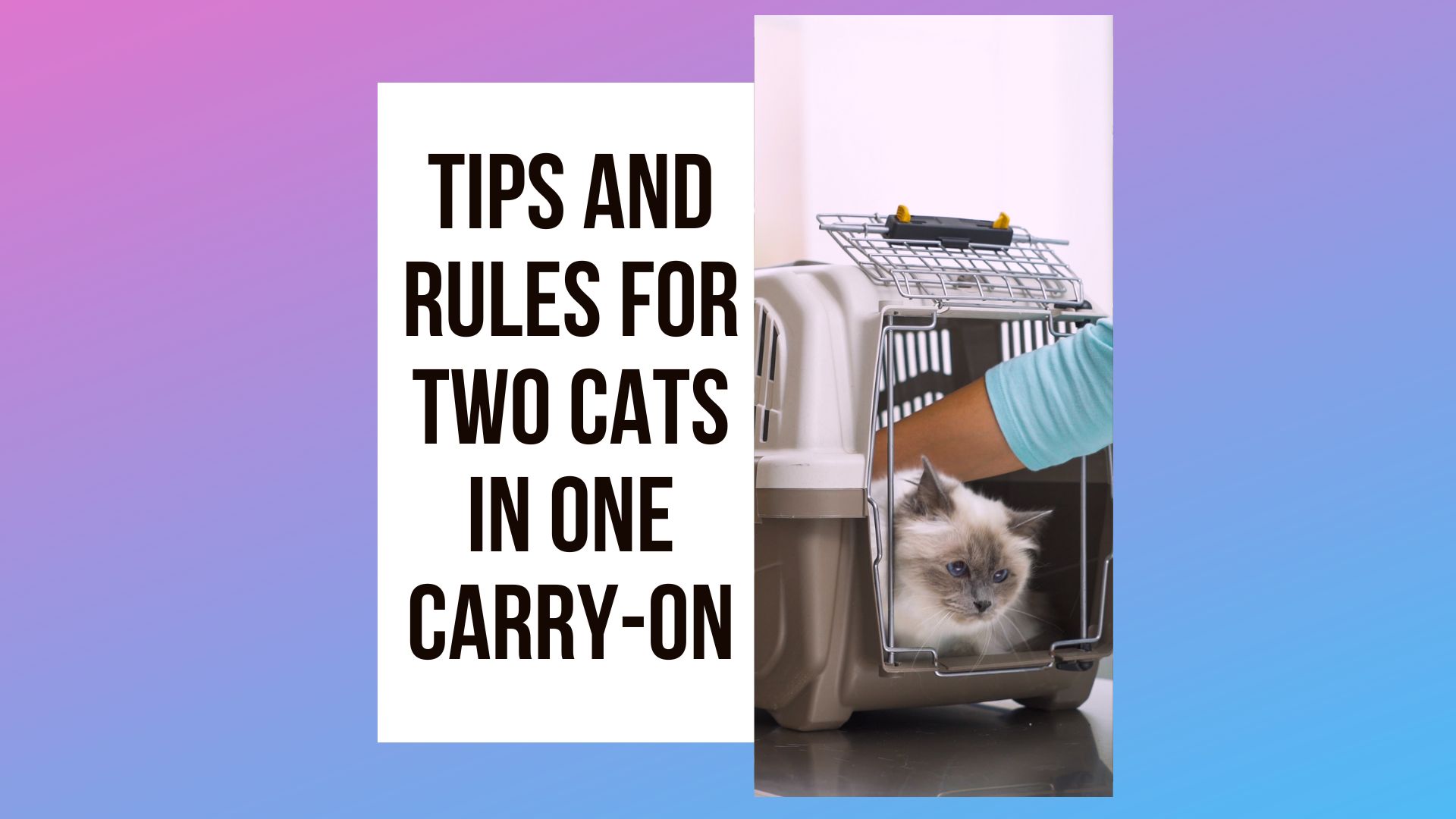
Can You Put Two Cats In One Carrier On A Plane? How can I fly with 2 cats alone? Can 2 cats share travel in one carrier? According to the U.S. Department of Transportation, airlines report that over two million pets and live animals fly in the United States every year.
There are many reasons to travel with your pet, including long-term vacations or relocating for a new career. Whatever your motivation, there are a lot of questions about air travel that are raised by pet owners about carrier safety.
Placing two pets in one carrier may not be a possibility for some pet owners, especially those with large dogs. But, if you have two cats, you may be considering your options.
Could two cats fit in the same carrier? Would they be comfortable and safe? Most importantly, is it legal? In short, the answer depends on a few factors.
To find out for sure, you should begin this journey with your vet.
The First Step Is Visiting Your Vet
Before you commit to your travel plans, be sure to visit your veterinarian. Your vet will give your pet an exam to ensure he or she is both healthy enough to travel and does not have any signs of illness or diseases that may pose threats to other animals or people.
Furthermore, if you are traveling with a kitten, she or he must be at least 8 weeks old before boarding the flight.
In addition, some airlines require a document called a Certificate of Veterinary Inspection . This may also include any vaccinations that may be required by the state or country in which you are planning to visit.
You can check out the American Veterinary Medical Associate for a current list of U.S. states that require this document .
Even if the state or country you are traveling to does not require this form, it may still be a good idea to carry your pet’s vaccination records and tags with you.
In the event, that something goes awry (your pet bites another person, or gets lost), you’ll be glad you have proof of your pet’s health!
What Are Your Options When Traveling By Airplane With Your Cat?
When traveling by airplane, you may notice that there are actually two ways you can arrange your pet to travel with you: in cargo or as a carry-on.
Typically, animals traveling by cargo are over 11 inches tall or weigh over 15 pounds. While this may seem more like shipping your pet, it’s actually quite safe and can be less stressful for the owner.
In either option, your cat must remain in the carrier for the entire flight. That means you cannot open the carrier door to pet or soothe your kitty, so be sure he or she will be comfortable inside.
One tip you may find useful is allowing your cat to explore or even sleep inside the carrier before your scheduled flight.
Let the carrier sit on the floor or in your kitty’s favorite spot for a few days or weeks leading up to your trip. If she or he is comfortable enough in the carrier in your home, it can make take-off a much more enjoyable experience!
How Much Will It Cost to Fly With Your Cat?
Typically, the carrier will count as a carry-on item for your trip, so be sure to pack accordingly. Be sure it will fit the maximum size requirements specified by your airline and ask if there are any additional fees before the day of your flight.
The top 9 airlines in the U.S. cost breakdown for each pet (one-way) are:
- Hawaiian Airlines: $35-175
- Frontier Airlines: $75
- Delta: $75-200
- Southwest: $95
- JetBlue: $100
- Alaska Air: $100
- Spirit: $110
- American Airlines: $125
- United Airlines: $125

How Many Total Cats Can I Bring?
Actually, each airline has its own rules regarding two cats in one carrier. It should also be noted that some airlines only allow certain pets from boarding the cabin of the plane at all.
For example, a squirrel flying Frontier Airlines was recently banned from flying in the cabin, and a hedgehog could not find any airline that would allow her to fly with her owner.
Thankfully, cats are a more common household pet that every commercial airline in the U.S. allows on board. Still, pet policies differ between each airline.
If you are traveling with more than 2 cats, you should be aware of any limitations the airline has on maximum pets per flight, per traveler:
- Hawaiian Airlines: 1-2 (One Carrier Per Passenger, See Below)
- Frontier Airlines: 10
- Southwest: 6
- Alaska Air: 5
- American Airlines: 7
- United Airlines: 10
Now You Know The Cost and Rules, Can Two Cats Travel Together?
As for each airline’s policy on multiple cats in the same carrier, this generally varies between each airline. In addition, each airline sometimes allows for special circumstances for exceptions to the rule.
It is also important to note that even if the airline allows more than one cat per carrier or kennel, the carrier must be large enough to fit them both comfortably.
Each airline’s most updated webpage is linked to this list, where you can find all the necessary info for pet limitations and rules:
- Hawaiian Air : One adult cat per kennel, or two kittens if they are between 8 weeks and 6 months old
- Frontier Airlines : One adult cat per kennel, or two kittens if they are between 8 weeks and 6 months old
- Delta : One adult cat per kennel, or two kittens if they are between 10 weeks and 6 months old
- Southwest : Two cats per kennel allowed
- JetBlue : One adult cat per kennel. The pet and the carrier must not exceed 20 lbs.
- Alaska Air : One adult cat per kennel. The pet and the carrier must not exceed 20 lbs.
- Spirit : One adult cat per kennel. The pet and the carrier must not exceed 40 lbs.
- American Airlines : Two cats per kennel allowed
- United Airlines : One adult cat per kennel
Pet air travel still has a few exceptions. Even if the airline allows two small cats in the same carrier, the airline could refuse to allow your pets to travel together.
This could happen if your cats do not have sufficient air flow or there is not enough room for them to move comfortably within their carrier.
Lastly, even kitties who are the best of friends at home could turn on each other when under stress. In this case, separating your cats into two carriers is for their own safety and well-being.
Should You Call the Airline?
This comprehensive guide has been able to walk you through cost, limitations, and more. So you may be wondering if you’ll still need to call the airline. In short, the answer is yes.
You’ll need to pay for the airline fees for your pet in advance, which may include per pet and per carrier charges. This could vary if the airline allows for multiple cats in the same carrier.
In addition, you’ll want to make sure you are putting your kitty either in cargo or in the cabin, depending on how you decided previously.
There are also a few more limitations you should review before confirming your travel plans. Some airlines restrict certain cat breeds from boarding their air crafts at all.
Exotic cats like Burmese, Himalayan, and Persian are all included in this list. If you have not yet called the airline, now is a great time to confirm if your cat’s breed is on this controlled list.
In addition, some airlines require pets to have a harness or leash (even cats!), ID tags, and collapsible water dishes to keep your pet hydrated while on the flight. These vary based on the airline and also by the length of your flight.
Lastly, it is best to talk with the associates in the event any of their rules or regulations have changed suddenly.
The airline may have temporarily halted all pet travel or may have updated their policies on pet safety because of a recent extenuating circumstance.
By now, you should feel extremely ready for your upcoming flight with your cats. Now that you are set, it is time to prepare your feline friends!
The first step in making your pet ready for take-off is to create a comfortable and safe atmosphere in the carrier. If you are not putting both your cats in the same kennel, make sure each carrier is fitted as outlined below.
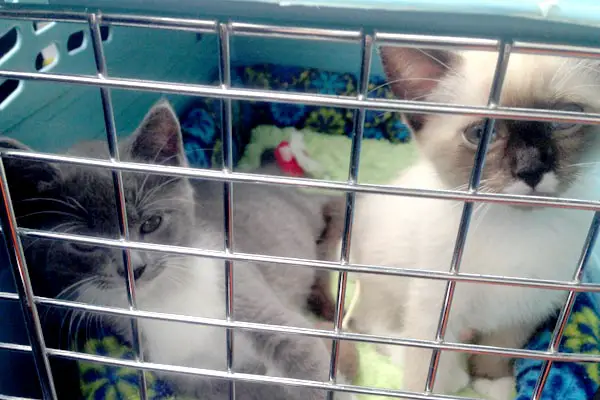
How Should You Prep Your Crate Or Carrier?
Typically, plastic or mesh doors are prohibited from both carry-on and cargo travel. In addition, your pet should be able to sit and stand comfortably in the crate, meaning there are at least 2-3 inches of clearance above their heads and they can lay down with their front legs extended.
You must also line the crate with an absorbent material to help if your pet needs to potty. This is especially important for long flights or if your pet has never flown before, as he or she may release their nervous bladder.
Lastly, you should be certain no toys or stuffed animals are in the carrier or crate with your cat. Once you’ve arrived at your final destination, your cat may seem a little stressed or upset.
Now you can give your cats food or water or any comforting toys. After a few hours, he or she should start to calm themselves into a normal routine.
Once your carrier is safe and ready for take-off, you should start familiarizing your cats with it. Even the most well-adjusted pet passengers can benefit from little stress-reducing tips!
- How To Travel With A Cat? 7 Safety & Low-Stress Tips
Now That You Know, How Do You Prepare Your Cat?
When traveling with your pet, it is always a good idea to review best practices and guidelines along with rules and regulations.
Pets On Airplanes is a leader in educational videos aimed at promoting safer airline travel for all pets. These tips include supply lists, advice, and more. Their library contains a vast variety of videos for both carry-on and cargo travel.
In this library, one video features few useful tips to keep your kitty companion comfortable, including food and water, absorbent pads for urine and feces, and the importance of having a recent photo of your cat for the airline.
You can view the short YouTube video in its entirety.
You Are Ready For Takeoff!
When you are looking to travel with your kitty companion, the rules can seem a bit complicated. It is important to remember that airline policies are set in place for both the safety of guests as well as the comfort of your animal travelers.
However, passengers who do their research and follow proper procedures are sure to make the journey much less stressful for both themselves and their feline friend.
If you have more questions, the best thing to do is to contact the airline’s customer service team. Once you are well-versed in the rules of travel for your pet, PetMD offers a quick 5-step guide on how to calm your cat during the flight.
You may also want to reach out to your vet for any tips or tricks that may help your kitty feel more at ease!
Last but not least, if you’re wondering how this experience might look for you, check out this seasoned traveler as she shares her experiences of flying with her cat using Delta Airlines in a short, informative YouTube video.

Hi, This is Alexa, and I love cats. This Website is a Complete Journal about how to travel with a cat and other information about Cat Health, Cat Training, Cat Behavior, Cat Foods and more. I hope you find it useful.
- Travel with pets
Everything You Need To Know About Traveling With A Cat On A Plane
Are you planning on flying with your cat on a plane and feeling swamped trying to figure out confusing airline pet policies, picking the best airlines for traveling with cats, and figuring out what to add to your packing list? Fear not, as we’ve got you covered.
As much as we love our pets, flying with your cat internationally or domestically can be a stress-inducing experience, especially if it’s your first time traveling with your beloved companion. Here, we’ll break down all you need to know about flying with animals to help you get as prepared as you can be for your flight and provide you with all the must-know information.
- What Are The Requirements For Flying With A Cat?
Rules and regulations for traveling with cats can differ based on the airline and destination you’re traveling to. It’s also worth remembering any stopover locations can have requirements that deviate from your final destination.
For this reason, it’s always best to ensure you’ve researched the regulations for your specific airline and destination before booking your flights. That being said, there are many commonalities between pet policies from various airlines and countries that you can expect to see.
One of the documents you’ll likely be asked for is a valid health certificate for your cat, provided by a certified vet and usually issued up to 10 – 30 days before your departure. During your visit to the vet, the staff will examine your cat and determine if it’s safe for your kitty to travel. If they think your cat is in good health, has up-to-date vaccinations, and is safe to fly, they’ll give you a certificate with relevant details about your pet’s age, size, and health to present to the airline before your flight.
This step is especially important if your cat must travel in the hold. Anyone planning an extended vacation may need to obtain another health certificate for their return flight, as they are generally valid for just 30 days.
Another key requirement to keep in mind when you’re planning is finding the appropriate kennel for your cat. Usually, carriers must be small enough to fit under the seat if you’re flying with your cat in the cabin but large enough that your cat can stand, turn, and lie down comfortably. The rules for travel with animals in the hold can differ, but we’ll give you all the details on kennels and crates later.
Destination
Possibly one of the more tedious must-dos for flying with your cat is getting to the bottom of the requirements for your holiday destination. Though many countries are relatively straightforward to travel to with pets, you’ll find that traveling with your cat to Hawaii can be much more complicated than traveling with a cat to Mexico due to Hawaii’s stricter customs regulations that require pets to be quarantined for some time after landing.

- How Much Does It Cost To Fly With A Cat?
- Book a flight for you and your cat on Delta Airlines.
- Experience a plane journey alongside your cat with American Airlines.
- Fly comfortably with United Airlines’ cat-friendly flights.
- Secure your spot on a Lufthansa Airlines plane for you and your cat.
- Take to the skies: bring your cat aboard a KLM Airways flight.
- Embark on a journey with your cat via Virgin Atlantic’s flights.
- Plan your trip: cat-friendly plane travel on Etihad Airways.
- What Are The Rules For Flying With A Cat?
You’ll find the rules for flying with your kitty can change a little depending on whether your cat flies with you in the cabin or as cargo.
Pet owners will be glad to learn that many airlines will allow your cat to fly in the cabin. Cats traveling on board with you can be placed in either a hard-sided or soft-sided kennel that fits underneath the seat, and your pet must remain inside the carrier for the duration of the flight.
While the exact dimensions of pet crates may vary a little between airlines, the maximum size permitted on flights is generally 17.5″ X 12″ X 7.5″ for hard-sided crates and 18″ X 11″ X 11″ for soft-sided carriers. If your chosen airline only permits your cat to travel as checked baggage or cargo, the maximum dimensions tend to be much higher, though this generally won’t be necessary for cats unless they are a larger breed. However, only hard-sided kennels can go in the hold for safety reasons.
Most airlines count your cat and their carrier as your hand luggage, so you’ll likely only be permitted to bring a personal item like a small backpack or handbag on the plane with you.
In addition to the health certificate required by many airlines, you must ensure your cat is microchipped and has had any relevant shots, with rabies vaccinations being the most common requirement airlines will look for.
- How Hard Is It To Fly With A Cat?
Thinking about traveling with your cat can send you into a frenzy, but it doesn’t have to be as daunting as it seems with adequate preparation.
To make your flight as smooth as possible, starting the planning process earlier than usual is essential. It’s best to get in touch with your airline before booking to ensure you’re aware of the current safety requirements and that there’s availability for your cat, as carriers usually only allow a limited number of pets per flight on a first-come, first-served basis.
Once you’ve secured your cat’s spot on the flight, you can then work on checking off the airline’s list of requirements, such as finding a suitable kennel, getting any necessary vaccinations, and booking your cat in for a health check shortly before your departure.
For many cat owners, one of the biggest concerns is your pet’s comfort and safety during a flight. Luckily, there are plenty of things you can do to keep your cat’s anxiety and stress to a minimum, which we’ll outline for you later.
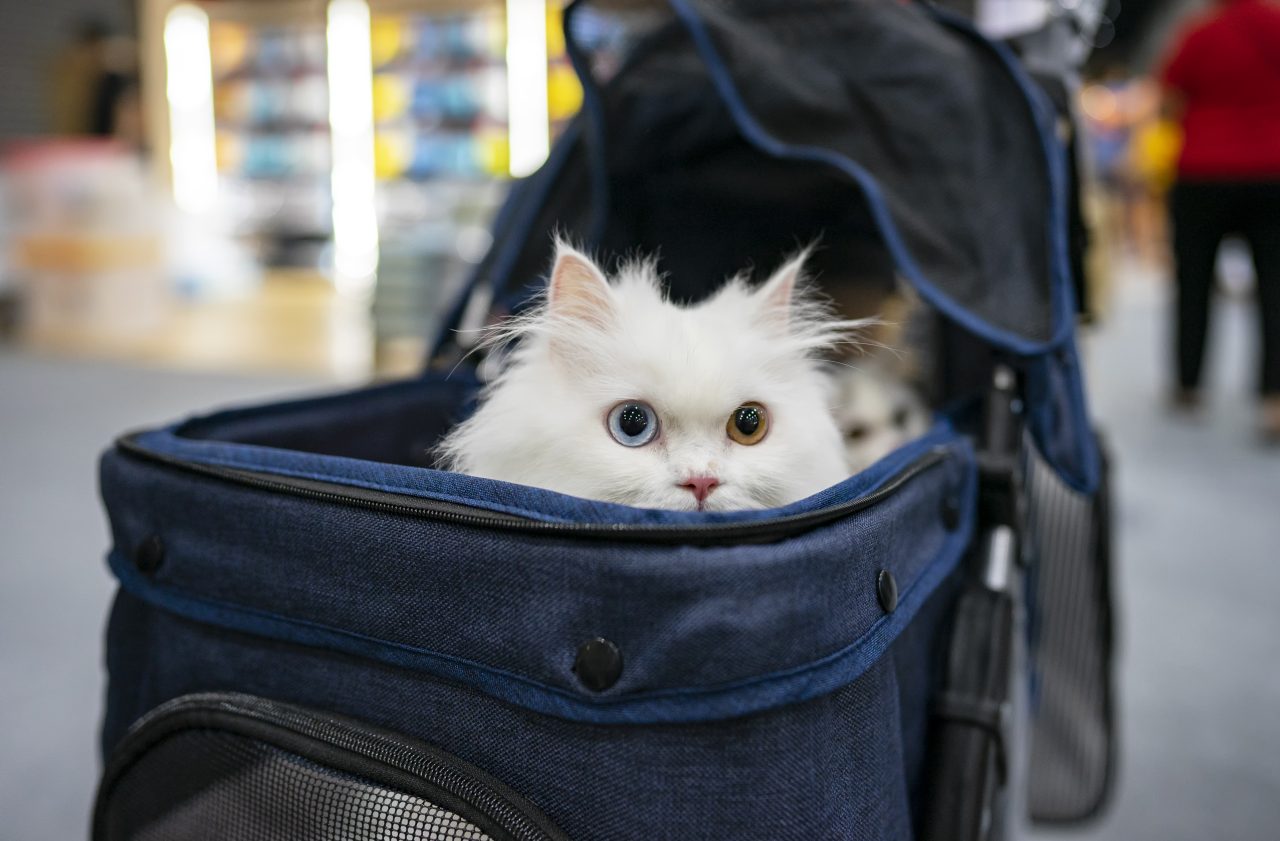
- What Is The Difference Between Flying With Your Cat In The Cabin Vs. In The Hold?
Flying with your cat in the cabin is the preferable option for many owners, but there are pros and cons to both the cabin and the hold. Unlike traveling with large dogs on planes, most cats can fly in the cabin.
If your cat joins you in the cabin, you’ll feel more at ease as you can comfort and check on your pet to keep them relaxed. You’ll usually be able to check in at the airport as normal and pay the required fees before heading to security. After the flight, once you’ve collected any checked luggage, you can leave the airport quickly. However, some animals can find the volume of people and loud noises in the airport and on the flight nerve-wracking, so this might not always be the best option.
The procedure is quite different for cats traveling in the hold as cargo or checked baggage. When you arrive at the airport, there’s usually a drop-off area where you’ll have to take your cat after you’ve paid for your pet at the check-in desk.
Before this point, you’ll need to make sure your cat has all the travel essentials in their kennel. In the hold, your pet’s crate must be hard-sided, leak-proof, and well-ventilated, with suitable bedding and absorbent padding in case they need to go to the toilet.
Clearly label the kennel with the words ‘live animal’ on the top and sides, and ensure they have sufficient food and water that airline staff can supply from outside the crate. You must attach a collar and leash to the outside of the carrier, as they are not permitted to be worn on the flight as they are a choking hazard.
Once you’ve landed, you’ll pick up any checked luggage and go to the airport’s pick-up area, where you can reconvene with your pet an hour or two after the flight.
- What Are The Travel Requirements Of Different Airlines?
Airline Cat Policies, Rules, And Limitations
Most airlines cap the number of pets that can fly in the cabin. For example, if you’re flying with your cat with Delta, four pets are permitted per flight, while for those flying with their cat with JetBlue , you’ll find six pets in total are allowed on each flight.
Another rule that varies is the amount of pets per passenger. Often, airlines will allow one carrier per passenger, with two pets in the carrier, accepted if there’s ample space for the animals. However, some airlines restrict this to one animal per crate or require the two animals to be the same breed. If you’re flying with your cat with United, for example, you can only have one pet per carrier, while anyone flying with their cat with Southwest can have two pets of the same species per kennel. On the other hand, pets can only travel in the hold if you’re flying with a cat on American Airlines.
Depending on your cat’s breed, you may find they are prohibited from flying with some airlines for health and safety reasons. Short-nosed felines like Himalayan and Persian cats are banned from most flights as they may struggle to breathe due to the changes in air pressure. Aggressive, older, or unwell cats are often not allowed to fly; the same goes for pets under eight weeks old.
What Are The Most Cat-Friendly Airlines?
Just as there are some cat-friendly destinations with more relaxed customs protocols than others, some airlines tend to have more lenient pet policies than their competitors. We’ve rounded up some of the most cat-friendly U.S. airlines from the friendliest to the least friendliest.
- What Are The Must-Know Tips For Traveling With A Cat?
How To Pass The Security Check With A Cat?
Cats flying in the cabin will go through security with you. Though your cat must remain in their carrier when in the airport and on the flight, you must take your pet out of the kennel when you’re passing through security. The staff will inform you when you need to remove your cat; at this point, the kennel will go through the X-ray machine while you hold your cat as you walk through the checkpoint.
Once you get the go-ahead from security staff, you can put your cat back in their crate. Solid and wet food are permitted in-flight, and it’s a good idea to have them ready for staff to examine as you head to security.
How To Prepare A Cat For A Flight?
Your pet’s comfort is paramount when preparing for a flight with an animal. To help keep your cat at ease during the flight, starting crate training well in advance is a good idea, mainly if your cat is not used to spending extended periods in a carrier.
Once you’ve found the right crate for your cat that aligns with the airline’s requirements, the next step is to make it an inviting and relaxing place for your four-legged friend. Adding accessories like cozy bedding and easy-to-use water and food containers will make their crate a safe space.
A few months before your flight, help your pet adjust to their carrier, leaving it open at home, encouraging them to lie inside, and carrying them inside for short periods, gradually building up to longer timeframes. Make sure they have plenty of time to learn how to eat and drink from the containers, as they can differ from what your pet is used to. If your airline permits it, including a blanket that smells like you or your home is a great way to calm your cat’s nerves, which is especially relevant if your pet is traveling as cargo.
Unlike highly socialized pets, many cats may not be accustomed to large crowds and loud spaces, and airports can cause them a lot of stress if it’s completely foreign to them. For cats that fall into this category, exposing them slowly to busy environments in the lead-up to your flight will make this experience easier for your feline friend.
How Do I Book A Flight When Traveling With A Cat?
Much like flying with other animals, traveling with a cat is generally best organized by booking directly with the airline over the phone. Often, airlines do not allow you to add pets online, and speaking with a customer service agent will also help you to be aware of the most up-to-date requirements.
When you’re informed of the airline’s rules, you can book your flight before adding your cat to the booking. Some airlines enforce specific time frames for adding pets, so you might find you can’t book your cat until 14 days in advance or no less than 24 hours before departure.
What Should I Know If I’m Flying With My Cat For The First Time?
Many pet owners are unsure how to approach feeding their pets when flying on a plane for the first time with their beloved companion. To limit the chance of your cat feeling nauseous during the flight, feeding your cat no less than four hours before flying is advisable, as flying on a full stomach could make your cat more prone to motion sickness.
However, a supply of food is allowed on the flight, so you can feed your pet during the journey if you feel they’re hungry.
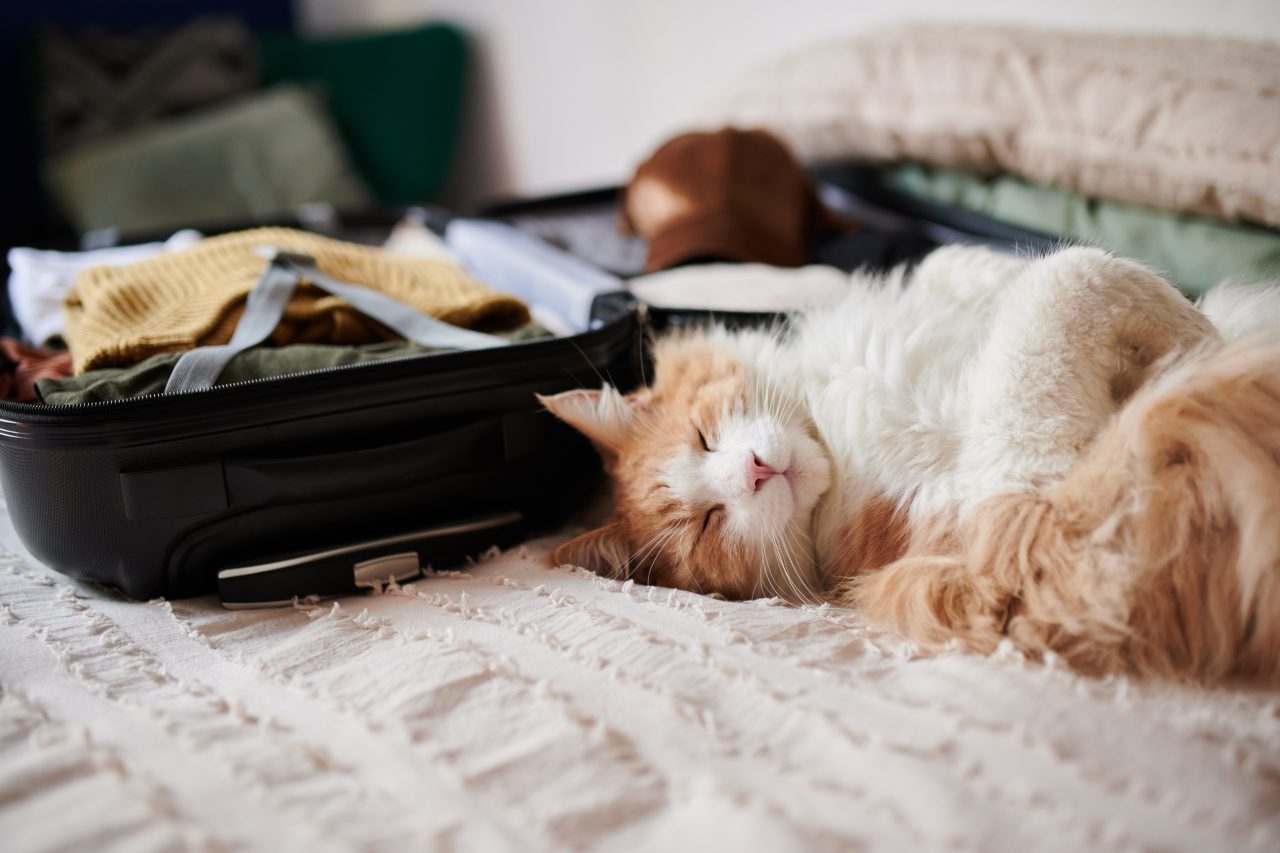
- How Can I Prepare For Flying With My Cat Internationally?
Depending on your flight routes, quarantine may or may not be something you’ll encounter. Suppose you’re traveling with your cat to Canada or Mexico or traveling with a cat to Europe, particularly countries within the EU. In that case, you most likely won’t have to worry about your cat being quarantined.
As previously mentioned, Hawaii has some of the more stringent customs regulations you’ll likely confront. Give yourself plenty of time to research before your flight, and ensure your cat has received two rabies vaccines, a valid health certificate, and is microchipped. If you meet these requirements, you can apply for the 5 Days Or Less quarantine program, keeping the number of days your cat will be separated from you to a minimum.
Some other countries requiring quarantine for cats include Australia, New Zealand, Japan, and Singapore.
Again, the documents needed for your flight will depend on your airline and route, but the following are commonly required:
- A health certificate from a certified vet, often called a pet passport, usually less than between 10 and 30 days before your flight.
- Confirmation of necessary vaccinations.
- Details of your cat’s microchip (15-digit chips are preferable as they are more widely accepted).
Preparations
Here’s a quick run-through of some of the most important things you should add to your to-do list before your trip.
- Contact the airline to confirm your cat is eligible to fly and to be aware of the latest regulations before booking.
- Pick up all the travel accessories well in advance and give your cat time to get used to their crate and feeding containers.
- Research the protocols of your final destination and stopover locations.
- Book your pet for a health check and assess if they need additional vaccines.
- Find out the location of drop-off and pick-up areas in the relevant airports if your cat will be traveling in the hold.
After Arrival
As most cats can travel in the cabin, there’s usually little to do once you arrive. Some countries may conduct a short examination of your cat, but it’s unlikely once all the necessary documents are provided.
Cats traveling as cargo must be collected from designated pick-up areas an hour or two after landing once you have passed through baggage claim, where you’ll likely find other passengers who may be flying with a large dog or exotic animals.
Pet owners traveling to countries requiring quarantine must follow a different procedure.
Most countries tend to require proof of rabies vaccinations, but other countries sometimes have specific additional requirements. For example:
- Cats entering Australia are recommended to have the FVRCP shot.
- Ireland, Malta, Finland, Norway, and Northern Ireland in the UK require tapeworm treatment.
Want more interesting tips and information on traveling? Read more Kiwi.com articles!
- Introduction

Frequently asked questions
- Travel with kids

Pine Knoll Lodge & Cabins
How To Travel With Two Cats
Traveling with two cats can be a challenge, but it’s definitely doable. Here are a few tips to help make the trip go smoothly.
1. Make sure your cats are comfortable with each other. If they’re not used to being together, they may get into a fight.
2. Get them used to traveling in a carrier. This will help keep them safe and secure on the trip.
3. Make sure you have plenty of food and water for them.
4. Bring along their favorite toys and blankets to help keep them comfortable.
5. If you’re traveling by car, make sure you have a pet carrier that’s big enough for them to move around in.
6. If you’re traveling by plane, make sure you check with the airline ahead of time to see if they allow pets in the cabin.
7. Make sure you have your cats’ medical records and any necessary vaccinations up to date.
8. If you’re going to be gone for a while, make sure you have someone to take care of your cats.
Traveling with two cats can be a bit of a hassle, but it’s definitely doable. Just follow these tips and everything should go smoothly.
- 1 Can you travel with 2 cats?
- 2 How do you travel long distance with two cats?
- 3 How much is it to fly with two cats?
- 4 How do you transport two cats in a car?
- 5 Can I put 2 cats in a carrier?
- 6 Which airlines allow 2 cats in cabin?
- 7 How long can a cat go without a litter box?
Can you travel with 2 cats?
Can you travel with 2 cats? The answer is yes, you can travel with 2 cats, but there are some things you need to know first.
First, you’ll need to get your cats used to being in a carrier. Start by placing the carrier in a quiet, comfortable spot in your home and feeding your cats their meals inside the carrier. Once your cats are comfortable going in and out of the carrier, you can start to take them for short car rides.
If you’re flying with your cats, you’ll need to purchase a pet carrier that meets the requirements of the airline. You’ll also need to make sure your cats are up to date on their vaccinations and have a health certificate from your veterinarian.
Before you leave on your trip, make sure you have all of the necessary supplies for your cats, including food, water, a litter box, and toys. You may also want to pack a blanket or towel that your cats can use as a bed.
If you’re going to be staying in a hotel, be sure to ask if they allow pets. Some hotels do not allow pets of any kind, while others charge a fee for pets.
Travelling with cats can be a lot of work, but it’s definitely worth it to be able to take your furry friends with you on your travels.
How do you travel long distance with two cats?
Traveling with two cats can be a bit daunting, but with a bit of preparation it can be a relatively easy process. Here are a few tips to help you travel with your furry friends.
First and foremost, make sure your cats are comfortable with traveling. If they are not accustomed to car rides, take them on a few short trips before embarking on a long journey. This will help them become more comfortable in the car and reduce the risk of them becoming agitated or stressed during the trip.
If you are traveling by plane, be sure to check with the airline ahead of time to see if they allow cats to travel in the cabin. Many airlines do, but there may be a fee associated with bringing your cats on board.
If you are traveling by car, be sure to pack a cat carrier for each cat. Make sure the carrier is big enough for your cat to comfortably sit and stand in, and be sure to include a litter box, food, water, and any other necessary supplies.
Along with the cat carriers, pack a few extra supplies in case of emergencies. This includes a first-aid kit for cats, a bottle of water, and a few snacks.
Finally, be sure to pack your cats’ favorite toys and blankets to help keep them calm and comfortable during the trip.
How much is it to fly with two cats?
Flying with pets can be expensive, and it can be especially costly to fly with multiple animals. Here’s a breakdown of how much it will cost you to bring your furry friends on a plane.
The first thing you need to know is that different airlines have different pet policies. Some airlines allow you to bring a pet in the cabin for a fee, while others require your pet to travel in the cargo hold. Furthermore, some airlines have weight restrictions for pets in the cabin, while others have restrictions on the number of pets that can be brought on a plane.
If you’re flying with a pet that needs to travel in the cargo hold, the cost will vary depending on the airline. Some airlines charge a flat fee, while others charge per pound. In general, the cost to fly with a pet will be anywhere from $50 to $200.
If you’re flying with a pet that needs to travel in the cabin, the cost will generally be around $100. This fee may be higher or lower depending on the airline and the weight of the pet.
So, how much is it to fly with two cats? Generally, the cost to fly with a pet will be between $50 and $300.
How do you transport two cats in a car?
If you’re traveling with two cats, it’s important to take some precautions to make sure they’re safe and comfortable in the car. Here are a few tips:
1. Make sure your cats are properly secured. Cats can be very unpredictable in the car, so it’s important to make sure they can’t escape or get injured in a collision. You can use a harness and leash to keep them safe, or put them in a carrier.
2. Make sure your cats have plenty of food and water. cats can get dehydrated very quickly, so make sure they have plenty of fresh water to drink. You may also want to bring along some of their favorite food to keep them happy.
3. Keep them cool. Cars can get very hot in the summer, and cats can overheat quickly. Make sure your cats have a place to escape the sun, and consider bringing a cooling pad or towel to keep them cool.
4. Keep them calm. Some cats can get very agitated in the car, and may try to escape or scratch you. Try to keep them calm and relaxed by playing with them or giving them treats.
With a little preparation, transporting your cats in the car can be a breeze.
Can I put 2 cats in a carrier?
Yes, you can put two cats in a carrier as long as they are comfortable in close quarters. However, if one of the cats is aggressive or territorial, it may be best to separate them.
Which airlines allow 2 cats in cabin?
There are a few airlines which allow passengers to travel with two cats in the cabin. These airlines are:
Alaska Airlines
British Airways
Delta Airlines
Hawaiian Airlines
JetBlue Airways
KLM Royal Dutch Airlines
Virgin Atlantic
Passengers travelling with two cats in the cabin must ensure that the cats are in secure pet carriers that can fit under the seat in front of them. The pet carriers must also have a clear label that reads “Pets”.
How long can a cat go without a litter box?
This is a question that many people have, and the answer is not always the same. Some people say that a cat can go up to two weeks without a litter box, while others say that a cat can only go up to five days without a litter box. The bottom line is that it really depends on the individual cat.
Some cats are very clean and will not go more than a day or two without using a litter box. Other cats may be more prone to going outside the box, and may not be as clean. If you have a cat that is not using the litter box, it is a good idea to take them to the vet to make sure there is not a medical problem causing the behavior.
One thing to keep in mind is that if you are going to be gone for a while and your cat is not used to being left alone, it is a good idea to put them in a kennel or somewhere where they will have access to a litter box. This will help keep them from having an accident in your house.
Related Posts
Zip lock travel bag, z2 auto travel cpap machine reviews.

Our Pet Experts
The survival guide to traveling cross-country with your cats.
by Kim Campbell Thornton
Published on March 14, 2016
Safety First
When nature calls, exercise on the road.
- How People Who Travel With Cats Pull It Off
- Teach Your Cat to “Stay” On Command — Really!
- 10 Strange Cat Behaviors Explained
- Pet Travel Trends: New Laws, Transportation Options and More
- Car Travel With Cats: What You Should Know
Related articles
Dr. marty becker's top 30 pet products of 2011, 5 small dog breeds this vet would like to see more of, meet the 4 cat burglar breeds who like to swipe your stuff, top 10 holiday pet pics, intestinal parasites: the squirm-worthy side of living with dogs, teach your dog to sit when you stop.

Mastering Long-Distance Car Travel with 2 Cats: A Comprehensive Guide

When traveling with two cats in a car for long distances, it’s important to keep them secured in a proper carrier. The carrier should be sturdy with good ventilation and room for both cats to be comfortable. Ensure it’s secured properly to prevent movement.
Next, considering your cats’ comfort, bring along their favorite blankets/toys to make them feel at home. Regularly schedule breaks to allow your cats to use the litter box, eat, hydrate, and stretch. Remember to never leave the cats alone in a parked vehicle, as this can result in potentially dangerous temperatures.
Lastly, it’s recommended to gradually habituate your cats to car rides before the long journey. This can help minimize their stress during the travel. Also, speak to your vet about any concerns or advice for administering calming medications if your cat gets extremely anxious during travels.
Last Updated on September 22, 2023
As a cat lover and a frequent traveler, I know firsthand how challenging it can be to embark on a long-distance car journey with feline companions. Traveling with cats requires proper planning and preparation to ensure a safe and stress-free experience for everyone involved, and it can be particularly challenging with two cats.
Whether you’re moving to a new home, going on vacation, or visiting family, this comprehensive guide will provide you with all the information you need to know to master long-distance car travel with two cats.
- 1 Key Takeaways:
- 2.1 Get Your Cats Used to Their Carriers
- 2.2 Schedule a Vet Visit Before the Trip
- 2.3 Pack Essential Supplies for Your Cats
- 2.4 Use Feline Pheromone Sprays or Diffusers
- 3 Creating a Comfortable and Safe Car Environment
- 4 Ensuring a Smooth Journey
- 5.1 Car Sickness
- 5.2 Anxiety
- 5.3 Accidents
- 5.4 Entertainment
- 5.5 Image Result for long distance car travel with cats
- 6 Conclusion
- 7.1 Q: How do I prepare my cats for a long-distance car journey?
- 7.2 Q: How can I create a comfortable and safe car environment for my cats?
- 7.3 Q: What are some best practices for a smooth journey with my cats?
- 7.4 Q: How can I deal with challenges that may arise on the road?
Key Takeaways:
- Traveling long distances with cats requires careful planning and preparation.
- Getting your cats accustomed to the carrier and scheduling a vet visit are essential steps before embarking on a journey.
- creating a comfortable and safe environment in the car is crucial to minimizing anxiety and motion sickness.
- Providing plenty of opportunities for rest, exercise, and play can help keep your cats entertained and engaged during the journey.
Preparing Your Cats for the Journey
Traveling with cats can be stressful for both you and your furry friends, especially during a long car journey. However, with proper preparation, you can ensure a safe and comfortable trip for everyone. Here are some tips for getting your cats ready for the road:
Get Your Cats Used to Their Carriers
It’s important to get your cats used to their carriers before the trip. You can start by leaving the carriers out in a familiar area for your cats to explore. Place treats, toys, and bedding inside to make it a comfortable and welcoming space. Gradually increase the amount of time your cats spend inside the carriers, until they are comfortable being in them for extended periods.
Schedule a Vet Visit Before the Trip
Before embarking on a long car journey with your cats, it’s essential to schedule a vet visit. Make sure your cats are up to date on their vaccinations, and get any necessary medications or health certificates. Your vet can also advise you on how to keep your cats calm during the journey and recommend any over-the-counter or prescription medications if necessary.
Pack Essential Supplies for Your Cats
When packing for the trip, make sure to bring all the necessary supplies for your cats. This includes food, water, litter, litter box, toys, bedding, and medication. Bring enough supplies to last the entire journey, plus a few extra days in case of unexpected delays.
Use Feline Pheromone Sprays or Diffusers
Feline pheromone sprays or diffusers can help calm your cats during the journey. These products release synthetic versions of the pheromones that cats use to mark their territory and feel safe. You can spray the carrier or use a diffuser in the car to create a calming environment for your cats.
By following these tips, you can ensure that your cats are ready for the journey and that you have a stress-free trip. Don’t forget to have a few trial runs before the big day to ensure that everything goes smoothly.

Creating a Comfortable and Safe Car Environment
When embarking on a long-distance car journey with your cats, creating a comfortable and safe environment is crucial to their wellbeing. Here are some tips to help you achieve this:
By following these tips, you can create a comfortable and safe environment for your cats during the car journey, helping them stay relaxed and happy throughout the trip.

Ensuring a Smooth Journey
When traveling long distances with your cats, it’s essential to ensure a smooth journey by taking the necessary precautions. Here are some best practices to consider:
Additionally, it’s crucial to securely restrain your cats in the car to avoid potential hazards and distractions while driving. Use a sturdy carrier or harness that is large enough for your cats to stand up and turn around in comfortably. Avoid placing carriers on seats or in the front of the car, as this can be dangerous in the event of an accident.
By following these tips and best practices, you can ensure a smooth and stress-free journey for both you and your cats.
Dealing with Challenges on the Road
While traveling long distance with cats can be a memorable experience, it’s essential to be prepared for potential roadblocks. Here are some common challenges you may encounter and tips for dealing with them.
Car Sickness
Cats are susceptible to motion sickness, just like humans. If your cats exhibit signs of nausea, such as vomiting or excessive drooling, consider speaking with your veterinarian about medication options. You can also try limiting their food intake before the journey and placing them in a carrier with a view of the horizon.
It’s not unusual for cats to experience anxiety during car travel, especially if it’s their first time. To alleviate their stress, consider using calming sprays or playing soothing music. You can also try placing a familiar blanket or toy in their carrier to comfort them.
While accidents can happen, there are steps you can take to minimize their likelihood. Make sure your cats are securely restrained in their carriers and avoid sudden stops or accelerations. It’s also a good idea to pack extra cleaning supplies, such as paper towels and water, in case of accidents.
Entertainment
Cats need mental and physical stimulation, even during long car rides. Pack a variety of toys, such as interactive puzzles or feather wands, to keep them entertained . You can also try setting up a comfortable play area during rest stops.
Image Result for long distance car travel with cats

As I wrap up this comprehensive guide on mastering long-distance car travel with two cats, I hope that you feel more confident and prepared for your upcoming journey. Remember, planning ahead and prioritizing your cats’ well-being will ensure a smooth and stress-free trip for everyone involved.
Whether you’re traveling to a new home, visiting family or embarking on an adventure, taking your beloved feline companions with you can be a wonderful experience. By following the tips and advice outlined in this guide, you can create a comfortable and safe environment for your cats and make cherished memories that will last a lifetime.
Safe travels, happy adventures, and don’t forget to take lots of photos!
Q: How do I prepare my cats for a long-distance car journey?
A: To prepare your cats for a long-distance car journey, it’s important to gradually introduce them to their carriers and make them feel comfortable. Schedule a visit to the vet to ensure they are healthy and up to date on vaccinations. Pack essential supplies like food, water, litter, and medication.
Q: How can I create a comfortable and safe car environment for my cats?
A: Creating a comfortable and safe car environment for your cats involves using secure carriers, providing soft bedding, and ensuring proper ventilation. Consider using calming sprays or medications recommended by a veterinarian to minimize anxiety and motion sickness.
Q: What are some best practices for a smooth journey with my cats?
A: To ensure a smooth journey with your cats, plan for regular rest stops, feeding and litter breaks, and opportunities for exercise. It’s crucial to securely restrain your cats in the car and avoid potential hazards that may cause accidents or stress.
Q: How can I deal with challenges that may arise on the road?
A: Common challenges during long-distance car travel with cats include car sickness, anxiety, and accidents. Consult with your vet for advice on how to handle these issues. Keeping your cats entertained and engaged with toys and treats can help alleviate boredom and stress.
Becky Roberts
Related posts.

Unraveling the Mystery: What Does It Mean When Cats Blink at You?

Do Cats Purr When They’re Sick? Unraveling Feline Mysteries

How Often Should Cats Get Dental Cleaning? Let’s Find Out!

Curious About How Much are Savanna Cats? Let’s Find Out!

Understanding When Do Cats Stop Getting Pregnant – Tips and Guidance

Unveiling Secrets: What Are Cats Favorite Foods?

How Much Are Serval Cats? – Friendly Guide to Pricing

What Essential Oils Deter Cats from Scratching: Tips & Solutions
- Cat Behavior
- Health & Care
How to Travel With a Cat: 14 Vet Approved Tips & Tricks
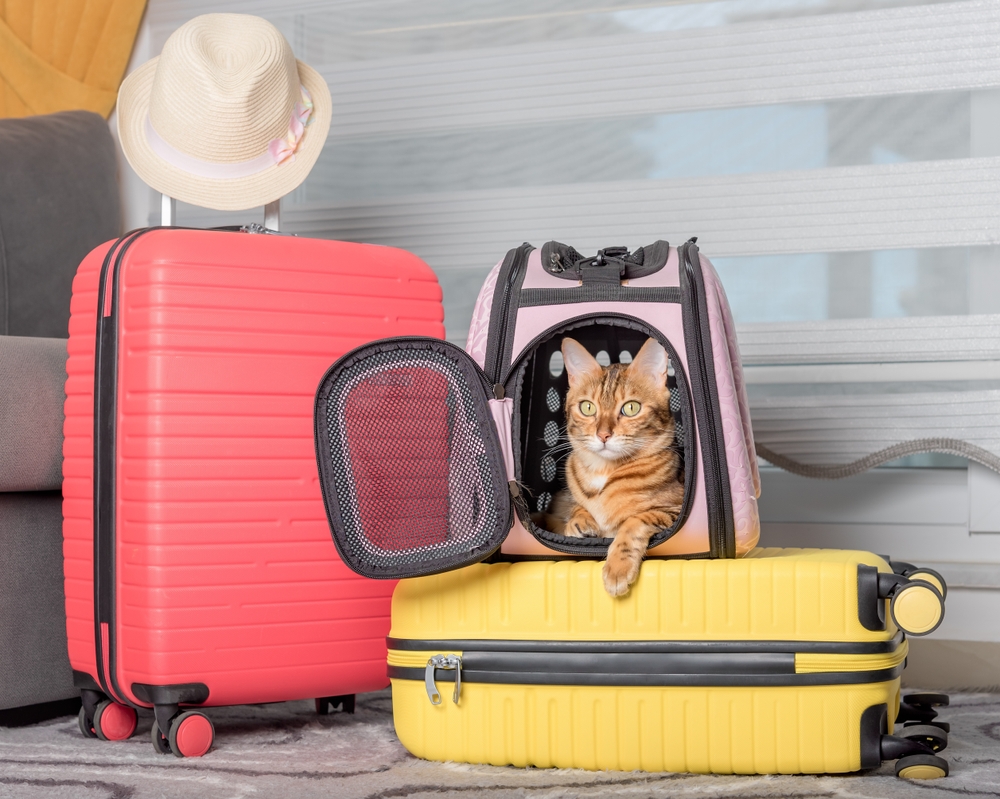
Image Credit: Svetlana Rey, Shutterstock
Last Updated on April 19, 2024 by Catster Editorial Team
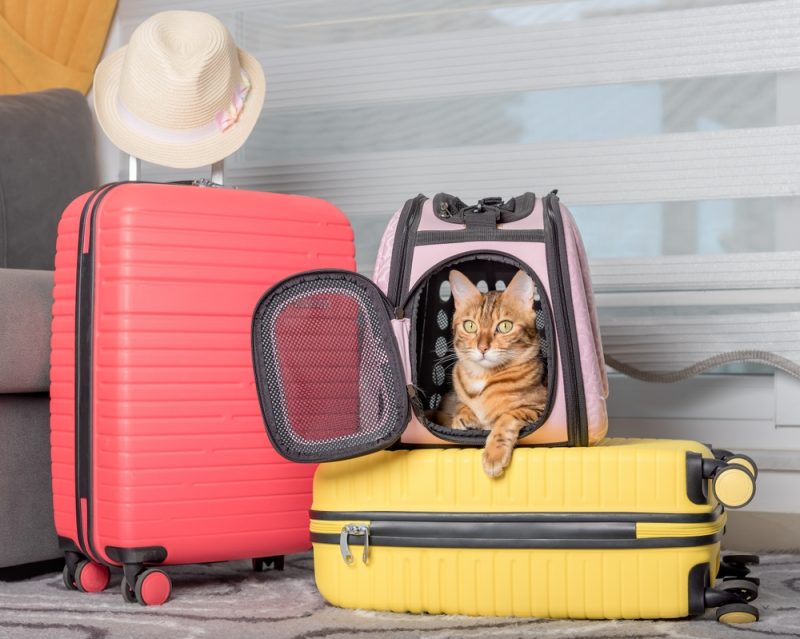
VET APPROVED
REVIEWED & FACT-CHECKED BY
Dr. Amanda Charles
BVSc GPCert (Derm) MRCVS (Veterinarian)
The information is current and up-to-date in accordance with the latest veterinarian research.
Traveling with a cat can be rewarding, but it requires thorough planning. Whether you’re getting ready to drive a short distance and hang out with family or fly somewhere for a relaxing vacation, there are a few factors to consider when traveling with your cat.
Make sure to start the planning process early, particularly if you’re traveling internationally or are going to stay in a hotel during any part of your journey. Below, you’ll find 14 tips and tricks to make your journey with your cat successful.

- The 14 Tips to Travel with a Cat
- 1. Invest in a Good Carrier
Cats should always be restrained when riding in cars, and airports require them to stay in their carriers at all times (except during the security screening process). Airlines have several rules and regulations regarding traveling with pets, including guidelines regarding the size of carriers.
Make sure the carrier you use meets the airline’s regulations and requirements. If you’re driving, the sky’s the limit when it comes to the size of your cat’s mobile palace. Carriers should be sturdy, well-ventilated, secure, and easy to clean. Plastic carriers are usually the best options.
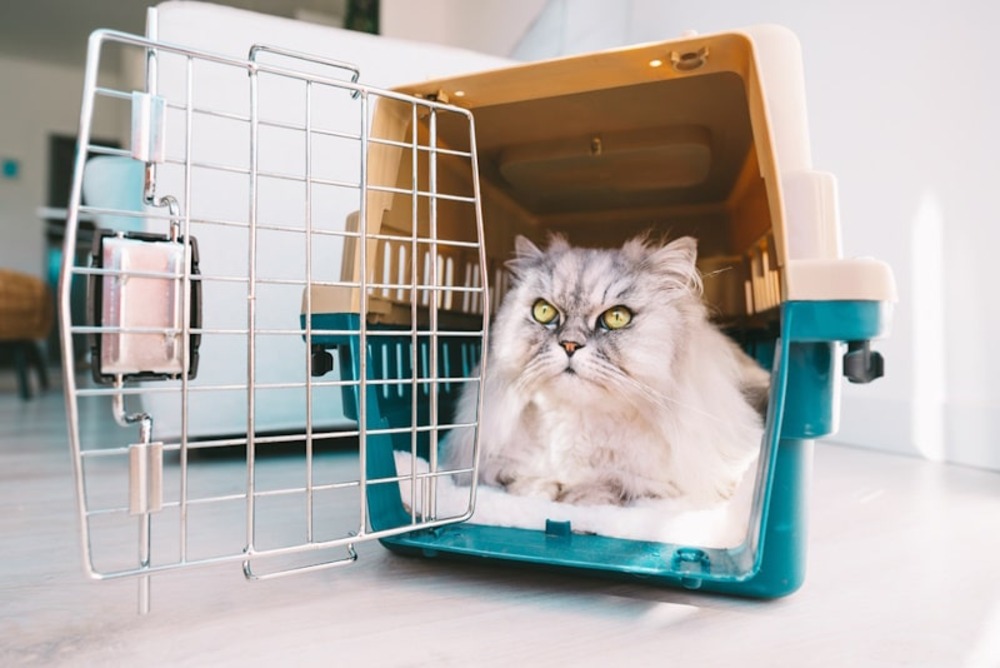
- 2. Give Your Cat Time to Get Used to Their Carrier
Because cats spend so much time in their carriers when traveling, they must feel comfortable in them. Consider leaving your cat’s carrier out so they can get used to it before your trip.
Letting your cat have dinner in their carrier a few times may encourage them to develop positive associations with their traveling home.
- 3. Invest in a Good Harness and Leash
If you visit a rest stop during a road trip, your cat should be harnessed and leashed when they’re away from their carrier to ensure they can’t run off and get lost if they become scared.
Make sure the harness you choose fits properly, and give your cat time to get used to wearing it so they’re ready to do so when you hit the road.
Are you looking for the perfect cat harness? We suggest Hepper's Cat Harness & Leash Set , which includes a nicely designed, machine-washable harness made from soft, sturdy velvet and mesh.

- Escape Proof - Cat leashes and harnesses for walking aren't all equally secure. Our double aluminium...
- Superior Comfort - Our cat harnesses are lightweight, made with premium velvet fabric, breathable...
- Free Extra Strength Leash - You don't need to worry about your cat escaping this harness. This cat...
This harness is easy to put on and take off and features reinforced stitching, reflective stripes, and quick-release buckles. This set also includes a great leash made from durable nylon climbing rope.
At Catster, we’ve admired Hepper for many years and decided to take a controlling ownership interest so that we could benefit from the outstanding designs of this cool cat company!
- 4. Practice Everything
No matter how you’re traveling, your cat must be comfortable entering and exiting the carrier. If you’re flying, you’ll need to take them out of their carrier during the security screening process in the airport.
You can practice taking your cat out of the carrier when you’re around other people to make them more comfortable during the security check. If you plan on driving, consider taking your cat for a few practice rides to get them used to spending time in the car. Make sure to reward them for their cooperation!
- 5. Ask Your Veterinarian for Advice
Some easily stressed cats may benefit from medication to help them stay mellow while traveling. However, sedation isn’t suitable for all cats, and most airlines won’t transport pets who have been tranquilized or sedated.
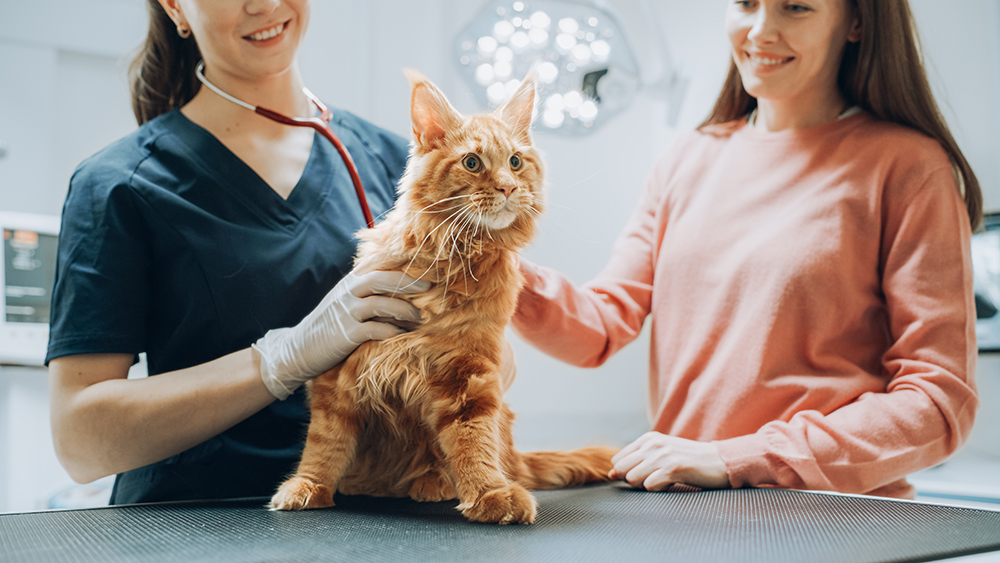
- 6. Have Cleaning Supplies on Hand
Pack a bag with cleaning supplies and plan to have it close at hand while you’re underway in case your cat has an accident and you need to do a bit of on-the-fly cleaning. It’s best to pack paper towels or cleaning wipes, gloves, and baggies for disposal.

- Gentle Care For All Pets - Infused with moisturizing hypoallergenic ingredients & enriched with...
- Deep Cleans From Head to Tail - Tackle the toughest dirt & messes with our extra strong pet wipes...
- Freshness On The Go - Each dog grooming wipes pack contains 30 counts of premium dog wipes that...
It's hard to beat the convenience of pet-safe wipes after a big adventure, between baths, or when cleaning sensitive areas. Our favorite option is Hepper's Wash Wipes, premium wipes designed to safely and gently remove grime from cats and dogs of all ages and sizes. These hypoallergenic wipes are made in the USA and feature moisturizing ingredients to soothe your pet's skin.
- 7. Pack Toys and Blankets
Take a few of your cat’s favorite toys and a well-loved blanket that smells like home to keep them comfortable while away from their territory. Putting a favorite blanket in your cat’s carrier may make being on the road less stressful.
A stuffed toy might look a little different than a traditional cat toy but many felines find them quite enticing. The Hepper Plush Whale serves a dual purpose, featuring a faux fur exterior that mimics prey and a soft interior for cuddling during long cat naps when playtime is over. The best part about it is it's an affordable option for ages, sizes, and conditions. Learn more about why your cat needs a plush here!

- Tailored size even for kittens - the compact size of the whale plush cat toy at 15cm long ensures...
- Catnip Free Cat Toys - Made with top quality plush exterior & cotton interior, it's perfect for cats...
- Peaceful Playtime - No more squeaky cat toys for indoor cats. This stuffed cat toy is perfect for...
At Catster, we've admired Hepper for many years, and decided to take a controlling ownership interest so that we could benefit from the outstanding designs of this cool cat company!
- 8. Consider Portable Litter Boxes
If you’re traveling by car , pack a litter box with some of your cat’s regular litter. Plastic poop bags and a scoop are also essential. If you’re staying at a hotel, check their pet policies thoroughly.
Most hotels that accept cats don’t provide litter boxes and litter. Collapsible litter boxes are ideal for shorter trips and can be folded down and packed.
- 9. Pack Food, Water, Treats, and Medication
If you’re traveling by car, bring enough of your cat’s regular food to keep them happy while you’re away from home. It’s also helpful (and usually mandatory) to pack food and water for your cat while flying, but some cats may be too nervous to eat until you land.
If your cat takes medication, pack enough to last them for your entire trip, and consider putting it in your carry-on luggage to ensure you have access to it even if your checked luggage takes a detour.
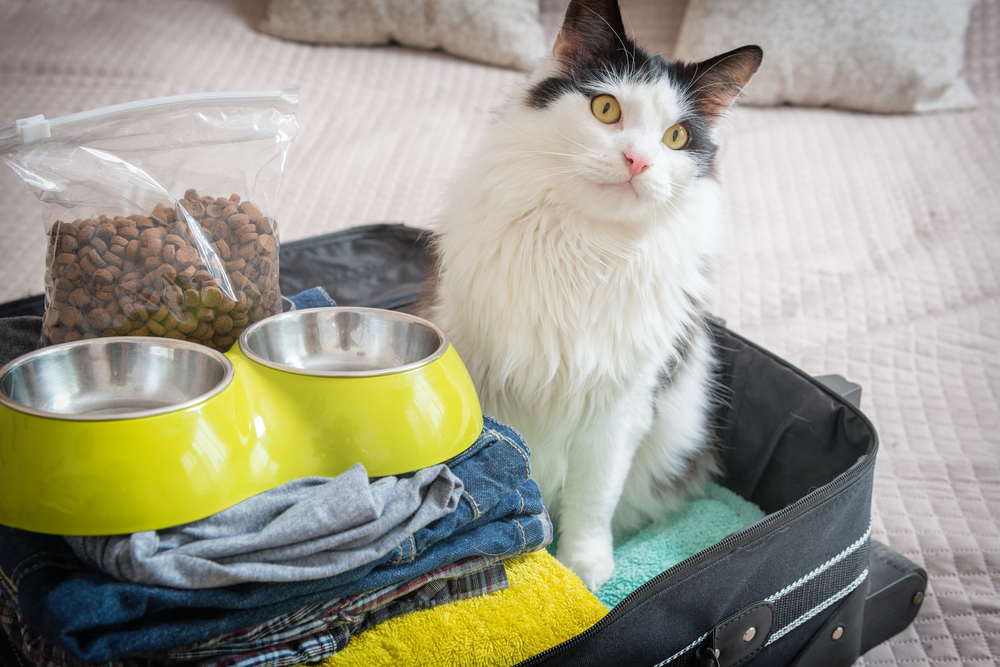
- 10. Consider Pheromones
Commercial synthetic feline pheromone products may help some cats stay calm while underway by reducing stress and creating a sense of safety and well-being. They’re available in sprays and wipes, so your cat can enjoy the benefits of calming pheromones while you’re on the road.
- 11. Check Your Cat’s Microchip Registration
Ensure that the registry where your cat’s microchip is registered has the right contact information. Losing your cat when you’re out of town is a nightmare, but an up-to-date microchip can significantly improve the chances of their return.
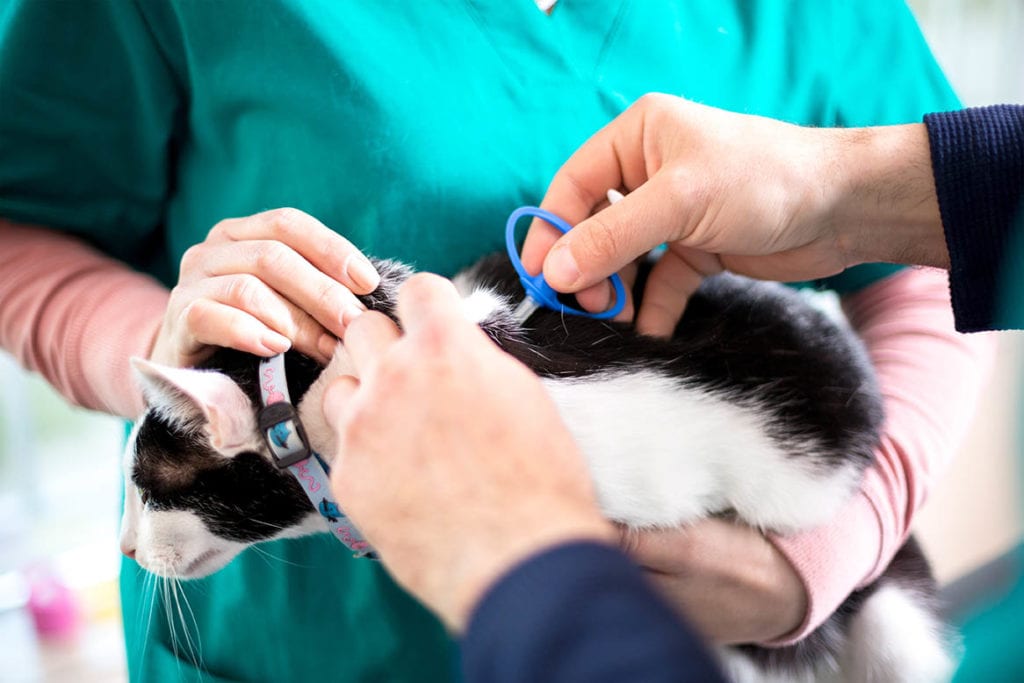
- 12. Collect Your Cat’s Medical Information
It’s vital to collect your cat’s medical information before you plan to leave and make sure you have a way to access it while you’re on the road in case they require veterinary care while you’re away from home.
Ensure you have all the documentation and certificates your cat needs to travel, including their vaccination status. Remember that the requirements vary based on where you’re headed and how you plan to travel.
- 13. Double Check Your Reservations
If you plan on staying in a hotel at your destination, contact the property ahead of time to ensure pets are permitted and get information about the rules and requirements that may apply. Don’t forget to inquire about the availability of litter boxes and food and water bowls.

- 14. Invest in Physical ID Tags
It’s best to attach an ID tag with your name and contact information to your cat’s collar. It will make it easy for people to reach out to you if your cat gets loose and makes a run for it.
Microchips are helpful , but lost cats need to be taken to shelters or veterinarians with scanners for their chips to be read. ID tags make the reunification process far more efficient; if your cat runs off, anyone who finds them can simply give you a call.

Traveling with cats can be stress-free with a bit of planning and preparation. Make sure to get started before you hit the road with your cat , particularly if you’re thinking about flying or staying in a hotel. Also, don’t forget to invest in an appropriate carrier and give your cat lots of time to get used to it.
- Hiking With a Cat: Is It Possible?
- Traveling With Kittens: Essential Tips
- https://vcahospitals.com/know-your-pet/flying-with-your-cat
- https://vcahospitals.com/know-your-pet/road-trips-and-car-travel-with-your-cat
- https://www.petmd.com/cat/care/8-tips-traveling-cat
- https://www.avma.org/resources-tools/pet-owners/petcare/traveling-your-pet-faq
- https://www.aa.com/i18n/travel-info/special-assistance/pets.jsp#:~:text=As%20recommended%20by%20the%20American,cardiovascular%20problems%20at%20high%20altitudes.
Featured Image Credit: Angels Relax CZ, Shutterstock
About the Author
Lorre Luther
Lorre Luther is a writer who is firmly convinced that cats are smarter than humans. She left her law career in the United States and moved to the Netherlands to follow her dream of becoming a writer. Lorre currently lives in Rotterdam, she enjoys traveling and greatly appreciates the beauty of nature. Lorre has a spot for animals and admires the intelligence of cats.

Zumalka Pet Supplement Review 2024: A Detailed Look

10 Pet-Friendly Hotels in St. George, Utah (2024 Update)

Does Health Monitoring Cat Litter Work? Vet Reviewed Facts & FAQ
Get catster in your inbox.

Here Comes the Sun: Is It Alright? Dangerous Things Cats Like

Cat Dogs: Cats for People Who Think They Don’t Like Cats

Strange Places That Cats Hide: Olga’s Preferred Spots
© pangolia pte. ltd. all rights reserved..


How To Travel With Two Cats in the Car

If you have two (or more) cats, there may be times that you’ll all need to be in the car at the same time. Of course, traveling in a car with multiple cats poses its own set of challenges.
You can easily travel with two cats in the car by preparing your cats for the drive and choosing the best carrier(s). Make sure each of your cats have a comfortable, safe place to ride in the car with adequate personal space from one another.
I’ve driven across the United States with multiple cats four separate times, and I regularly take all three of my cats to the vet together.
In this article, I’ll share the best tips I’ve found for traveling with two or more cats in the car.
Table of Contents:
Traveling with two (or more) cats in the car, how to travel long-distance with two cats, can you have two cats in one carrier when traveling.
- The Best Cat Carriers for Two Cats
Whether you’re getting ready to take your cats to the vet or preparing for a big move , you may be curious about the best ways to transport two cats.
In my experience, traveling with two cats in the car isn’t too much more difficult than traveling with one cat. You may have to pick up an additional carrier or a bigger carrier ( more on this later ) and plan for additional space in the car, but otherwise, the steps to help prepare your cats (and the drive itself) will be the same.
If your cats haven’t traveled much in the past, start helping them each get ready for the drive as early as possible. Take them each to the car (together or separately) days before your trip and let them get used to the space, smells, and sounds.
Even if you’re just traveling a short distance, it’s a good idea to introduce the cats to the environment at least once (but preferably a few times) before the drive.
I also recommend using a pheromone spray like Feliway (you can buy it on Amazon or Chewy ) and spritzing the car before you travel. It’s great for helping to keep your cats calm in stressful situations, like being in the car. Anytime I travel with my three cats, I use Feliway in their carriers and in the car before we go.
Finally, consider bringing a few familiar items for each of your cats . Two of my cats have favorite blankets while the other has a favorite pillow/pillowcase. You can place these items in your cats’ carriers or cover the carrier with them to surround your cats with their favorite familiar smells. Plus, covering part of your cats’ carriers may help reduce travel anxiety, especially if your cats aren’t the best of friends.
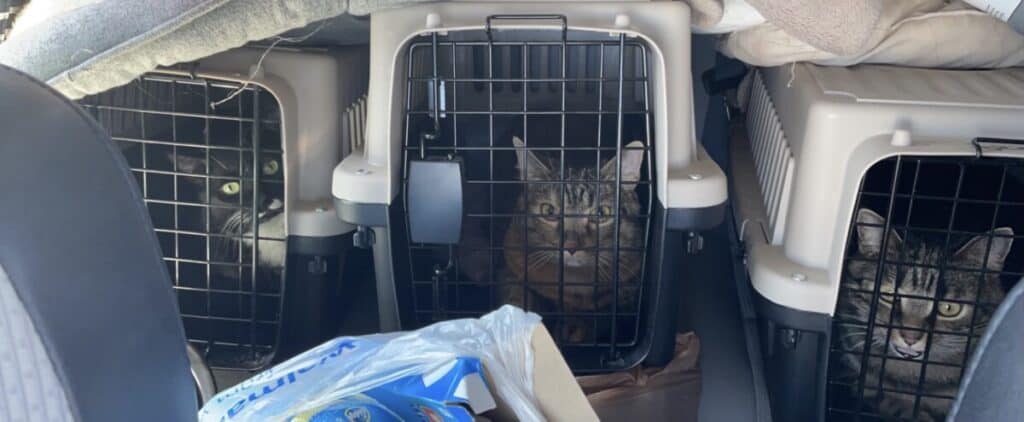
If you’re getting ready to travel with two (or more) cats in the car, start preparing as early as possible. The best way to reduce your cats’ travel anxiety on the road is by helping them feel prepared. Of course, it’s also important to be prepared yourself.
Here are my top six tips for traveling long-distance with two cats in the car:
- Get your cat carrier(s) early. The earlier you get your cat carrier(s), the faster you can let your cats start exploring it. Whether you opt for one or two cat carriers , let your cats explore the new space in your home first. You can even work toward feeding your cats in their carrier(s) to help them associate it with safety long before the day of the drive. This will help reduce travel anxiety on the road.
- Pack your cats’ travel necessities. In addition to your cats and their carrier(s), pack anything else they’ll need on the road. This could include a travel litter box , travel water and food bowls , your cats’ favorite blankets or toys, and familiar cat food and litter. Additionally, consider packing a car cleaner for any accidents (like one of your cats getting sick) on the road.
- Load both cats safely in the car. Make sure your cats have enough personal space in the car while also being safely loaded in. I like having my cats in the backseat if possible so I can easily check on them with my rearview mirror on the road. Additionally, neither of your cats should be exposed to direct sunlight for the entire duration of your trip. Alternatively, they shouldn’t be placed directly in front of the A/C either. This will quickly dry out your cat’s nose.
- Use pheromone spray. I highly recommend using a pheromone spray like Feliway ( Amazon or Chewy ) in the car with your cats. If they don’t get along, this can be a great way to help keep them calm. Even if they do, Feliway is a great way to reduce travel anxiety in the car (as well as in any new space, like a hotel room or new place).
- Plan your trip ahead. Speaking of hotel rooms, take the time to plan ahead and find pet-friendly hotel rooms along the way if you plan to stay overnight. If you’ll be in the car over 8-12 hours, I recommend giving your cats (and yourself) a night’s break if possible.
- Take breaks every four hours. In addition to planning out pet-friendly hotel rooms, plan your regular stops as well. Your cats will need breaks from their carriers on a long-distance road trip as well as opportunities to drink water and use the litter box. For more on how and when to plan your breaks, check out my article on how long you can travel with a cat before needing a break.
For more tips on how to plan your long-distance trip with two or more cats, be sure to also check out my guides on why your cats may be panting in the car and how to travel with a cat litter box in the car
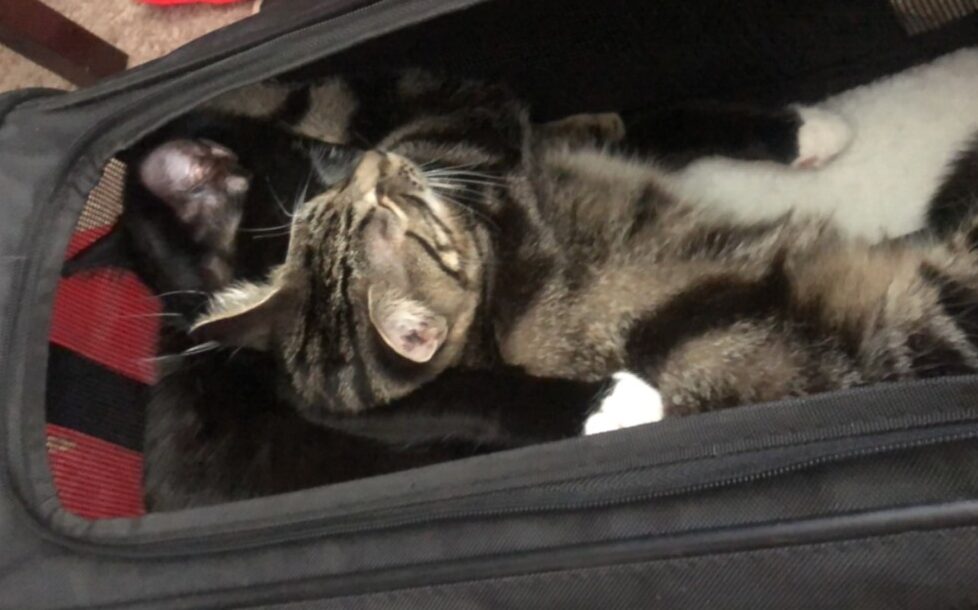
As you’re preparing to take both of your cats in the car, you may be wondering whether or not you should buy two carriers. Can you have two cats in one carrier when traveling in the car?
As a general rule, you can have two cats in one carrier while traveling as long as both cats have enough room to stand up, turn around and sit down. Additionally, you’ll only want to keep your cats in the same carrier if they get along.
If you’re traveling with two kittens, they’ll likely have plenty of space in the same carrier. However, if you have two chunky cats, they’ll likely appreciate their own space in the car.
Of course, if your cats don’t get along at home, you should get them each their own carriers. If your cats regularly hiss at each other, bat at each other, or are generally never near each other in the house, putting them in one carrier could create more travel anxiety for both your cats and yourself.
Best Cat Carriers for Two Cats
Purchasing your cat carrier(s) as early as possible is a great way to help reduce your cats’ travel anxiety. The sooner your cats can start exploring their carrier(s) and the car, the less stressed they’ll be on the day of travel.
Here are my top three picks for the best cat carriers for two cats based on size, safety, comfort, and customer satisfaction:
Best Cat Carrier for Two Cats
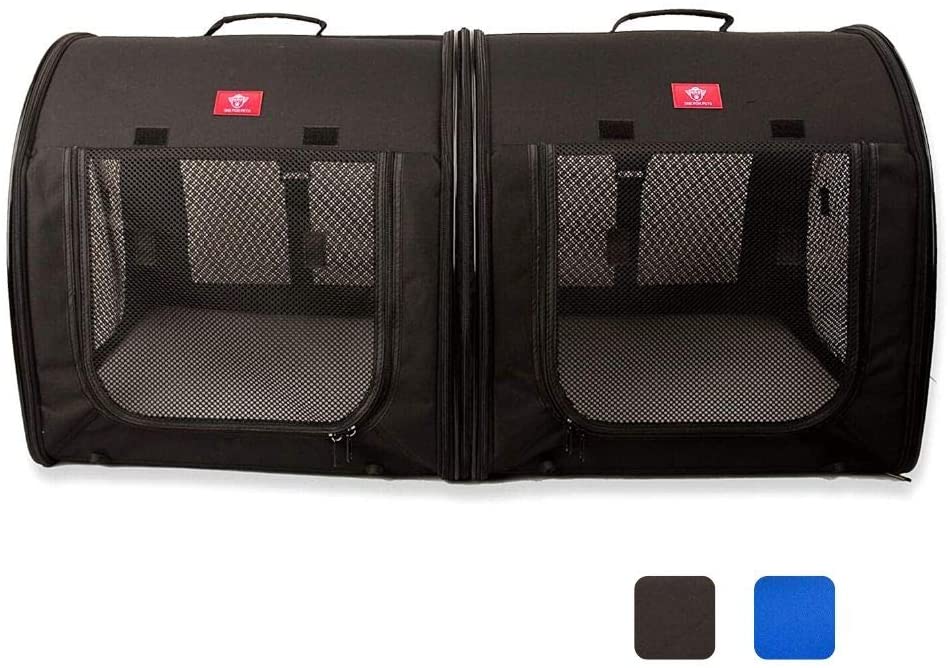
One for Pets Portable 2-in-1 Double Pet Kennel
- Read my Full Review
- Buy it at Amazon
Best Expandable Cat Carrier for Two Cats
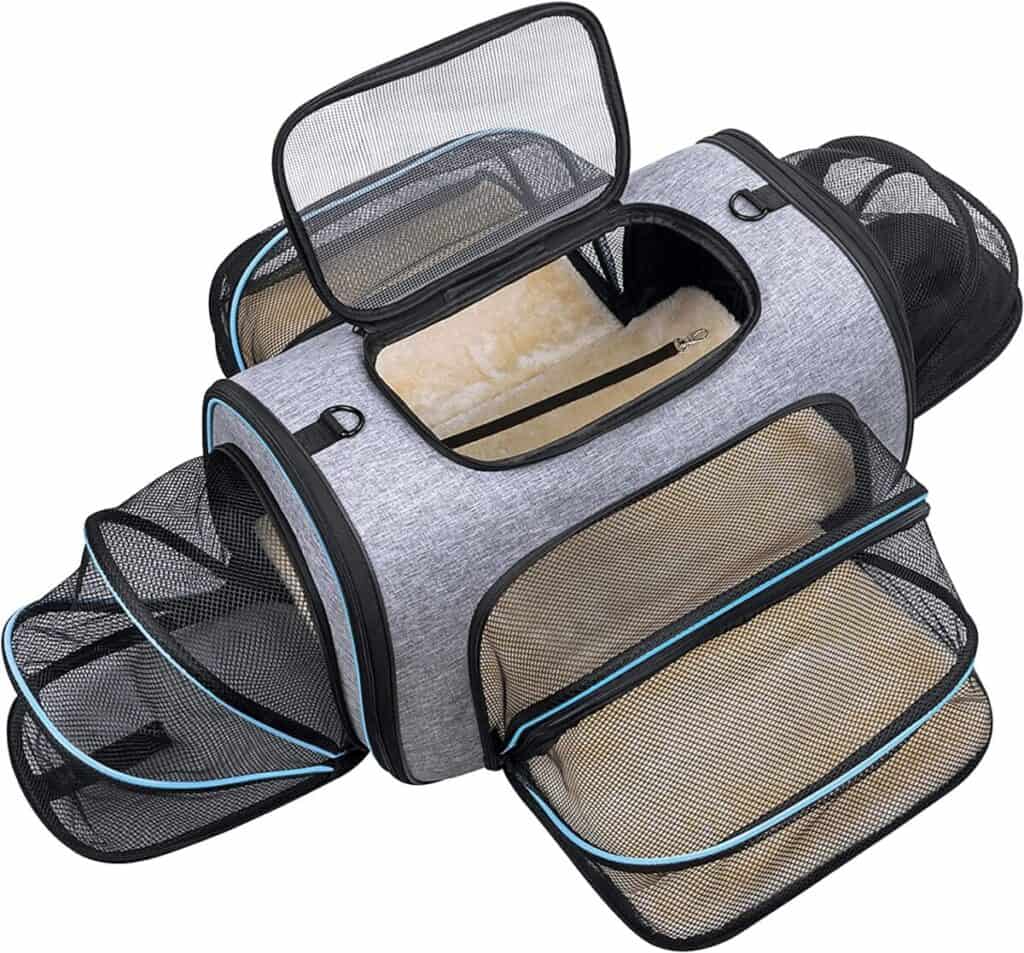
Siivton Pet Carrier
Best Budget Cat Carrier for Two Cats
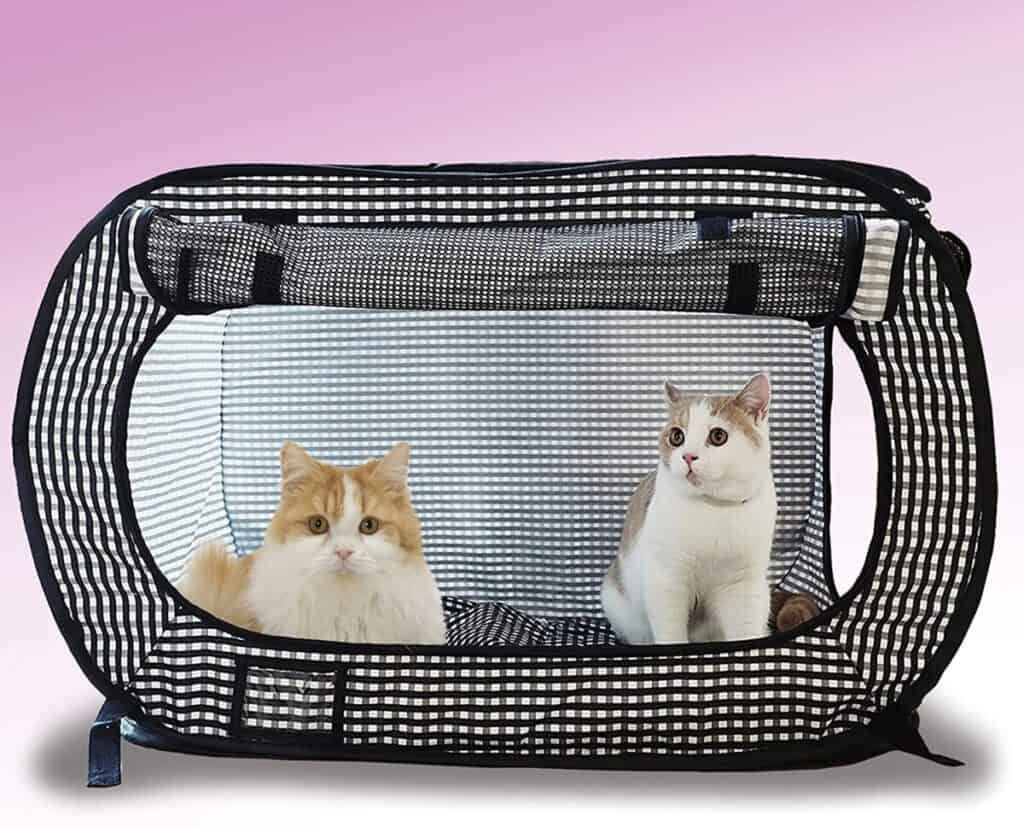
Necoichi Portable Stress-Free Carrier
For more options, check out my full list of the best cat carriers for two cats here .
In addition to your cat carrier(s), there are a few other travel essentials that you may want to purchase before the trip, especially if you’ll be traveling long-distance with two cats.
Here are my recommendations:
- Travel food and water bowls ( see my top picks here )
- Portable litter box ( see my top picks here )
- A harness ( this one is very highly-rated )
- Pheromone spray (I definitely recommend Feliway )
Final Thoughts
As you prepare for traveling with two cats in the car, keep in mind that preparation is key. Get a great cat carrier for two cats as soon as possible. Then, begin introducing your cats to their carrier(s) and the car.
If your cats get along, you can purchase a single cat carrier that’s big enough for both of them. If your cats prefer their space away from one another, try to respect that in the car.
To combat your cats’ travel anxiety in the car, try using a pheromone spray like Feliway ( Amazon or Chewy ). Of course, you likely won’t be able to completely prevent travel anxiety. If one of your cats starts panting in the car, check out these tips to help calm them down .
For more travel tips and advice, be sure to also check out my full guide on how to travel with a cat in the car .
Dallas is a proud cat parent of three (Kitten, Meera, and Jojen) and they love to travel. In addition to running Travel Tabby, Dallas also writes money saving tips on Clark.com.
Recent Posts
Taking Your Cat on an Amtrak Train: 5 Things To Know
If you’re getting ready to take a trip via Amtrak, you may be wondering whether or not your cat can ride the train with you. Here’s what Amtrak’s pet policy says: You can bring your cat on...
The Best Heated Outdoor Cat House for Winter 2024: 9 Top Picks
Whether you have an indoor/outdoor cat yourself or you’ve noticed several strays around the neighborhood, you may be looking for a heated cat house to put outside this winter. I’ve looked at...

Save 35% on Cat Food, Litter, Toys, & More at Chewy.com Save Now

A Complete Guide to Traveling with Your Cat
Contents of Article
Why Don’t Cats Like to Travel?
What should you bring, tips for traveling by plane with your cat, traveling by car with your cat.
We all need a break from reality once in a while and traveling is the perfect way to let loose and relax. When you hit the road and venture away from home, what happens to your cat? Do you leave him with a neighbor or take him to a kennel? If you hate the idea of leaving your cat behind, you’ll be glad to learn that you don’t have to! With the right preparations, traveling with your cat can be simple and enjoyable for the both of you.
Though you may love to travel, many cats do not. Many cats get nervous during car rides or they get car sick – some become stressed or overwhelmed to the point that they panic. It is entirely possible to have a safe trip with your cat, but you need to make some preparations first. Not only do you need to plan ahead in packing your bags and finding a pet-friendly hotel, but you should also condition your cat to reduce his anxiety about travel.
If you’re thinking about bringing your cat with you on your next trip, this in-depth guide is exactly what you need! We will cover some of the challenges of traveling with a cat and provide helpful tips and tricks for making the experience as hassle-free as possible. So, if you’re ready to learn the secrets to successful travel with your cat, keep reading!
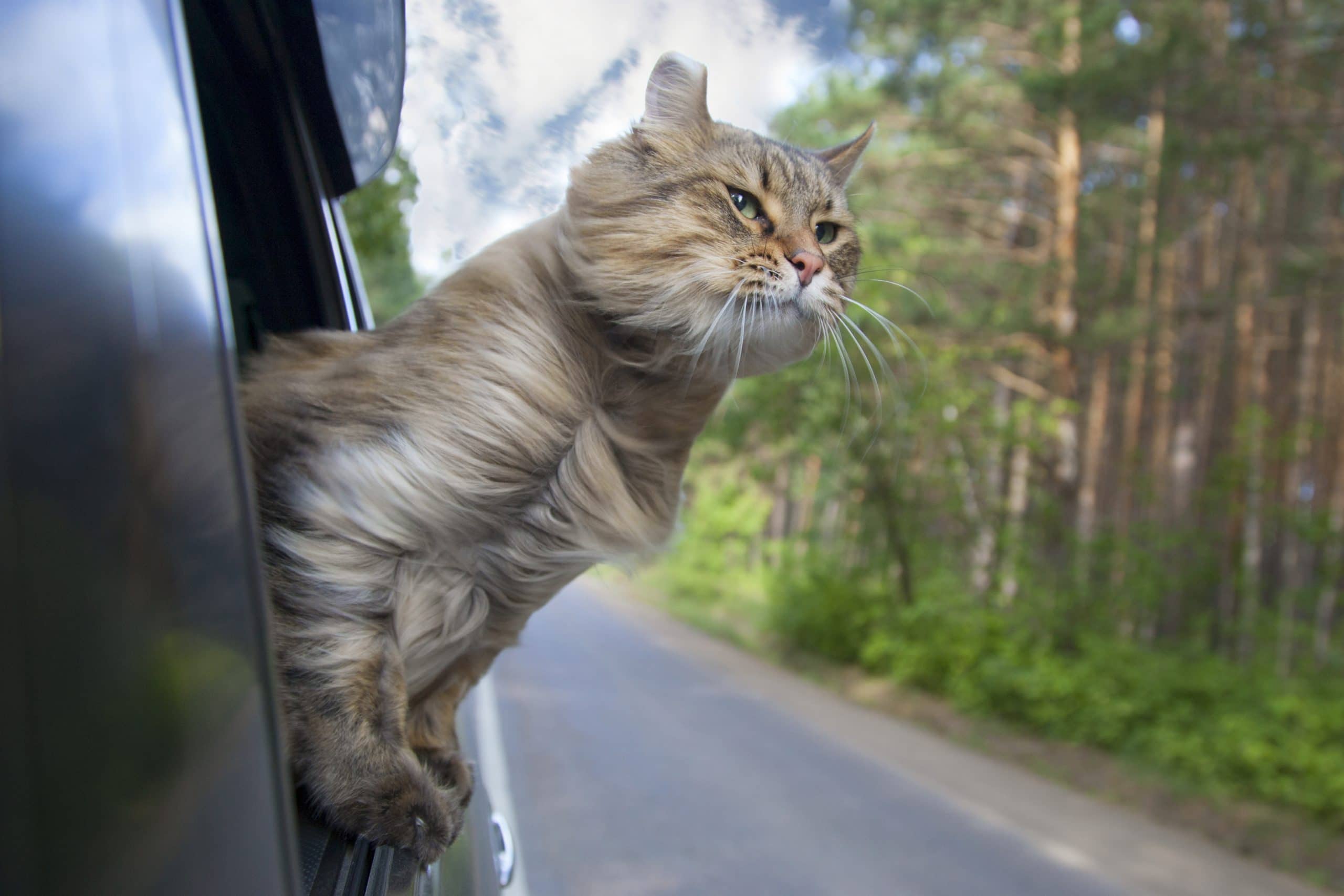
Cats are very much creatures of habit – they tend not to like anything that disrupts their routine. For most cats, riding in the car is an out-of-the-ordinary thing, so it can cause anxiety or stress. Cats also tend not to like being away from what they perceive as their territory. If you only take your cat in the car on the way to the vet, he could form a negative association with car rides as well. Though you may not like to hear it, you are probably reinforcing your cat’s fears by soothing him as he whines or cries from the back seat.
If you plan to travel with your cat, especially for any extended period of time, you may want to take some time to get him used to the car before you force him to spend an entire day in it, or longer. The first thing you need to do is invest in a high-quality travel carrier . Allowing your cat to roam freely in the car is a horrible idea. Not only could he be injured in the event of an accident, but he could panic and cause a dangerous distraction – he could also get stuck under a seat. The carrier will keep your cat safe and contained throughout the duration of the trip.
Once you have your travel carrier, line it with a soft blanket or a crate mat to keep your cat comfortable during the trip – it may help your cat to feel more comfortable if you use something he’s slept on before. Next, take some time to acclimate your cat to the carrier and to the car – you should do this over the course of at least a week before your travel date. Place the carrier inside the car then get in the car with your cat and close the door. Let your cat explore a little bit and sniff around.
To help your cat form a positive association with the car and with the crate, toss some treats into it for him to find or start feeding him his meals in the carrier. Once your cat becomes more comfortable with the car itself and with the carrier you can start taking him on short trips around the block, gradually increasing the length. It is normal for your cat to whine a little bit but don’t give in and let him out of the carrier – you also shouldn’t try to soothe him or you might end up reinforcing the idea that a car ride is something he should be afraid of. It may take some time, but eventually you can get your cat used to riding in the car and it will no longer be a stressful experience.
You’ve already learned about the importance of a high-quality travel carrier, but there are a number of other things you should bring with you when you and your cat travel together. Here is a quick list of things to bring along:
- Copies of your cat’s medical records
- Collar and ID tags with contact information
- Current photo of your cat
- Any medications your cat needs
- Food and water bowls
- Your cat’s food and treats
- A comfy blanket or bed (for outside the carrier)
- Your cat’s favorite toys
- Supplies for cleanup (paper towels, carpet spray, etc.)
- Travel litter box with litter and scoop
Some of the things on this list may not be necessary for every trip – it is up to you to use your best judgment about what you are going to bring. Make sure to pack the essentials first, things like food, then add extra toys and other items if you still have room.
In addition to packing the items on the list above, there are a few more things you should have with you when you travel that take a bit of preparation. You never know when an accident might happen and you’ll have to take your cat to the emergency vet. When you’re away from home, however, you might not be able to find one quickly. Before you travel, take the time to look up some veterinarians and emergency clinics near your destination and along the way, just in case. You may not need it, but it is always better to be safe than sorry!
When traveling with your cat by plane, there are some specific preparations you need to make and protocols you need to follow. Each airline has its own rules regarding pet travel, so shop around a little bit and be sure to read the fine print before you book your ticket. When it comes to plane travel, there are two options for your cat – the cargo hold or in the cabin. Some airlines allow pets under 20 pounds to travel in the cabin as long as their carrier can fit under the seat in front of you. If this isn’t an option, your cat might have to travel in the cargo hold.
As you shop around for flights, pay attention to the minute details. Keep in mind that some airlines only allow a certain number of pets to travel in the cabin for each flight – if you don’t book soon enough to reserve your spot, you might have to switch flights or put your cat in the cargo hold. Keep in mind as well that there may be an extra fee for your cat and that you have to have an airline-approved carrier . You will probably also need to show the airline your cat’s vaccination records – keep one copy on your person and another in the carrier itself. You should also make sure the carrier is clearly labeled with your name and contact information.
If you’re traveling by plane with your cat, you should plan to arrive at your gate at least an hour early. Some airlines will want to inspect the carrier and review your cat’s vaccination records, so leave plenty of time for this. During the 24 to 48 hours before your flight, you should start to withhold food and water. If you are traveling in the morning, don’t feed your cat the night before. Most cats can hold their bladders well, so you can still offer water up until a few hours before the flight. Just in case, however, you should place a pee pad on the bottom of your cat’s carrier and cover it with a blanket – the liquid will soak through the blanket into the pee pad, preventing your cat from sitting in urine for hours.
When you arrive at your destination, it’s a good idea to wait until the rest of the plane has disembarked so you don’t stress your cat by battling through a crowd. Do not open the carrier or take your cat out until you actually arrive at your final destination. Even then, however, it’s not a bad idea to let your cat rest for an hour or so to calm down. If your cat seems extremely agitated, he may need some extra time. You should also be very careful when taking him out of the carrier because he could spook – consider putting him in a harness, just in case.
You already understand the importance of a good travel carrier and you’ve learned how to acclimate your cat to the carrier and to the car. Now it is time to learn the specifics of actually traveling with your cat by car. Set up your cat’s carrier in the backseat so, if there is an accident, he is protected from the airbags. If you have a carrier that is specifically designed for travel it might include an option to secure it in place with a seatbelt – use this option if it is available. If it isn’t, you can try placing some of your luggage on either side of the carrier to keep it from tipping, just be sure that the luggage won’t fall over onto the carrier.
As you hit the road, be prepared to take frequent breaks. You don’t necessarily need to take your cat out of the carrier during these breaks, but it will give your cat a chance to rest a little bit. If you are able to do so safely, you can let your cat out of the carrier in the car or outside the car if he has a harness or leash . You can give your cat the option to use the litter box during breaks, but he is unlikely to use it. If you have to leave your cat in the car, always leave a window cracked even if it doesn’t feel hot out. If you are traveling in the spring or summer, try to park in the shade or have one person stay in the car with the air conditioning running if you need to use the restroom or get some food.
During your travel, you can give your cat some water during breaks, but wait to feed him until you’ve arrived. Keep in mind that some cats are finicky about the taste of water, so it might be a good idea to bring a supply from home. If you are traveling during the summer, bring some ice packs and a cooler so you can give your cat some cold water. The ice packs will also come in handy if the air conditioning in your car stops working – you can place them under the blanket in your cat’s carrier to keep him cool. Conversely, if you are traveling in winter you should bring extra blankets to keep your cat warm.
How to Find a Cat-Friendly Place to Stay
Though it may be a little stressful for the both of you, the actual travel portion of your trip may be the easiest part – what may be difficult is finding a cat-friendly place to stay. More and more hotels are becoming pet-friendly, though many hotels allow dogs but not cats. If you’re planning to stay in a hotel, you should do some research to find one near your final destination that accepts cats. This may require you to do a little research and you’ll have to look into the individual pet policies for each hotel.
To help you find a cat-friendly hotel, try websites like BringFido.com and Petfriendlytravel.com , or you can search by pet-friendly hotels on sites like Expedia and TripAdvisor. Here are some of the top pet-friendly hotel chains:
- Four Seasons Hotel/Resorts
- Kimpton Hotels
- Best Western
- Lowes Hotel/Resorts
- Fairmont Hotel/Resorts
- Hotel Indigo
- Red Roof Inn
- Ritz Carlton
As you do your research, pay attention to the rules and regulations that accompany each pet-friendly hotel’s pet policy. You should also check to see what kind of pet-friendly amenities the hotel offers such as hardwood floors for easy cleaning or a welcome bag with treats for your cat. It is also important to keep in mind that even though hotels provide cleaning services, it is still your responsibility to clean up after your cat if he has an accident or makes a mess. You should also be prepared to pay for damages if your cat claws something. Keeping your cat in the bathroom is a good way to prevent damage.
Once you have found a cat-friendly hotel, you can start taking steps to help your cat settle in. Hopefully you have brought with you a few familiar items from home to help your cat deal with being in an unfamiliar situation. The best idea is to set up shop in the bathroom for your cat – most hotel doors open right into the room and you don’t want to risk your cat escaping. Place your cat’s carrier in the bathroom and leave the door open so he can retreat to the carrier if he likes. Set up your cat’s food and water bowls then place the litter box in the bathtub to minimize mess and to create some separation from your cat’s eating area.
Staying at a hotel can be stressful for your cat, so there are a few things you should keep in mind. If you choose not to keep your cat in the bathroom, you’ll need to be very careful about knowing where your cat is at all times so he doesn’t bolt out the door. Most cats will hide when they are in an unfamiliar location, so be prepared to spend some time searching for your cat if you decide to move him to the bathroom overnight. Keeping some tasty treats and a fresh can of wet food may help to entice your cat out of hiding. When you are just resting in the hotel room, however, you should give your cat some time and space to rest as well – don’t force him to come out if he doesn’t want to.
Other Tips for Traveling with Your Cat
Before you and your cat head out on the open road, you should talk to your veterinarian. Not only do you want to make sure that your cat is healthy enough for travel, but your vet might be able to give you advice for how to keep your cat calm during the trip. If your cat gets car sick, or if travel is extremely stressful for him, your vet might suggest sedation. There are different medication options out there, so talk to your vet about the one that is right for your pet. When it comes time to travel, give your cat the medication ahead of time so he is calm (or asleep) when it comes time to put him in the car. You may also want to do a pre-travel trial to make sure your cat responds to the medication – some don’t.
During travel, try to limit your cat’s interaction with strangers unless he is particularly good with people. Travel can be stressful for cats and adding the anxiety of being around unfamiliar people could make things worse. If you have to leave your cat alone in the hotel room, make sure he is safe and secure – you might also leave him with an item of your clothing or something familiar from home. Though it may be challenging to do so, you should also try to stick to your normal routine as much as possible while you’re away from home. Feed your cat at the usual times and don’t make any changes to his diet. If your cat seems to not be adjusting well, you might want to take him to a local vet for a checkup, just in case.
Safe Alternatives for Leaving Your Cat at Home
In the event that traveling with your cat is not a practical option, you should consider the alternatives before making your choice. The best option is probably to enlist a friend or hire a pet sitter to come to the house and feed your cat. Though your cat may become a little nervous about your absence, he will be much happier at home than in a boarding facility. The great thing about cats is that they don’t need to be walked everyday like dogs, so having someone check in once a day for feeding is perfectly fine. If you really want to make sure your cat is taken care of, you could hire someone to come and stay at the house throughout the duration of your absence.
If you don’t like the idea of leaving your cat alone at home, you can think about having a friend or family member watch him in their own home. It could be stressful for your cat to be kept in an unfamiliar place, but a few days won’t hurt. Think of a kennel or boarding facility as a last resort. These facilities are fine for dogs, but they can be extremely stressful for cats. Not only is your cat likely to be nervous in an unfamiliar place, but he may become stressed by dogs barking and by being kept in a small, confined area. Some boarding facilities are better than others, however, so if you must use this option, look for one that is particularly cat-friendly.
No cat owner likes to leave his cat at home, though sometimes it is the best option. If you have the chance to travel with your cat, however, by all means take advantage! Enjoying a trip together could be a great bonding experience for you and your cat – just be sure to follow the tips and tricks provided in this article to ensure a safe and enjoyable experience for everyone involved.

Kate Barrington is a freelance writer specializing in the subject of pet health and wellness. An avid dog lover and adoring owner of three cats, Kate has a great deal of experience writing about all kinds of pets and all aspects of pet care. Her work has been featured on a number of pet websites and she is a regular columnist for Tropical Fish Hobbyist Magazine.
Similar Posts

The 16 Best Cat Products for 2023
Contents of ArticleThe Coolest Products that Every Cat Owner NeedsLuxury Cat Beds and HidesHigh-Tech Gadgets for Cat OwnersAwesome Cat Toys and Scratching PostsFeeding and Litter Boxes The Coolest Products that Every Cat Owner Needs Being a cat owner can be challenging because cats are known for being stubborn and for having a mind of their…

20 Ways Cats Make You Happier and Healthier
Contents of Article1. They may help you deal with anxiety.2. They help you recover more quickly from a loss.3. They might prevent you from having a stroke.4. They can help you get a date.5. They can boost your immunity.6. They provide judgment-free companionship.7. They may reduce your risk for heart disease.8. They can help you…

Best Cat Trees : Condos for Kitties Who Like To Climb & Scratch
Contents of ArticleWhy get a cat tree?Which types of cats need a cat tree?1. Cats who climb where they shouldn’t2. Cats who scratch where they shouldn’t3. Cats who don’t get along4. Shy or sensitive cats5. Stressed-out catsChoosing the Best Cat TreeStability and constructionFeaturesThe Top 5 Best Cat TreesArmarkat 77-inch Cat TreeVesper Furniture V-High BaseGoPetClub 106-inch…
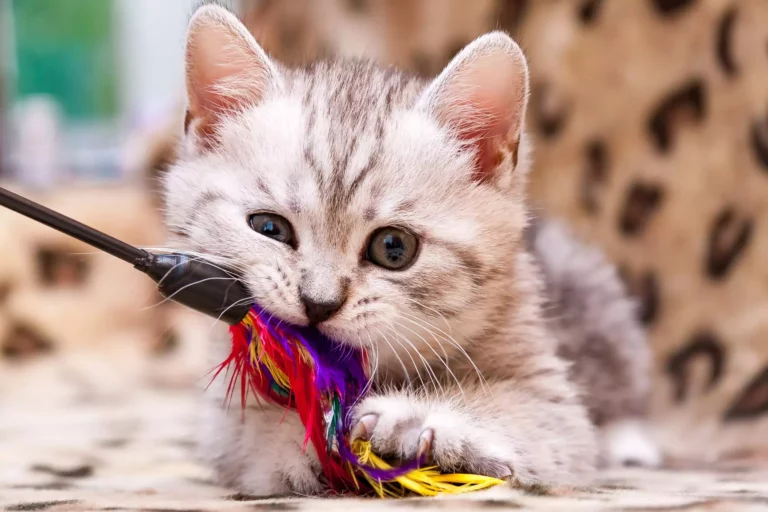
Best Cat Toys : The Top Interactive Toys for 2023 (w/ Videos)
Contents of ArticlePlaytime is essential.Best Cat Toys for 2023Fishing Poles/TeasersBattablesInteractive Puzzles & Food DispensersLaser PointersScratchersOther Interactive Cat ToysOther ToysThere are tons of different toys available.Fishing Poles/ TeasersBattablesInteractive Toys / PuzzlesFood dispensing toysLaser pointersScratcher toysNow let’s go play! Playtime is essential. Everyone loves watching cats play, right? Watching your cat pounce, leap, twitch, and do flips…

Top 5 Best Cat Collars for Safety and Durability
Contents of ArticleIt’s not just a necklace: collars give your cat a new way to communicate.What do cat collars do?Make medical issues obvious.If your cat gets lost, a collar gives them a way to say: “Please help me get back home.”Do bells keep your cat from catching birds?Give your cat personal style.Choose a great collar…

Top 5 Best Scratchers and Scratching Posts for Your Cat
Contents of ArticleWhy do cats scratch?What makes a great cat scratcher?MaterialsCarpetSisal RopeSisal FabricCardboardConstruction and StabilityShapeTop 5 Best Cat ScratchersSmartCat The Ultimate Scratching Post Review – $30.09PetFusion Ultimate Cat Scratcher Lounge Review – $49.95KONG Naturals Incline Cat Scratcher Review – $7.49MidWest Feline Nuvo Grand Forte 41-inch Cat Scratching Post Review – $38.60SmartCat Bootsie’s Combination Scratcher Review…
Leave a Reply Cancel reply
Your email address will not be published. Required fields are marked *
Save my name, email, and website in this browser for the next time I comment.
- PRO Courses Guides New Tech Help Pro Expert Videos About wikiHow Pro Upgrade Sign In
- EDIT Edit this Article
- EXPLORE Tech Help Pro About Us Random Article Quizzes Request a New Article Community Dashboard This Or That Game Popular Categories Arts and Entertainment Artwork Books Movies Computers and Electronics Computers Phone Skills Technology Hacks Health Men's Health Mental Health Women's Health Relationships Dating Love Relationship Issues Hobbies and Crafts Crafts Drawing Games Education & Communication Communication Skills Personal Development Studying Personal Care and Style Fashion Hair Care Personal Hygiene Youth Personal Care School Stuff Dating All Categories Arts and Entertainment Finance and Business Home and Garden Relationship Quizzes Cars & Other Vehicles Food and Entertaining Personal Care and Style Sports and Fitness Computers and Electronics Health Pets and Animals Travel Education & Communication Hobbies and Crafts Philosophy and Religion Work World Family Life Holidays and Traditions Relationships Youth
- Browse Articles
- Learn Something New
- Quizzes Hot
- This Or That Game New
- Train Your Brain
- Explore More
- Support wikiHow
- About wikiHow
- Log in / Sign up
- Pets and Animals
- Travel with Cats
How to Drive Long Distance With a Cat
Last Updated: May 24, 2022 Approved
This article was co-authored by Pippa Elliott, MRCVS . Dr. Elliott, BVMS, MRCVS is a veterinarian with over 30 years of experience in veterinary surgery and companion animal practice. She graduated from the University of Glasgow in 1987 with a degree in veterinary medicine and surgery. She has worked at the same animal clinic in her hometown for over 20 years. wikiHow marks an article as reader-approved once it receives enough positive feedback. In this case, 100% of readers who voted found the article helpful, earning it our reader-approved status. This article has been viewed 89,624 times.
Cats like routine, and so traveling with one can cause stress. If you have to move or want to take a long car journey with your cat, you may be concerned about its comfort and safety. By gathering the right supplies and preparing your cat beforehand, you can make the trip as pleasant as possible.
Preparing for Travel with Your Cat

- You can also discuss with your vet whether or not feline sedatives are a good idea while traveling with your cat. [1] X Research source These can calm some felines, but your cat may react badly to the medicines, or it may wear off during the trip. Never give your cat a sedative designed for humans.

- Well-ventilated
- Large enough for your cat to sit, stand, turn around, and lay down in
- Made of a sturdy material, whether soft (cloth or mesh) or hard (plastic or wire)

- Favorite toys, pillows, blankets, etc.
- Food and water
- A litterbox and litter
- A waste scoop and/or plastic bags
- Brushes, combs, and other grooming supplies
- Any medications your cat takes
- A pet first-aid kit (ask your veterinarian about getting one)
- Travel papers (showing vaccinations, health records, etc.), if needed in your destination

- If you wish, you can also have an identifying microchip placed in your cat. [6] X Trustworthy Source American Society for the Prevention of Cruelty to Animals Leading organization dedicated to the prevention of animal cruelty Go to source

- If you and your veterinarian have decided to give your cat sedatives, make sure to give it a dose prior to your trip, according to instructions.
- For trips under 2 hours, you won’t need to feed your cat on the road. Otherwise, feed it every 2 to 3 hours. Your cat may not want to eat or drink while traveling.
- Don’t feed your cat while moving in your vehicle, as there are risks that it could choke, become sick, or get loose in the vehicle. If you need to feed your cat en route, stop first.
Traveling with Your Cat

- Letting your cat loose in the car while traveling is not safe. If your cat is not safely in its carrier, it may crawl to a dangerous place (such as under your feet), or it may become even more stressed.
- Only let your cat out of its carrier when you are safely at your destination or a stopping point.

- The safest place to keep your cat’s carrier is in the backseat.
- Don’t leave a car window window down while traveling with your cat. [7] X Trustworthy Source The Humane Society of the United States National organization devoted to the promotion of animal welfare Go to source It might try to escape, the noise might bother it, or the wind might make it cold.

- A product that mimics this feline facial pheromone is called Feliway. You can spray it in your car to make your cat feel more comfortable.

- Zylkene is available without prescription and comes in 75 mg capsules. The dose for a cat is a 75 mg capsule once a day, given with or after food. It can take a couple of days to take effect, but if there is no noticeable difference after 7 days, it is unlikely to help your cat.

- Buprenorphine, gabapentin and alprazolam are examples of medications that have recently begun to be used to reduce the anxiety associated with car travel or veterinary visits. If one of these medications is appropriate for your cat’s situation, your veterinarian will prescribe it. [11] X Research source
- Be sure to ask your veterinarian about the potential side effects in order to properly weigh the pros and cons.

Expert Q&A
You Might Also Like

- ↑ https://indoorpet.osu.edu/cats/felinelifestressors/traveling-your-cat
- ↑ http://www.humanesociety.org/animals/resources/tips/traveling_tips_pets_ships_planes_trains.html
- ↑ http://www.aspca.org/pet-care/car-travel-tips
- ↑ http://www.cathealth.com/inappropriate-behavior/cats-and-stress
- ↑ https://www.wikihow.com/Reduce-Stress-in-Cats
- ↑ http://www.vcahospitals.com/main/pet-health-information/article/animal-health/medication-to-reduce-the-stress-of-veterinary-visits-for-cats/10567
About This Article

To drive long distance with your cat, first get a sturdy carrier that's big enough for your cat to sit, stand, and turn around in, and leave it out in your home for a few days so your cat gets used to it. You can also take your cat on a few short trips in the carrier before your long drive. When it's time for your long-distance drive, put a collar on your cat with a tag containing your contact information in case it escapes. You should also pack toys, blankets, food, water, a litter box, and litter. For more tips from our Veterinary co-author, like how to keep your cat calm during your trip, read on! Did this summary help you? Yes No
- Send fan mail to authors
Reader Success Stories
Feb 3, 2017
Did this article help you?

Daniel Anderson
Jan 23, 2019

Featured Articles

Trending Articles

Watch Articles

- Terms of Use
- Privacy Policy
- Do Not Sell or Share My Info
- Not Selling Info
Get all the best how-tos!
Sign up for wikiHow's weekly email newsletter

Road Trips and Car Travel With Cats
Author: LeeAnna Buis, CFTBS, FFCP
Published: April 17, 2024
Our mission is to help save dogs' and cats’ lives through our educational content. To support our efforts, this page may contain affiliate links . We earn a commission for qualifying purchases – at no cost to you.
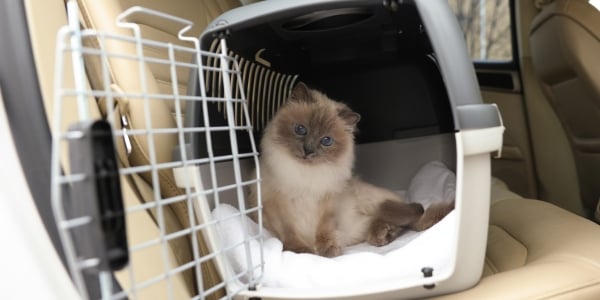
During the summer months and around the holidays, many of us head out on road trips and consider taking our feline family members along.
Summer is also a peak time for relocating across town or across country.
The problem is that most cats don’t feel safe in the car. They may cry or yowl, hide in their carrier, and even soil due to fear. That means an unpleasant trip for them and you.
It is possible to help your cat feel more secure in the car. Some may even learn to love it. We’re going to walk you through the steps to desensitize your cat to being in the car.
We’ll also recommend travel items to bring in the car and for a hotel stay so that you both have a safe and comfortable trip.
Skip to section:
- How to get your cat comfortable with car travel
- How to use a litter box when you travel – and will your cat use it?
- Where to stay when traveling with your cat and what to consider
- Special travel considerations for sick cats
- Be prepared for emergencies while traveling
Getting Your Cat Ready for a Road Trip
Step 1: get your kitty feeling comfortable in their carrier..
If they're going to ride in the car, like you, they’ll need to be safely “buckled up” to protect not just them but everyone in the car and on the road.
After all, unrestrained cats can be a distraction, interfering with your ability to steer or brake, and even become a dangerous projectile in the event of a crash or sudden stop.
What if your cat is wearing a harness and leash? If the car is moving, I still say keep them secure in a carrier. If you want to let them stretch their legs on the harness and leash while the car is stopped and windows are up, go for it. Just keep in mind that you’ve got to get them back in the carrier when you start moving again, and they may not love that.
It could be less stressful for everyone to stick with the carrier in the car and try the harness and leash INSIDE your hotel or destination. More on the dangers of letting your cat out of the car on their harness and leash later in the article.
So, your first step starts well before your trip. Spend some time training your cat to love their carrier – we have an article on that process – before the big travel day arrives.
Don't have a carrier for your cat yet? Check out our carrier recommendations, including carriers that are crash-test certified . If your cat is going to be spending a lot of long hours in the car, you may opt for a larger carrier than normal. We cover that, too. Just keep in mind you’ll want that carrier sooner rather than later, so you can use it during the pre-travel training.
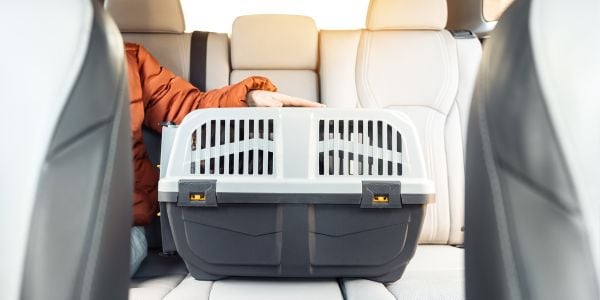
Step 2: Get your cat feeling comfortable in the car.
Now that your kitty feels better in their carrier, it’s time to help them feel comfortable in the car. Here are some steps to help you do that.
Pro Tip: Car acclimation is best done with two people … one to drive the car, the other to pet, praise, and treat kitty. It can be done with one person, too, but very carefully.
You’re going to do short sessions in the car – your cat dictates how long the sessions will be. The number of sessions depends on how quickly your cat gets comfortable. The main thing is that you don’t want to push your cat past their comfort zone. Your cat should always be calm.
You might be thinking that even if your cat is scared, leaving them in the car in spite of their fear will eventually show them they don’t have to be afraid. Nope! That’s not how cat brains work. Instead, think of it as starting at a really low intensity so your cat doesn’t have to be scared. As they’re ready, you slowly turn up the intensity.
If you turn it up too far and they get nervous, just end the session and lower the intensity for the next session.
Show them there’s no reason to be afraid because you’re not going to push them too far. And they’re getting good things through the entire process, so you’re actually turning a scary thing into a positive thing.
Take your cat out to the car in their carrier – covered on three sides with a towel or blanket for security.
With the car parked and not running and the doors and windows closed (weather permitting), sit in the back seat with your cat in their carrier. Partially open one of the carrier doors if you can do so without your cat trying to get out.
Then, make good things happen. Give treats (make sure it's a treat they love ), pets, praise, and show them this is a positive experience. Do this for just a few minutes (or longer if your cat is really enjoying it). Then, take them inside and end with treats and love. You’ll continue these sessions, gradually making them longer as your cat is comfortable, until your cat seems nice and calm, spending time in the car while in their carrier.
Next, you’ll turn up the intensity a bit by starting the car. Make sure the radio is off or very low (cats find classical music calming). And repeat the previous step.
Spend a few minutes in the back seat making good things happen for your cat while the car is running. If the engine really scares them, keep it short — just 1 minute with some treats. Again, you can gradually increase the length of time your cat is in the car, getting good things while the engine is on.
Caution: If your car is parked in your garage, either open your garage door or move your car out of the garage. Carbon monoxide is very dangerous for both of you!
Once your kitty is doing well with the car on, it’s time to turn the intensity up again. Time for a short drive.
Note: If they’re too nervous to eat treats, they’re probably not ready for this step. Back it up and spend more time on the previous steps.
It may just be pulling out of the driveway in the first couple of sessions. That’s just fine. You’ll work up to longer drives. And your cat will learn that being in the car doesn’t mean going to the vet. Never push these drives further than your cat is comfortable with. Also, be sure to drive calmly and go easy on the gas pedal and brakes.
Since each cat and each situation are different, it could take anywhere from a few sessions to several months for a cat to feel calm during car travel.
Car Travel Logistics With Cats
Will a cat use a litter box in a car.
Jumping right down to “business,” … depending on the duration of your travel adventures with kitty and where you’re winding up, you’re going to have to deal with litter box accommodations. This is the case both when you’re on the road and when you get to your hotel or destination.
Just because you give your cat access to a box doesn’t mean they’ll use it, especially if they’re nervous.
Cats don’t like to eliminate when they feel unsafe. They'll likely choose to do their business once you get to your destination. It’s nothing to worry about unless they go more than about 24 hours without peeing. At that point, call your vet and see what they suggest.
When I moved with my cats, and we had 8-hour days in the car, they held it all day and most of the night.
If they’re willing, you can help your cat take care of business on the road in a few different ways.
First, get them a good travel litter box. You’ll use the same litter they use at home, and (perhaps) even a litter attractant.
A good travel litter box will be large enough for your cat to fit in yet small enough to fit in their carrier. It will also be waterproof and sturdy. You can use a small plastic litter box or there are also disposable litter box options available.
We have travel litter box and large carrier recommendations here .
Set the travel box up in your home as an alternate option before your trip so your cat can get used to it. Don’t replace your regular boxes with the travel box, though. Have all options available.

If Your Carrier Can't Fit a Litter Box
Letting your cat out of a carrier to use a box placed in the car isn’t ideal. I actually rescued a kitten from the roadside once without a carrier. That kitten ended up inside my dashboard. So, if you think your cat can’t hide in dangerous places within the confines of your car, you’re wrong.
If your trip isn’t too long and their carrier isn’t large enough to fit a litter box, you can go with a larger litter box that they can use at the hotel or destination.
Note: If your cat uses the smaller travel litter box on the road, don’t consider replacing your larger boxes at home. Tiny boxes are not ideal and don’t fit your cat’s instinctual needs. They’re not a good long-term option. They’re the lesser of two evils when you’re traveling — the other evil being your cat peeing in the carrier.
Should You Let Your Cat Go Outside?
My vote is no unless you have a cat who is completely comfortable with travel, being in new places, and seeing and hearing strange people, pets, and sounds.
The first concern is that no harness is 100% escape-proof. If your cat gets scared, they can and will get out of that harness and take off.
Second, they’re going to be surrounded by newness — smells, sights, sounds, things you can’t control. Even if they don’t get scared, the idea that you’ll be able to get them to focus on peeing at that moment isn’t very likely. Cats don’t pee and poop on cue the way dogs can. It’s safer to keep them in the car.
What Do You Do With Your Cat When You Have to Go?
If the temperatures aren’t too hot or cold to leave your cat in the car, just leave them in their carrier and go about your business. Just make it quick!
Cover three sides of the carrier so they feel more secure and are less of a target for theft. Use a light cover (blanket) for warm days and a heavier cover for cooler days. Both should still allow for airflow.
It's usually safe between about 40–65 degrees F (4–18 degrees C), though every cat and every situation will be different, so use this as a rough guide.
Talk to your vet about more specific safe temperature ranges for your cat based their age, breed, and any chronic medical conditions they may have or medications they may be on. If the temperatures are outside of that range, you’re going to have to take some precautions when making your own pit stops that take you away from your car.
In some cases, it may be possible for you to bring your cat into the bathroom with you in their carrier.
Quick tips if you must leave your cat in the car
- Some cars now have pet mode , like Telsa, Chevrolet Bolt, Rivian, and other Form and BMW models. Caution: If you decide to leave your engine running in a gas-powered car, be aware that car engines and air conditioner compressors can and do fail, leading to excessively hot temperatures building up in the car quickly. Similar malfunctions can happen in EV cars, too, and if the battery dies, the cooling system will shut off.
- If leaving your car and running the A/C or heat isn’t possible or practical, pre-cool or pre-heat your car the best you can by running the system on high for several minutes before you get out. Then, be quick!
- Move their carrier from the back seat to the back floor. Since hot air rises, it should be a bit cooler on the floor. There are fans made for keeping pets cool in the car , but we really can't overstate this: pets should never be left in a closed car, even in the shade or with cooling devices. In this case, it's simply for a quick amount of time.
- Park in the most well-shaded spot you can find.
- Park with your front windshield facing the sun and put up a reflective windshield sun shade like this one .
- Cracking the windows doesn’t make a huge difference, but it also doesn’t hurt (so long as your cat is securely in their carrier and there’s no danger of someone reaching into your car and stealing them and your stuff).
- Make sure you leave your cat plenty of water.
- If it's cold outside, add a warm blanket or fleece to your cat's carrier for them to snuggle up. If it's sunny, move the carrier to a sunny spot in the car.
- Be as quick with your stop as possible. If it’s a food break, get it to go from a drive-thru and eat it in your car.

Where to Stay When Traveling With Your Cat
Road trips and long-distance moves with cats will often require hotel stays. But not all hotels, motels, or rentals are pet-friendly. And just because they say they’re “pet” friendly doesn’t mean they’re “cat” friendly. So, plan ahead. Call to confirm they take cats and reserve the room or rental in advance.
Pro Tip: “Pet-friendly” means other pets likely stayed in that room recently! Not everyone uses flea and other parasite protection on their cats and dogs. Make sure your cat is protected before heading out on the road! Learn more about safe and effective parasite prevention for your cat , and talk to your veterinarian.
What to Do With Your Cat in the Hotel or Rental
Once you’re out of the car, you’re faced with a question. Do you let your cat out in the hotel or rental to explore, or do you keep them confined? There’s a lot that goes into the answer. Here are some things to consider:
Is your cat relaxed in new places? Being in their carrier in the car is different than being in a completely new room with smells and places to hide.
Does your cat chew, climb, or otherwise destroy things? I couldn’t let my cat into a new space without putting cord protectors on every cord, or they’d be chewed in a matter of minutes.
Are there hiding places you can’t get to or unsafe spaces your cat can reach? The last thing you want is your cat stuck in the vents of a hotel or squeezing through that tiny hole in the wall behind the fridge in your rental. It happens.
Is it clean? Not to get gross, but you may not want your cat rolling around on a motel floor or getting under the bed.
Is it safe from toxins? There could be rodent traps or pest poison in the room that could be dangerous for your cat.
Is there any chance they’re going to pee on something? Yep, it happened to me on my road trip. My cat was stressed and peed all over the fabric carrier, and it soaked through to the bed. Talk about embarrassing. And there's sometimes an additional cleaning fee for mishaps like this.

Confinement for Safety
I like the idea of bringing along a much larger, collapsible pet pen for overnight use. They’re plenty big enough for a good-sized litter box and everything your cat needs. There’s even room to play. Just make sure you get one with a top, or your cat will jump right out.
If you want to let your cat out on a harness and leash or heavily supervised, you have the option. But you’ve got the pet pen as a backup just in case you need it. You never know how a cat is going to react in a new space, especially when you’re sleeping or in the shower and they’re unsupervised. Here are a few great options:
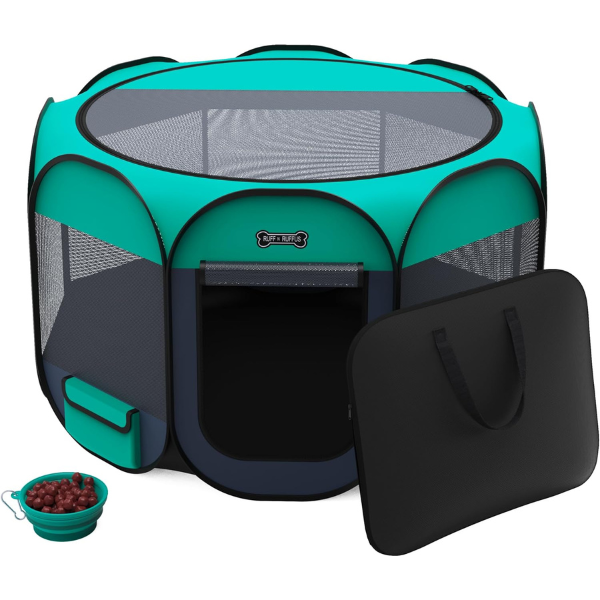
Available at:
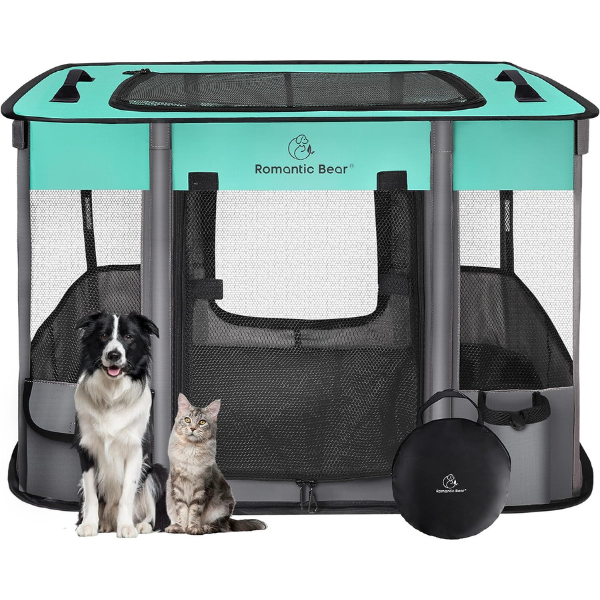
Travel Considerations for Cats With Chronic Health Issues
Before striking out on the road for a long trip or moving with a cat who has a chronic medical condition or is on long-term medications — like diabetes , hyperthyroidism , chronic kidney disease , or heart disease — there are a few precautions you should take.
- Make sure your cat had a recent (ideally within the past month or so) exam with their vet. You’ll have more peace of mind knowing that their condition is as well managed as possible and that they’re as healthy as can be before hitting the road with them. Your vet will also have recommendations for making their trip as comfortable and safe as possible.
- Bring a copy of your cat’s medical records with you! This should include recent exam notes, laboratory test results, and medication/supplement names and dosages. Your vet can often print these out (with enough notice), and they may even subscribe to an app or other service that allows you to keep updated copies of such records with you always on your phone. This will make visiting another vet on the road much easier.
- Especially for cats with known chronic health concerns, it’s a good idea to know about a few vet hospitals along your route and in the area of your destination before you head out. See the vet locator tools listed in the next emergency section to start searching.
- If your cat is on a special prescription diet, like for their kidneys, make sure to stock up on it from your vet before leaving. It’s not always easy to get prescription diet refills when you’re away from home. You should take enough with you to last for the duration of your trip PLUS an additional (at least) 2 weeks.
- Similarly, be sure to stock up on your pet’s medications and supplements, as well as any supplies you need for them. This would include needles and a travel-sized sharps container (or larger needle container ) for safely disposing of and storing used needles for diabetic cats, pills for blood pressure, overactive thyroid, and any other chronic medications. Again, you should take with you enough to last for the duration of your trip PLUS an additional (at least) 2 weeks.
- If your cat is diabetic and on insulin, don’t forget a cooler and ice packs to help keep it cool while in the car. You can also look into a cooler that plugs into your car’s cigarette lighter or USB, like these: Cooluli Mini , Wagan 14L , or the Wagan 24L (which could even store some of your food and drinks for the road). Pro Tip: Depending on the type of insulin your cat is on, you may be able to get an insulin “pen” that may be more stable outside of the fridge and easier to administer to your cat. It's still advisable to use a cooling case for the pens . Talk to your vet to see if an insulin pen is an option for your cat — it isn’t for all cats, but if it is for yours, it could be a great travel (and even long-term) solution for you.
Emergencies on the Road With Your Cat
It’s a good idea to plan ahead and map out a few 24-hour Emergency Clinics on your route, just in case. Try this vet emergency locator .
Have your hometown veterinary clinic number handy, too. For less serious issues, call them first. They may be able to give you advice or let you know if it’s a true emergency.
Make sure you have a card in your wallet or attached to your cat’s carrier with your cat’s name, the number where you can be reached during travel, and an emergency contact who is not traveling with you. If your cat has medical issues, you should list those as well or the contact info for your veterinary clinic. If there’s an accident, your car is stolen, or something happens where you’re separated from your cat, emergency services will have options.
I just got this great set for myself (featured below). The keychain says “pet home alone,” with instructions to look in your wallet for a card with emergency contact info. It’s meant to notify emergency services if you’re in an emergency situation and someone needs to care for your pet at home. In this case, you’d just include a note on the card that you’re traveling with your cat in the car.
It’s also vital to ensure your cat is microchipped and the contact information is up-to-date (including a way you can be reached on the road).
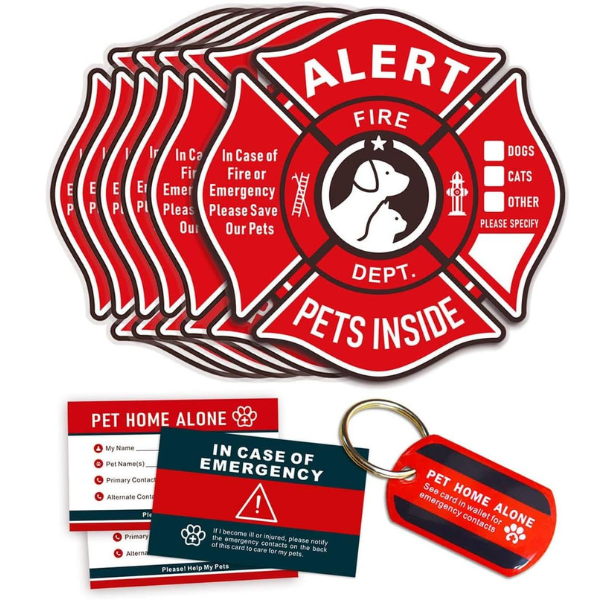
First Aid on the Road
Consider putting together a pet first-aid kit for your car. Here's a shopping list of first-aid essentials . Look for the icon of a little car 🚗, as it's these products that are the most essential in a smaller, travel-sized first-aid kit.
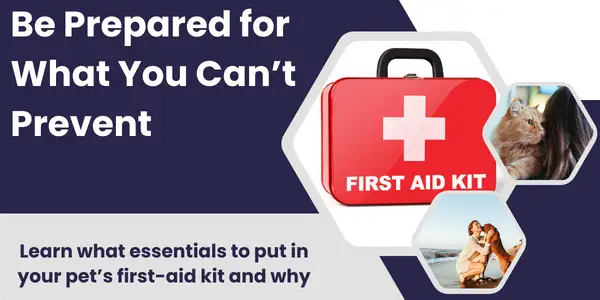
We encourage you to leave a comment below if you’ve got any tricks, tips, or products you’ve used that made car travel with your cats easier. Best of luck on your travels or your move. Have fun and be safe!
About the author

LeeAnna Buis, CFTBS, FFCP
LeeAnna Buis has adored cats her entire life and thought she knew them inside-out and sideways. But it wasn’t until she worked with a feline behavior consultant that she fully understood how incredible, complicated, and inspiring cats really are. Literally, that day, she made a career change knowing she wanted to give other cat parents the same experience of truly “seeing” and appreciating their cats. Now, she works virtually with cat parents all over the world through Feline Behavior Solutions and Preventive Vet.
LeeAnna earned her certification through Animal Behavior Institute, earning the CFTBS designation. She is a certified Fear Free® trainer (FFCP), a training professional member of the Pet Professional Guild (PPG), and a member of both the International Association of Animal Behavior Consultants (IAABC) and Cat Writer’s Association (CWA).
More about LeeAnna Buis, CFTBS, FFCP
Related Articles

7 Tips on How to Travel Better with Your Cat

dominickvietor / Pixabay
This article is sponsored by Sleepypod, makers of innovative, safety-focused pet travel products, including the Sleepypod mobile pet bed and calming harness. Click here to explore the Sleepypod store .
Whether you’re flying cross-country or moving across town, traveling with your cat can be a daunting prospect. With the right preparation, though, traveling with a feline companion can be a great experience. Some cats prefer it to staying with a sitter back home.
Key Takeaways
Cats can make great travel companions, but successful travel requires the right supplies and preparation.
A safe, high-quality carrier and secure harness are critical parts of keeping your cat safe during travel.
You can support an anxious cat using synthetic pheromones, calming treats, or a calming harness. Managing your own stress levels can also help.
1. Pick a Great Carrier
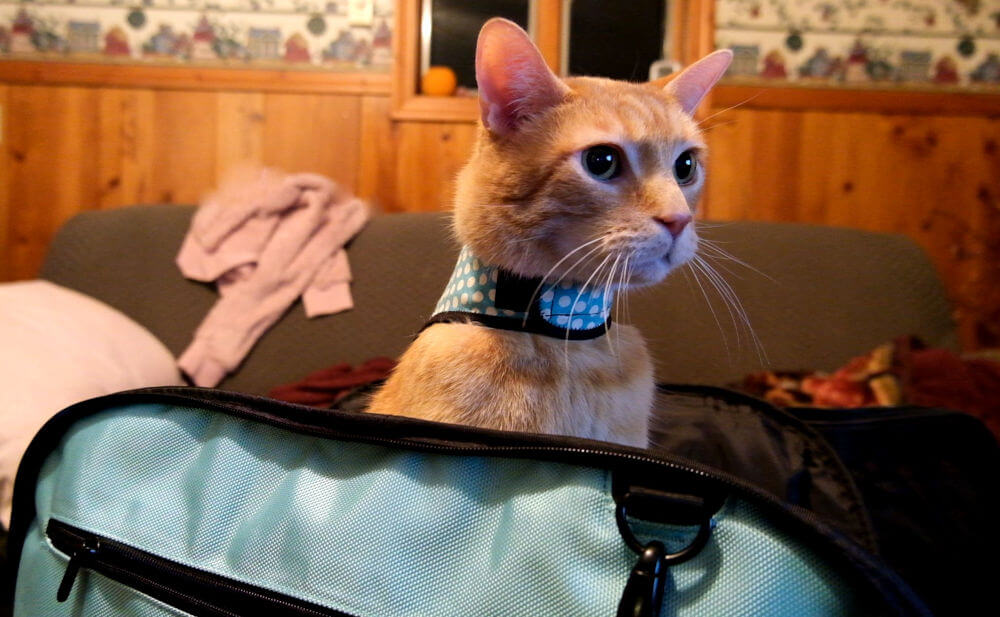
Choosing a great carrier is your first step towards a safe, comfortable journey with your cat. Mallory Crusta / Cats.com
A great carrier is an essential part of safe, successful travel with your cat. Your cat’s carrier should be well-constructed, secure, and appropriate for your mode of travel. It needs to be correctly sized so that your cat can sit, lie down and change positions comfortably.
After testing numerous carriers, we recommend Sleepypod’s products as the best on the market. This company shows a dedication to safety that goes beyond that of any other pet travel product manufacturer. Through the Sleepypod Safety Test Program, their carriers are crash-tested and certified to extend your cat’s safety in an accident. The testing meets the same standards applied to child safety restraints.
We recommend the Sleepypod Mobile Pet Bed as the best carrier for car travel and the Sleepypod Air as the best for traveling by plane. You can learn more about their carrier lineup here .
Once you have an excellent carrier, initiate a low-stress introduction, leaving it out as a bed before making any connections with the car, the vet, or vacation. Use treats to encourage your cat to explore the carrier.
2. Start Preparing Early
Successful travel with your cat starts long before you leave the driveway. While most cats are most comfortable within familiar territory, proper training from kittenhood will help them feel confident on the go.
If you anticipate travel in your cat’s future, start training them early. Take your kitten out for walks on a harness and leash, introduce them to new people, and carefully expose them to other pets. Remember that all socialization must be carefully planned and supervised to keep your kitten safe.
In the weeks leading up to the trip, make sure your cat is familiar with all of the supplies that will come out on your departure day. They should become acquainted with their carrier, harness and leash, travel litter box, and any other special accessories.
Consider getting them comfortable in the car as well—practice encouraging them into the carrier, shutting it securely, and then taking them out to the car briefly. Give plenty of praise and reward for these practice sessions to ensure your cat sees travel as a positive experience.
3. Flying or Driving? Plan Accordingly
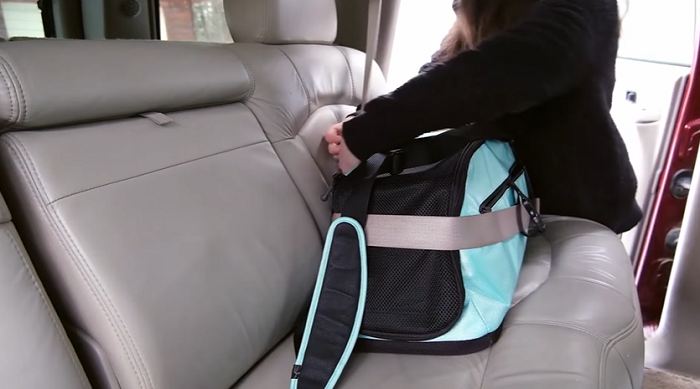
Traveling by car requires different preparation than taking a flight. Keep your travel plans in mind when preparing your cat. Mallory Crusta / Cats.com
Traveling With Your Cat by Car
Traveling by car gives you a bit more control over your schedule and your cat’s experience, allowing you to make as many stops as needed, limit your passenger list, and modify your itinerary to help your cat feel comfortable. But it comes with a few special considerations.
Use a crash-tested carrier. Strap it to the seat according to the manufacturer’s instructions, making sure that it is fully intact and ready to keep your cat safe in an accident. Once you hit the road, ensure that you have good ventilation, but watch doors and windows to prevent escape. Ensure your cat is comfortable: the base of the carrier should be level rather than tilted, and secure enough that it doesn’t move around when driving, which can exacerbate motion sickness.
Before you leave, consider turning on the air conditioner or heater to make sure that the vehicle is at a comfortable temperature for your cat. If your cat tends to get motion sickness, let your cat fast for 8-12 hours before you leave, and consider using medication as prescribed by your vet.
For more tips, read our vet-written guide to taking a road trip with your cat.
Traveling With Your Cat by Plane
Whether domestic or international, plane travel with a cat comes with some additional considerations.
Make sure that your carrier qualifies for under-seat in-cabin storage as a carry-on, checking with your individual airline to avoid any last-minute stress. We don’t recommend traveling with your cat in the cargo hold unless absolutely necessary. Again, check with your airline to confirm that in-cabin transport is an option. You’ll also want to read up on any paperwork the airline requires before a pet comes on board.
Airport security can be just as—or more—nerve-racking for cats as it is for us, so consider TSA PreCheck® to minimize time in line. The security agents will ask that you remove your cat from their carrier right before they go through the screening process, so make sure they have a harness and are ready to safely leave the carrier. Carry your cat through the X-ray machine, then return your cat to their carrier as soon as you can. Click here to read the TSA’s tips for a smooth boarding and flight experience with your pet.
Once you’re on the plane, aim for a quiet seat next to a window, and settle in for the flight. A good carrier will have a top entry door or window that allows you to pet and interact with your cat throughout your flight.
4. Create a Kitty Packing List
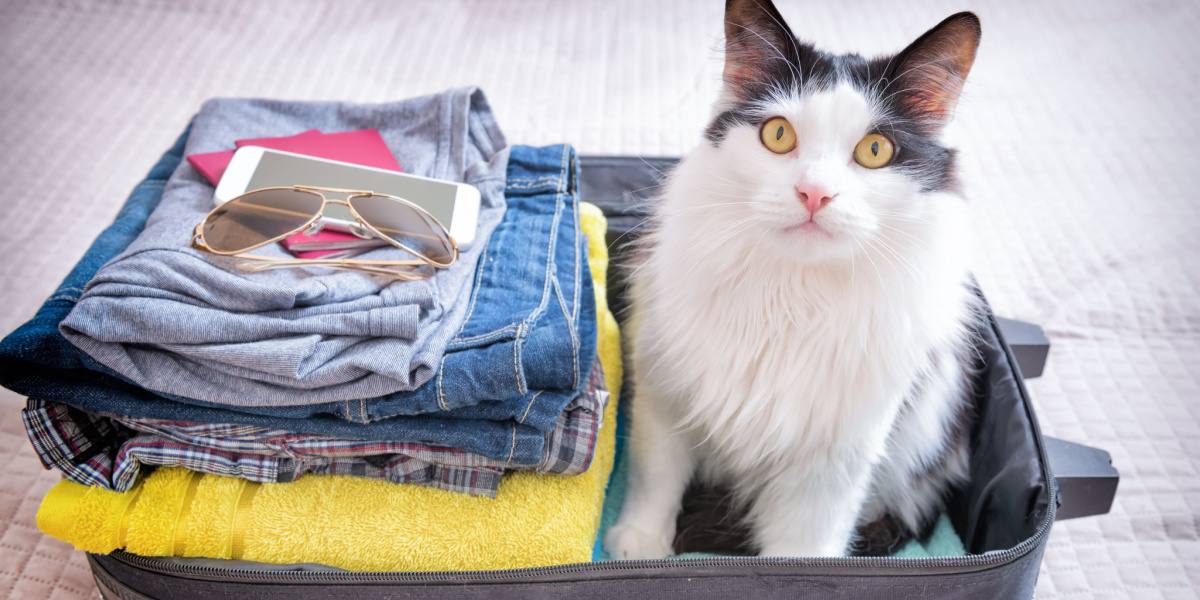
Make sure that your cat starts the trip prepared with all of their essential items. Monika Wisniewska / Shutterstock.com
In addition to your carrier, harness, and leash for safety, a few additional items should come along with you and your cat.
Make sure your cat has enough food and water to last them through the trip, and pack familiar bowls so they can eat and drink. We recommend having some extra supplies accessible, in case of travel delay. Bring a disposable litter box with your cat’s usual litter. Since accidents can happen during long travel days, line the litter box with a pee pad for safety.
Items to Pack
- Harness and leash
- Absorbent pee pads
- Medical and insurance documents including contact information for their usual veterinarian
- Vaccination certificates
- Any recent lab work that may be relevant
- Any medications your cat needs, with prescriptions from your vet
- The same food they normally eat at home
- Familiar food and water dishes
- If possible, water from home—water from other sources may taste strange to your cat
- Familiar cat litter
- A familiar blanket for comfort
- A collar and identification with up-to-date information
- A cat activity tracker, if desired
- If you’re staying at your destination for a while, a temporary ID tag with your new address may be a good idea
In addition to these essential items, check up on your cat’s records. Make sure they’ve received the latest round of essential vaccines and confirm that the information on their microchip is up to date.
5. Bring Pieces of Home
Cats connect with places by scent. Bringing items that smell like home will help your cat feel safe both during transport and at your destination. Items that tend to be saturated with your cat’s smell include blankets and bedding they sleep on, beloved toys, litter, and scratching surfaces.
When you arrive at your destination, try to create a home environment. Place the food and water bowls in a similar arrangement to that at home, and put your cat’s carrier down as a bed. Make sure your cat has a litter box full of familiar litter. If you’re traveling to visit family or friends, consider having them set up a sanctuary room before you arrive.
6. Use Calming Aids as Needed
Calming products can help to manage your cat’s stress levels during the trip. An easy place to start is with your cat’s harness. Sleepypod’s Martingale Calming Harness secures and soothes at once, wrapping evenly around the body in a way that may help alleviate anxiety.
Calming pheromone products use synthetic pheromones to make your cat feel safe and at home. Sprays or wipes may be used inside of your cat’s carrier before you leave and re-applied multiple times during your journey. A pheromone calming collar may also help.
Calming supplements are also available, but they are less well-researched and don’t show as much promise. Some cats who are very stressed may benefit from a prescription anti-anxiety medication like buprenorphine or gabapentin . Talk with your veterinarian, and be sure to do a trial run at home so you’ll know how your cat responds.
7. Be Patient!

Remember that your cat can feel and feed off of your stress. Manage your own anxiety to make the trip pleasant for your cat. Africa Studio / Shutterstock.com
Even with the calmest feline traveler, going for a trip with your cat can be stressful. For both your and your cat’s benefit, try to manage your own stress levels, and be patient!
Planning in advance and creating a rough contingency plan will help you to better cope with unexpected challenges. Once you’re on the road or in the air, don’t forget to take a deep breath and enjoy this special time with your cat.
A Final Word of Caution
Remember that travel is not right for all cats, especially ones who are shy or anxious. Don’t assume that, just because they love spending time with you, your cat will want to go on a long vacation at your side. In many—if not most—cases, they’d be much happier staying back home.
If you decide to leave your cat, a trustworthy cat sitter is usually the best low-stress alternative. Click here to read our article on whether you should board your cat or leave them at home.
Frequently Asked Questions
How do you travel long distances with a cat.
With the right preparation, your cat can join you for journeys of any length. Pack a great carrier, harness and leash, litter box, food and water, and any paperwork your cat needs. Ensure that you can stop at cat-friendly hotels along the way, and be sure to bring little pieces of home to make your cat feel safe.
How long can cats travel in a car?
At most, a cat can remain in the same space for about 6 hours. For trips longer than 6 hours, aim to take a few breaks to let your cat stretch their legs, use the litter box, and get something to drink and eat as needed.
Can a cat ride in a car without a carrier?
Cats should never travel in the car unrestrained. Besides being in greater danger in case of an accident, unrestrained cats are at a higher risk of escaping the car through doors or windows. They’re also a hazard to the humans in the car, potentially distracting the driver or getting under the pedals. Always keep your cat secured in a high-quality carrier during your trip.
More From Read of the Week

Popular in the community

One thought on “ “7 Tips on How to Travel Better with Your Cat” ”
Leave a reply cancel reply.
Your email address will not be published. Required fields are marked *
Thank you so much! This article was exactly what I was looking for when traveling with my little buddy.
We independently evaluate all recommended products and services. If you click on links we provide, we may receive compensation. Learn more .
The 11 Best Cat Carriers Tested With Real Cats In Tow
:max_bytes(150000):strip_icc():format(webp)/AnnaMejorada_Headshot1-23b67fed09cc4a25a7765665be1e6b41.jpg)
In This Article
- Our Top Picks
How We Tested Cat Carriers
Other cat carriers we tested, what to look for in a cat carrier.
- Why Trust The Spruce Pets
The Spruce Pets / Tamara Staples
With the help of real cats (and kittens!) we tested 30 pet carriers—including hard-sided and soft-sided kennels, bags, totes, and backpacks—then selected 12 top performers. All of our recommendations provide great airflow and a secure environment.
The right carrier for you and your cat will depend on your travel needs—by foot, by car, or by plane—the size of your cat, and your budget. Features like an entry door on top of the carrier can make it easier to get your cat safely inside, plus it's preferred by most veterinarians, who are more easily able to access your pet for care. We also found several carriers that have the ability to limit outside distractions, which can calm a nervous cat.
After hundreds of hours of combined testing, our favorite cat carriers are the Petmate Two-Door Top-Load Pet Kennel —which is about as lightweight and well-ventilated as hard-sided carriers get—and the soft-sided Petseek Cat Carrier , which has a strong, steel frame structure, but can still fold up for storage. Both carriers have multiple points of access, with doors on the front and top.
Best Overall, Hard-Sided
Petmate pet kennel.
Useful top-loading door
Made with recycled materials
Easy to wipe clean
Lightweight and airy design
Not recommended for pets over 20 pounds
Top latch sometimes misaligns
The best cat carrier for most is one with a rigid design because it provides a cat with a defined interior space. Our top choice among the hard-sided options we tested is the Petmate Two-Door Top-Load Pet Kennel, which has a traditional front door plus a top-loading door, both with gates that securely shut with a dual-spring-loaded latch.
The unwavering structure provided by this carrier will help your cat feel secure—a top priority—but only if you can first get your cat inside. The top door simplifies the obstacle of getting a cat into a carrier by limiting their opportunity to wriggle out before the door is fully shut. And from our experience, we've learned that most vets prefer a cat carrier with a top door because it makes their job easier. Here are more ways you can reduce stress on your cat while traveling .
Like any hard-sided cat carrier, the Petmate Two-Door is big and boxy, making it cumbersome to lug around, but it's also surprisingly light, thanks to thin plastic—though it never feels flimsy—and lots of ventilation holes, which keep it airy inside. The larger 24-inch model weighs 6.4 pounds and the 19-inch version weighs 3.8 pounds, without cats inside. And even with an adult cat inside, we found it relatively easy to take in and out of cars or walk short distances.
Our only structural concern is the handle, which is attached to the top door, meaning the weight of the carrier puts pressure on the hinges and steel latch. But while we noted it as a potential design flaw, the door has been reliably secure through more than a year of use. The steel wire latch to the top door is sometimes a little hard to align, but it's also easy to tell when you've securely closed it.
The Petmate Two-Door is made from recycled materials, with surfaces that are easy to wipe clean. The larger option is designed to carry cats up to 20 pounds, making it appropriate for use with most adult cats. Though it's not recommended, in a pinch we were able to safely use the carrier with two adult cats for a quick trip to the vet. Another of our testers used the Petmate carrier as a temporary den for a foster cat.
Dimensions: 19.4 x 12.8 x 10 inches (small), 24.1 x 16.8 x 14.5 inches (medium) | Weight Limit: Pets up to 10 pounds (small), up to 20 pounds (medium) | Weight of Carrier: 3.8 pounds (small), 6.4 pounds (medium)
The Spruce Pets / Jessica Juliao
Best Overall, Soft-Sided
Petseek extra large cat carrier.
Suitable for larger cats
Foldable for storage
Lockable zippers to prevent cat from opening from the inside
Top, side, and front door entry
Machine washable floor cover
Includes exterior pocket and seatbelt loop
Fabric sides are vulnerable to cat claws
If you have a large cat, like a Maine Coon or a Ragamuffin , or more than one adult cat in your care, the Petseek Extra Large Cat Carrier will help you keep your kitty comfortable while in transit. The interior is big enough to hold and support up to 55 pounds, and then easily fold up and put away until the next time you need to move your cat. We found the carrier easy to carry using the included shoulder strap.
Similar to a traditional hard-sided kennel, this carrier has a rectangular shape, but unlike the traditional cat carrier, this one can be collapsed and folded almost completely flat. The soft-sided carrier has a steel frame, with two cross beams that come apart in the middle for folding.
There are three doors, one on top, one on the side, and another on the front, which has a mesh screen that can be rolled up so that the carrier can be used as a little cat house. The double zippers at each entrance are accompanied by an additional clip that lets you lock the zippers together so that they can't be opened—a thoughtful feature that helps keep the multiple access points easy to secure. There is also a leash tether inside for further security.
The carrier is available in blue or grey, and can be used as a car seat for your cat with straps designed to attach to a seatbelt. A fleece bed is also included which is easy to remove for cleaning.
Dimensions: 24 x 16 x 16.5 inches | Weight Limit: Pets up to 55 pounds | Weight of Carrier: 6.4 pounds
The Spruce Pets / Dylan Thompson
Best Airline-Approved
Away the pet carrier.
Removable and washable bed
Crash test certified by the Center for Pet Safety for use as a pet car seat and approved for use in-cabin on most commercial airlines
Durable, water resistant construction
Top door and side door entry
Does not provide sufficient space for larger cats
Does not collapse for storage
The Away Pet Carrier is the most expensive cat carrier on our list, but this multi-use bag will serve you well for years, especially if you fly or travel often with your cat. Plus, there's a 100-day trial period, so you can test out the Away Pet Carrier for yourself.
The Away carrier meets the requirements for use in-cabin on most commercial flights (since requirements can vary from airline to airline, always check with your flight provider in advance). While suitable for flights, the Away carrier is also safe for car travel. It received a five-star crash test rating certification from the Center for Pet Safety , a nonprofit that conducts independent crash tests on travel products designed for cats and dogs.
This carrier is a structured soft-sided bag that holds its shape when empty and does not collapse for storage. It offers two zippered entry points, one on top and one on the side, and the doors are made of dark mesh. There is also an optional privacy panel to isolate your cat from outside distractions if they're too nervous.
Inside you'll find a plush, padded bed that can be removed and machine-washed. It has a water resistant lining, making it easy to wipe the interior clean. There's also a built-in safety collar clip, a key clip in the external pocket, and even a removable name card.
The Away carrier also has a variety of features for carrying and securing, including dual hand straps, a removable shoulder strap, a trolley sleeve for rolled luggage, and latches for attaching to a car seatbelt.
Away's The Pet Carrier is available in two colors, black or coast (a grayish shade of blue).
Dimensions: 18.7 x 10.8 x 10.8 inches | Weight Limit: Pets up to 18 pounds | Weight of Carrier: 3.9 pounds
The Spruce Pets / Alessandra Amodio
Travel + Leisure / Alessandra Amodio
We Also Like
Travel cat the transpurrter calming cat carrier.
Roomy enough for larger cats
Durable and sturdy
Blackout side panel to help keep cats calm
Multiple ways to carry
Too large to fit under seats of some airlines
Crossbody carrying is awkward
The soft-sided Transpurrter Ultimate Calming Convertible Cat Carrier from Travel Cat is a spacious and comfortable for cats of all sizes, and it is loaded with thoughtful design features to help make flight days less stressful.
The carrier is roomy enough for larger cats to move around, stretch, and chill out. It features a blackout panel that can be rolled up or down as needed, helping to keep your cat calm and giving them the privacy they need to relax outside of the home. Plus, there are five different ways to carry this bag—as a backpack, with a shoulder strap, cross-body (although we found it a bit awkward to carry it this way), by the handle located on the top of the bag, or on top of your suitcase secured with the built-in safety strap.
Other features we like include the "escape-proof" zippers that are virtually impossible to unzip from the inside, the slide-out bottom that has a waterproof lining, the removable soft-lined insert, eye-level peepholes, two slip pockets, and a zippered pocket with interior organization and a key clip. If opened via the top, the entire fourth wall can be put down, and the bag has a tether leash, which gives your cat room to stretch out on long layovers. But the carrier might not fit as easily as others on our list in the space under the seats of all airlines.
Dimensions: 19 x 11 x 10.5 inches | Weight Limit: Pets up to 30 pounds | Weight of Carrier: 3.31 pounds
Best Budget
Frisco plastic pet kennel.
Two doors (front and top) for easy entry
Made with 95% pre-consumer recycled plastic content
Lightweight with ventilation throughout
The top door does not stay propped open on its own
The Frisco Two-Door Top-Load Plastic Pet Kennel is an excellent choice for anyone in search of a classic hard-sided cat carrier at an approachable price.
Similar to our pick for Best Overall, Hard-Sided ( the Petmate Two-Door Top-Load Pet Kennel) , this carrier can be awkward to carry, but it will provide your cat with a secure mobile den for any essential trips, like visits to the vet. This carrier offers the convenience of top door entry too. Our cat tester for this carrier, a 15-pound Maine Coon , opted to take a few naps inside, so we think the trips they took in this carrier were enjoyable.
The lightweight case comes in two sizes, extra-small and small, and is made with 95 percent pre-consumer recycled plastic. There are ventilation slits throughout and you can easily add a blanket to make the inside a bit cozier for your cat. It's available exclusively at Chewy.
Dimensions: 19 x 12 x 10.1 inches (extra-small), 24.1 x 16.8 x 14.5 inches (small) | Weight Limit: Pets up to 10 pounds (extra-small), up to 20 pounds (small) | Weight of Carrier: 5.7 pounds (extra-small), 6.4 pounds (small)
The Spruce Pets / Jennifer Joanning
Best Budget Airline-Approved
Maskeyon airline approved pet carrier.
Top and side entry through zippered panels
Expandable mesh covered sides
Padded shoulder strap and padded mat included
We found the carrier difficult to move with the extensions open and a cat inside
The Maskeyon Airline Approved Carrier can be used on most commercial flights to keep your cat cozy and secure while they ride under a seat (always check with your flight provider). It may look like other duffle bag style carriers, but on two sides, this carrier has expandable mesh panels that can be unzipped to give your cat room to stretch while you wait to board. These built-in sections will nearly double the amount of space your cat has to move around without adding any bulk or weight.
We found the carrier easy to carry with the padded shoulder strap, and a removable padded mat inside kept our cat comfortable. The carrier's interior and exterior are very breathable and easy to wipe clean. It also offers entry through a zippered top panel and side panel making it easier to get your cat in and out.
Dimensions: 19.5 x 12 x 12 inches, with expansion 43.5 x 32 x 12 inches | Weight Limit: Pets up to 20 pounds | Weight of Carrier: 3.6 pounds
Petsfit Small Soft Cat Carrier
Expandable mesh side offers more room
Outside materials easy to clean
Various ways to carry
Liner might be hard to clean
The Petsfit Cat Carrier provides multiple ways for you to carry your cat comfortably when traveling, including a long strap you can put over your shoulder, two flexible handles, and a side strap you can attach over the handle of your own rolling luggage. It has a self-locking zipper and a leash tether ti attach to a collar to ensure that your furry friend can't escape.
We like the expandable mesh side that allows a cat to stretch out further when in the car or on the plane. This carrier fits easily under a standard airplane seat and with two mesh windows, your pet can peek out and you can peek in. The exterior is composed of mesh along with oxford cloth (a blend of polyester and cotton) that is easy to clean. Plus the soft liner inside is removable and can be spot cleaned or washed by hand.
Dimensions: 16 x 10 x 9 inches, with expansion 17.3 x 16 x 9 inches (small), 17 x 11 x 11 inches, with expansion 20 x 17 x 11 inches (medium) | Weight Limit: Pets up to 9 pounds (small), up to 13 pounds (medium) | Weight of Carrier: 2.1 pounds (small), 2.5 pounds (medium)
Best Backpack Carrier
Halinfer space capsule cat backpack.
Easy to carry as a backpack with mesh pocket on the side for storage of small items
Bubble viewing window on the front with expandable mesh encasement on the back
Leash tether inside to keep cat securely contained
Air holes throughout for air circulation
Difficult to get adult cats to use the small side door
With the Halinfer Expandable Space Capsule Cat Backpack, you'll keep your hands free while you comfortably transport your cat on your back. As a backpack, most adult cats will have to sit upright, but with the expansion open, a full-grown cat will have room to spread out. The front viewing window is made out of plastic and resembles a bubble. It's clear with air holes to allow your paw-ssenger to see and smell the environment around them.
There are additional air holes along the perimeter with a mesh pocket for storage on one side and a zippered door on the other side. Ideally, your cat will have no issue with entry through the side door, which was the case with our two kittens, but our two adult cats were not as easy to get inside. If needed, the front clear bubble portion of the carrier can be unzipped giving you more space to calmly get your cat inside.
When you arrive at your destination, you can unzip the mesh expansion to let your cat spread out while keeping them safely contained. There is also a built-in tether to attach to your cat's collar or harness to keep them securely inside. Some cats are excellent escape artists, so better to be cautious.
Dimensions: 15 x 10 x 7 inches | Weight Limit: 12 pounds | Weight of Carrier: 2.5 pounds
The Spruce Pets / Jordan Davidson
Best Electronic Backpack Carrier
Petkit pet backpack carrier.
One year warranty from manufacturer
Built-in LED light makes it easier for your cat to see at night
Side pocket designed to carry a power bank
Fan and ventilation system help to regulate your cat's temperature
Power bank not included
The back of the backpack is soft so on occasion movement would push and disturb the cat inside
Give your cat a tech-powered transport with the Petkit Pet Backpack Carrier. Designed for ultimate comfort, this bubble backpack has a built-in fan and ventilation system to facilitate airflow. There is also an LED light inside that gradually gets brighter as the environment gets darker to help your cat see. These advanced features require a power bank which is not included, but there is a built-in pocket to hold the power bank of your choice (we recommended the Anker Slim 1000 Portable Charger ).
The outward-facing bubble viewing window is made of durable plastic and the outer shell is available in three colors—white, blue, and green. The build of the exterior feels substantial but may get scuffed over time with use. The back of the satchel, the part that connects with the shoulder straps, is padded and soft. We found it comfortable to wear with our participating cat inside. However, the pad is pliable so your cat will be able to feel your movement which we found would occasionally disrupt our cat during our journey.
The backpack is recommended for cats up to 17 pounds and weighs three pounds on its own. It also comes with a one-year warranty from PetKit.
Dimensions: 13 x 12 x 18 inches | Weight Limit: Pets up to 17 pounds | Weight of Carrier: 3 pounds
The Spruce Pets / Elise Wojczyk Wang
Best Budget Backpack Carrier
Henkelion cat backpack carrier bubble bag.
Available in seven colors
Padded shoulder straps and chest strap for weight distribution of carrier
Zippered entry through side mesh door or front bubble
Leash tether and removal pad inside
Too small for larger cats (maximum weight of 10 pounds)
The Henkenlion Cat Backpack Carrier Bubble Bag is affordable and comfortable to wear, but if you have a bigger cat (10 pounds or more), this carrier might not offer enough space. We wore the carrier with a nine-pound feline inside and they seemed comfortable, but we would not want to keep a cat that size inside this backpack for a long excursion.
The front of the backpack is made of clear, round plastic so you can see your cat and they can see the world around them. There are holes for air ventilation on the front and on the sides of the carrier along with a mesh pocket. Inside you'll find a removal pad and a leash tether to keep your cat securely attached to the carrier. The shoulder straps are padded and adjustable, and there is also a chest strap for extra support and weight distribution.
Dimensions: 12.2 x 11.4 x 16.5 inches | Weight Limit: Pets up to 10 pounds | Weight of Carrier: 2.91 pounds
The Spruce Pets / Lydia Price
Best Collapsible
Sportpet designs travel cat carrier.
Folds and unfolds easily for travel and storage
Extra large sized carrier can accommodate more than one cat, up to 40 pounds
Extra large carrier sold out at time of publish
If you are looking for a reliable cat carrier that doesn't take up a lot of storage space, the SportPet Designs Foldable Travel Cat Carrier is the one for you. This hard-sided carrier offers the stability of a classic rectangular kennel without having to dedicate as much closet space.
The triangular shape of this carrier reminds us of a classic A-frame house, but the sides are not perfectly symmetrical. With this unique shape, the carrier is able to offer a sturdy yet comfortable space for a cat, but it's also easy to collapse and fold when it is not in use. For safety, the frame of the carrier locks in place with two latches and two red-colored clips. The carrier is made out of steel and plastic for durability and is available in two sizes, extra large and large. The biggest version of the carrier can support more than one cat with a maximum weight of 40 pounds.
Dimensions: 25 x 20.2 x 19 inches (extra-large) | Weight Limit: Pets up to 40 pounds (extra-large) | Weight of Carrier: 6.4 pounds (extra-large)
The Spruce Pets / Emma Wenninger
Best Roller
Gen7pets geometric roller with smart-level pet carrier backpack.
Telescopic handle and wheels make this carrier easy to transport
Can also be carried as a backpack with adjustable padded shoulder straps
Leash tether inside along with removable cushion for cleaning
When used as a roller, some cats may find the tilt of the carrier unsettling
One of humanity's greatest inventions, the wheel, can be put to good use by helping you transport your cat with the Gen7Pets Geometric Roller with SmartLevel Pet Carrier Backpack.
This roller bag has a telescopic handlebar that is easy to pull up and put down. The carrier is also equipped with adjustable shoulder straps for use as a backpack keeping your hands free. There are two zippered panels made of mesh that can be used for entry or as windows. If you do want to give your cat a taste of freedom while they stroll, there is a leash tether inside that can be latched to a collar or harness. This will keep them securely attached to the carrier while they poke their head out of an unzipped window.
The carrier comes in two sizes, large can hold up to 20 pounds while medium maxes out at 10 pounds. We found the medium-sized carrier easy to use as a roller and a backpack, but when we tried to pull the carrier like a suitcase, our cat was startled by the tilt of the carriage.
Dimensions: 11.5 x 19 x 18.5 inches (medium) | Weight Limit: Pets up to 10 pounds (medium) | Weight of Carrier: 6.8 pounds
Final Verdict
Our best overall, hard-sided cat carrier is the Petmate Two-Door Small Dog & Cat Kennel , which offers structured support, excellent ventilation, and two entry doors—including one on top. Our favorite soft-sided carrier is the Petseek Extra Large Cat Carrier , which provides a stable yet mobile den for a cat and can be folded for storage.
In total, we tested 30 different cat carriers, including hard-sided and soft-sided kennels, bags, totes, and backpacks. We purchased each cat carrier and sent it to a volunteer's home, along with a written methodology that guided them from setup through long-term testing.
Testers first documented the ease of setup and their cat's initial reaction to the carrier, taking photos along the way. Testers then evaluated each carrier's quality for themselves, exploring features and functionality, recording their thoughts, and answering a bevy of questions.
After three weeks of use incorporating the carrier into their routine, each tester provided detailed feedback and numerical scores across four categories: performance, portability, quality, and value. Additionally, each cat carrier will remain with the tester for ongoing insights.
Equipped with this first-hand information, we ranked and categorized our top picks to simplify your search for the purr-fect cat carrier to suit your needs, habits, and preferences.
Sherpa The Original Airline-Approved Deluxe Pet Carrier : With a soft fleece liner and mesh ventilation throughout, this carrier provides a cozy and airy space for a cat, but it's better suited for small cats. Our 7-pound feline participant had plenty of space, but cats over 12 pounds would likely find the airline-compliant sizes of this carrier to be a snug fit. Sherpa offers larger version of the The Original Deluxe Pet Carrier , and if you don't plan to fly with your cat, this might work for you.
Wild One Pet Carrier : This airline-compliant carrier is a solid choice with a lot of useful features, including a padded mat that expands, storage pockets, and the ability to unzip each section. We put this carrier in the same category as Away The Pet Carrier , our choice for Best Airline-Approved , and ultimately the Away Pet Carrier, with a five-star certification from the Center for Pet Safety came out on top.
Morpilot Cat Carrier Backpack : While testing this backpack, our cat participants felt at ease riding inside—even playing hide and seek in the carrier while at home. Ultimately, the carrier's boxy shape and the fact that it doesn't have an optional expansion component put it behind our Best Backpack Carrier selection, the Halinfer Expandable Space Capsule Cat Backpack .
Look for easy-to-clean surfaces, recommends Registered Veterinary Technician and professional dog trainer (KPA-CTP) Jaime Lyn Bast. "Lingering odors will be offensive to your cat," she says. Check to see if any removable fabric or foam padding is machine-washable.
“The safest carrier is made of sturdy plastic with access doors on the top and the side. A rigid carrier protects your cat from any external impact,” Bast told The Spruce Pets. “Cats are easily stressed by jostling and disturbances during transport, and hard-sided cat carriers make it easier to maintain consistent, level support."
The carrier must be large enough for your cat to stand up and turn around comfortably, but small enough that they feel secure and avoid excessive movement during the ride she says.
The ideal cat carrier should also have easy-to-use latches or zippers, according to Bast. "You should be able to open the crate easily with one hand."
Opaque Sides
"A visual barrier helps your cat feel protected from outside threats," says Bast. If you have a rigid carrier cage with a lot of places to look out, can also try covering it with a sheet or towel to help your cat feel secure.
“Ideally, you should train your cat to become comfortable with their carrier by leaving it out and placing blankets, toys, and treats inside. Once your cat forms a positive association with the carrier, you can entice them with treats to willingly enter,” suggests Bast. “However, if you have not had a chance to train your cat, or they do not voluntarily enter their carrier, you will have to place them inside."
Cats commonly resent their carriers due to pain and fear associated with improper loading she says. Always handle your cat gently and calmly to prevent panic. "When lifting your cat, support their body to avoid causing fear or discomfort. Gently lower your cat inside the carrier from above or, if using the side door, guide them in backwards (i.e., rear-end first). If your cat struggles, you can wrap them snugly in a towel, slide them inside like a swaddled baby, and then unwrap them.”
“Your cat will be comfortable in their carrier if they identify it as an extension of their territory,” notes Bast. “To achieve this, the carrier must be a predictable part of the home and an attractive hangout for your cat." Here are her training tips:
• Place the crate near your cat’s favorite resting spot.
• Remove the top and door initially, if necessary.
• Place a cozy blanket inside the carrier, sprayed with a synthetic feline pheromone to attract and calm your cat.
• Periodically place toys and treats inside the carrier for your cat to discover.
• Feed your cat near, and then inside the carrier.
• Close the door briefly with your cat inside, then open the door.
“Gradually increase the time your cat spends in the carrier, so long as they remain calm,” says Bast. “If your cat panics, take a step back and progress more slowly.”
To help your cat remain calm during veterinary visits:
• Do not feed your cat in the hours preceding a car ride to prevent nausea.
• Drape a towel misted with feline pheromones over the carrier to create a visual barrier.
• Keep the carrier elevated on a chair or counter, and away from curious dogs.
“Cats should never travel loose in the car," explains Bast. "Unrestrained cats may distract the driver, impede driving, and risk severe injury, escape, or death in an accident." Cat carriers for car travel should keep your pet in a secure carrier on the floor behind the driver's seat. This location provides better security and stability during a sudden stop, turn, or collision, she says. “Carriers placed on the backseat may be tossed about on the ride or fall off the seat, distressing and potentially injuring the cat.”
Why Trust The Spruce Pets?
This roundup was written by Anna Mejorada , a writer for The Spruce Pets, with hundreds of hours of experience testing pet products, both in our labs and at home. Before researching and writing about pet products for a living, Mejorada embarked on a self-mandated, ongoing quest to find the optimal items for her dog, a happy Pomeranian named Gidget. She is now delightfully devoted to helping humans discover and select the most favorable products for their pets.
A previous version was written by Lorraine Wilde who has had at least two cat companions in her home for the past 35 years including some special needs kitties.
We also consulted with Jaime Lyn Bast, a Registered Veterinary Technician and professional dog trainer (KPA-CTP) with over 10 years of technician experience.
More from The Spruce Pets
- The Best Cat Carrier For Road Trips Is Crash Test Certified
- The 11 Best Dog Carriers of 2024, Tested and Reviewed
- The 8 Best Dog Backpack Carriers Tested With Real Dogs
- The 6 Best Backpack Cat Carriers of 2024, Tested and Reviewed
- The 7 Best Dog Bike Baskets for Your Small-Breed Passenger
- The 10 Best Dog Crates of 2024, Tested and Reviewed
- The 8 Best Dog Car Seats and Restraints, Tested With Real Dogs
- The 6 Best Airline-Approved Pet Carriers of 2024, Tested and Reviewed
- The 9 Best Dog Pens of 2024, Tested and Reviewed
- The 11 Best Travel Water Bowls for Dogs, Tested by Our Experts And Real Dogs
- The 10 Best Dog Seat Covers Tested With Real Dogs
- The 5 Best Wagons for Outdoor Adventures With Your Dog
- The 13 Best Cat Litter Boxes, Tested With Real Cats
- The 5 Best Dog Crates for Puppies, Tested and Reviewed
- The 10 Best Dog Houses For Any Environment
- The 11 Best Cat Trees, Tested With Real Cats
- Weird But True
- Sex & Relationships
- Viral Trends
- Human Interest
- Fashion & Beauty
- Food & Drink
trending now in Lifestyle

Lawyer hoping to become oldest Miss Universe contestant — at 60

A really scary breed of men are emerging: Jana Hocking

Fitness influencer reveals haters' cruel comments about her body

6 ways you can change your life tonight for a happier tomorrow:...

Daily showers are purely 'performative' and have no real health...

We quit the 9-to-5 grind to live on a $125K yacht in Greece with...
Male Ozempic users reporting awful sexual side effect: 'Say...

Couple accidentally ships pet cat in Amazon return box, stunning...
Fitness expert shares 5 yoga and pilates exercises to help release stress from your body.
Thanks for contacting us. We've received your submission.
With Mental Health Awareness Month recognized in May, a fitness expert is sharing the best ways to reduce stress.
Kristina Rudzinskaya is a California-based certified Pilates instructor and founder of Etalon, a posture bra brand.
Rudzinskaya has multiple certifications in Pilates and proper body form — and shared with Fox News Digital the best poses for those looking to relieve stress at this time of year (or any time).
“Next time you feel stressed, remember to stand tall, breathe deeply and let Pilates work its magic on both body and mind,” she said.
Rudzinskaya connected good posture with releasing stress — and said aligning “our bodies properly during Pilates practice [can help] activate deep, stabilizing muscles, release tension and improve circulation.”
Try these simple poses at home for stress relief.

1. Child’s pose
One of the top recommended poses to help with relieving stress is the child’s pose.
“This classic post stretches and lengthens your spine, glutes and hamstrings — and is a great position to meditate,” she said.
The position allows the body to relax while also stimulating the parasympathetic nervous system, said Rudzinskaya.

2. Cat-cow pose
“The cat and cow exercise engages the core muscles, which helps stabilize the spine and improve posture,” Rudzinskaya said.
The Pilates instructor said the pose has a calming effect on the nervous system when paired with synchronized breathing — which promotes relaxation.
3. Side plank
Holding a side plank helps with core strength and can align the muscles along your sides and glutes, Rudzinskaya said.

“[It] provides a solid foundation to support your back and improve posture … Combined with mindful breathing, this pose aids in stress release and relaxation while also presenting a symbol of stability and steadiness,” she noted.
Side planks can vary in difficulty level; you can hold your entire body up or place your knees on the ground for an alternative.
4. Superman pose
Lying flat on the floor with your arms above your head and lifting your arms and legs in the air at the same time is considered the superman pose.
Rudzinskaya said the movement “strengthens spinal muscles, promoting better alignment and posture.”

She continued, “Holding the pose builds back strength, fostering an extended body position — which helps feelings of confidence and self-esteem.”
5. Chest stretch
The last pose Rudzinskaya recommended is a chest stretch for those who tend to sit a lot during the day.
“This stretch fixes the hunched posture from sitting a lot, encouraging a more open stance,” she said.
She added, “It relieves upper body tension caused by desk work or screen time — promoting relaxation through deeper breaths and an expanded chest.”
Share this article:

Advertisement

COMMENTS
Find the largest selection of pet supplies including pet food, toys, treats & supplements. Discover new arrivals, and explore wide selection feature brands, new and specialty finds.
6. Planning. Image Credit by: Piqsels. When it comes to traveling with two cats, planning the trip properly is the most important thing that you can do. Before you set out, carefully plan your ...
Tip#8 - prepare a list of food and other supplies you need to have while travelling long distances with cats, and buy them in advance. Tip#9 - while travelling long distances the person who your kitties are most attached to should stay as close to them as possible. Tip#10 - control the temperature in the car, particularly if you are ...
You should also ensure you have extras of your cats' records. Make multiple copies, keeping at least one copy with you all the time. Image by: sophiecat, Shutterstock. 12. Promote Calmness. Traveling with both of your cats is likely going to be stressful for you, no matter how easily the planning and trip go.
Here, we go over tips for traveling with two cats to help you make the best of your trip. The 7 Tips on Traveling With Two Cats 1. Bring along your cats' favorite toys and treats. You should pack plenty of treats and toys to keep your cat distracted, busy, and happy during your travels. The longer the trip, the more important this is.
Consider traveling with your cats in-cabin in one carrier. Most pet travel fees range from $90 to $200 per pet or per carrier. Many airlines allow two cats to share one carrier if they're under 14 kilograms (31 lb). Review your airline's animal travel regulations for more information. 2 adult animals that weigh less than 14 kilograms (31 lb ...
Traveling with cats can be a daunting task, but this comprehensive guide, including 36 actionable tips, makes it easier. Learn to navigate weather restrictions, reduce travel stress, and utilize professional pet shippers for a safe and hassle-free journey. It's the ultimate resource for pet parents on the move.
Attach leashes to cats underneath carriers as a precaution before opening doors to board the plane. Politely explain to the gate agent you are traveling with two cats and request aisle seats near the front. Place one cat under your seat and the second under your travel companion's seat. Stow carriers.
Flying with two cats can feel like a daunting task, but it doesn't have to be. As someone who craves freedom and adventure, I understand the desire to bring our furry companions along for the ride. With some careful preparation and planning, traveling with your cats on a plane can be a stress-free experience for both you and your feline friends.
1 Tips for flying with your cats internationally. 1.1 Before you travel with your cat internationally. 2 Traveling on the plane with your cat. 3 Once you arrive at your destination with your cat. 3.1 Traveling internationally with multiple cats. 3.2 Why you should consider NOT putting your cat underneath the plane.
Traveling with two cats can be a daunting prospect, but with the right approach, it can be stress-free for both you and your feline companions. From ensuring
The pet and the carrier must not exceed 40 lbs. American Airlines: Two cats per kennel allowed. United Airlines: One adult cat per kennel. Pet air travel still has a few exceptions. Even if the airline allows two small cats in the same carrier, the airline could refuse to allow your pets to travel together.
75 - €400. Contact the airline for quotes. British Airways. It is possible to fly with a cat up to 6kg on a SUN-AIR franchise partner. Contact the airline for quotes. Typically starts from €330 but varies depending on distance, size and destination. Contact the airline for a quote. Virgin Atlantic.
Traveling with two cats can be a challenge, but it's definitely doable. Here are a few tips to help make the trip go smoothly. 1. Make sure your cats are comfortable with each other. If they're not used to being together, they may get into a fight. 2. Get them used to traveling in a carrier. This will help keep them safe and secure on the trip.
If your cat has a medical condition that necessitates more frequent litterbox usage, take advantage of the many disposable cardboard litterboxes that are available. Fill plastic bags with portions of litter to fill boxes as needed. If possible, toss the box once your cat is done with his bathroom break — otherwise, store it in an airtight bag ...
As a cat lover and a frequent traveler, I know firsthand how challenging it can be to embark on a long-distance car journey with feline companions. Traveling with cats requires proper planning and preparation to ensure a safe and stress-free experience for everyone involved, and it can be particularly challenging with two cats.
Make sure your vet gives you enough gabapentin to try it out before you travel. Ideally try it far enough in advance if it doesn't work well for your cats you can adjust dose or try another medication. Good luck with your move. Please please keep your cats in the cabin with you, if you can.
Image Credit: Creative Cat Studio_Shutterstock 2. Give Your Cat Time to Get Used to Their Carrier. Because cats spend so much time in their carriers when traveling, they must feel comfortable in them.
Here are my top six tips for traveling long-distance with two cats in the car: Get your cat carrier (s) early. The earlier you get your cat carrier (s), the faster you can let your cats start exploring it. Whether you opt for one or two cat carriers, let your cats explore the new space in your home first.
Place the carrier inside the car then get in the car with your cat and close the door. Let your cat explore a little bit and sniff around. To help your cat form a positive association with the car and with the crate, toss some treats into it for him to find or start feeding him his meals in the carrier.
For trips under 2 hours, you won't need to feed your cat on the road. Otherwise, feed it every 2 to 3 hours. Your cat may not want to eat or drink while traveling. Don't feed your cat while moving in your vehicle, as there are risks that it could choke, become sick, or get loose in the vehicle. If you need to feed your cat en route, stop first.
Step 2: Get your cat feeling comfortable in the car. Now that your kitty feels better in their carrier, it's time to help them feel comfortable in the car. Here are some steps to help you do that. Pro Tip: Car acclimation is best done with two people … one to drive the car, the other to pet, praise, and treat kitty.
Traveling with pets in-cabin is only allowed for cats and dogs when there's space available. Each customer can travel with up to two pets. If you're traveling with two pets, you must purchase two seats on your flight. Your second seat needs to be next to your assigned seat so you can care for both pets.
2. Start Preparing Early. Successful travel with your cat starts long before you leave the driveway. While most cats are most comfortable within familiar territory, proper training from kittenhood will help them feel confident on the go. If you anticipate travel in your cat's future, start training them early.
Traveling with two cats. I live halfway across the country from my family and want to go home to visit within the next few months. I have two cats and really want to bring them with me, I'm just not sure how. I've flown and driven places with my smaller older cat before and she did ok with a 4 hr flight and 8hr drive but never with my ...
Traveling with 2 cats & 1 dog. Need advice. Pets We will be driving from FL to MD at the beginning of June. My spouse will be driving the truck, and I'll be following in our vehicle with 2 kids, 2 cats, and 1 energetic dog. I have so many questions. I'm trying to make this trip as stress-free as possible for everyone.
The best cat carrier for most is one with a rigid design because it provides a cat with a defined interior space. Our top choice among the hard-sided options we tested is the Petmate Two-Door Top-Load Pet Kennel, which has a traditional front door plus a top-loading door, both with gates that securely shut with a dual-spring-loaded latch.
After getting our orange tabby cat, Norbert, in 2018, my husband and I quickly realized we needed to invest in an automatic dry food feeder if we ever wanted to sleep past 6 a.m. again.
Texas flight attendant reveals best travel tips for stress-free summer flights Pets may need to wait weeks, months for care amid US veterinarian shortage ... 2. Cat-cow pose "The cat and cow ...